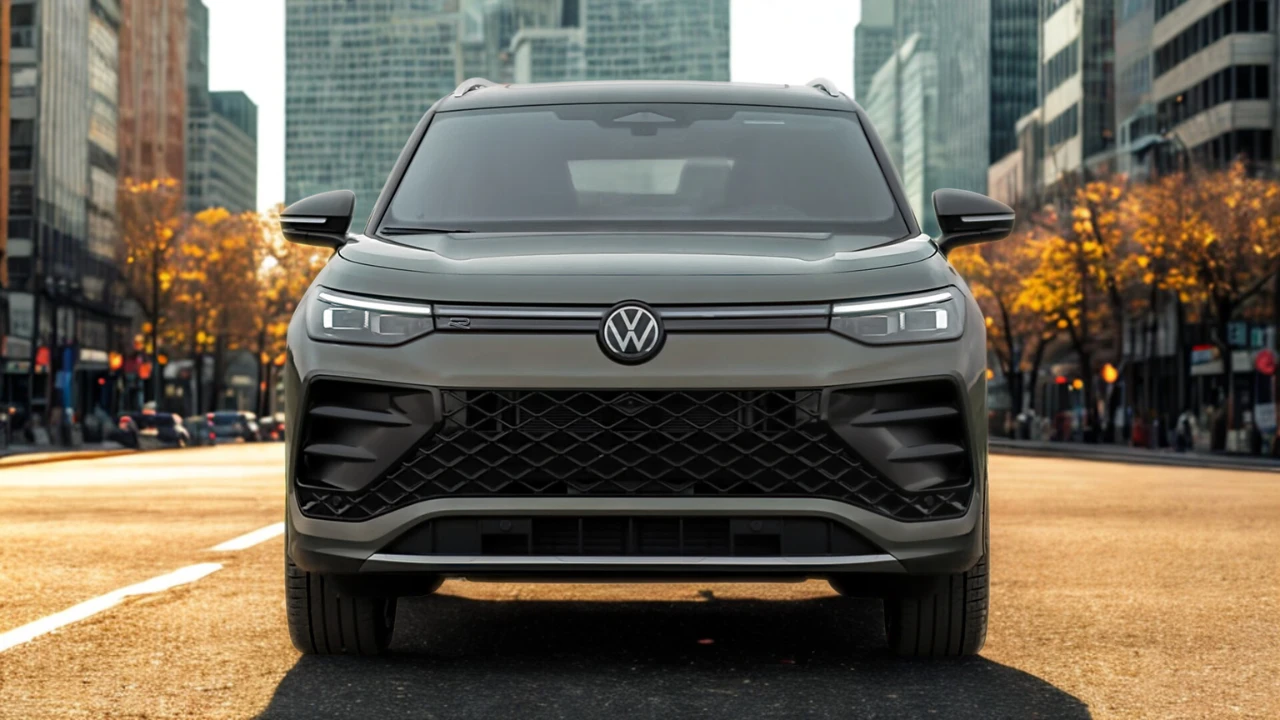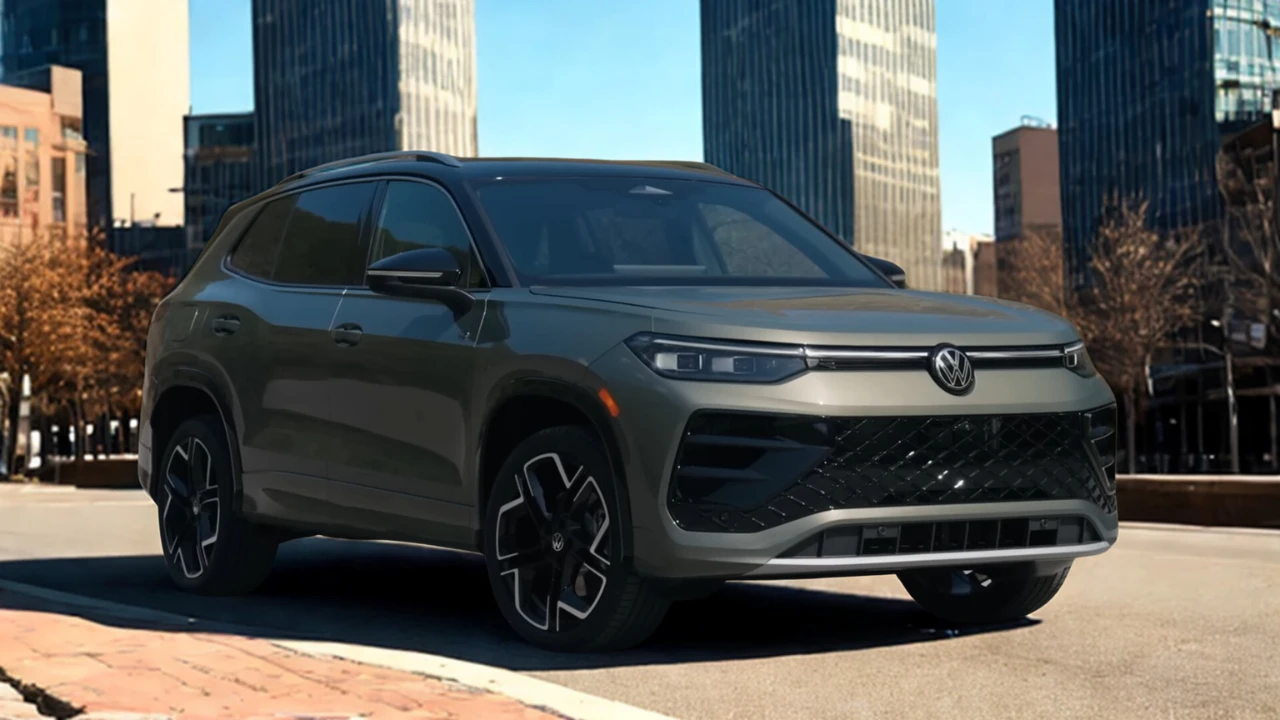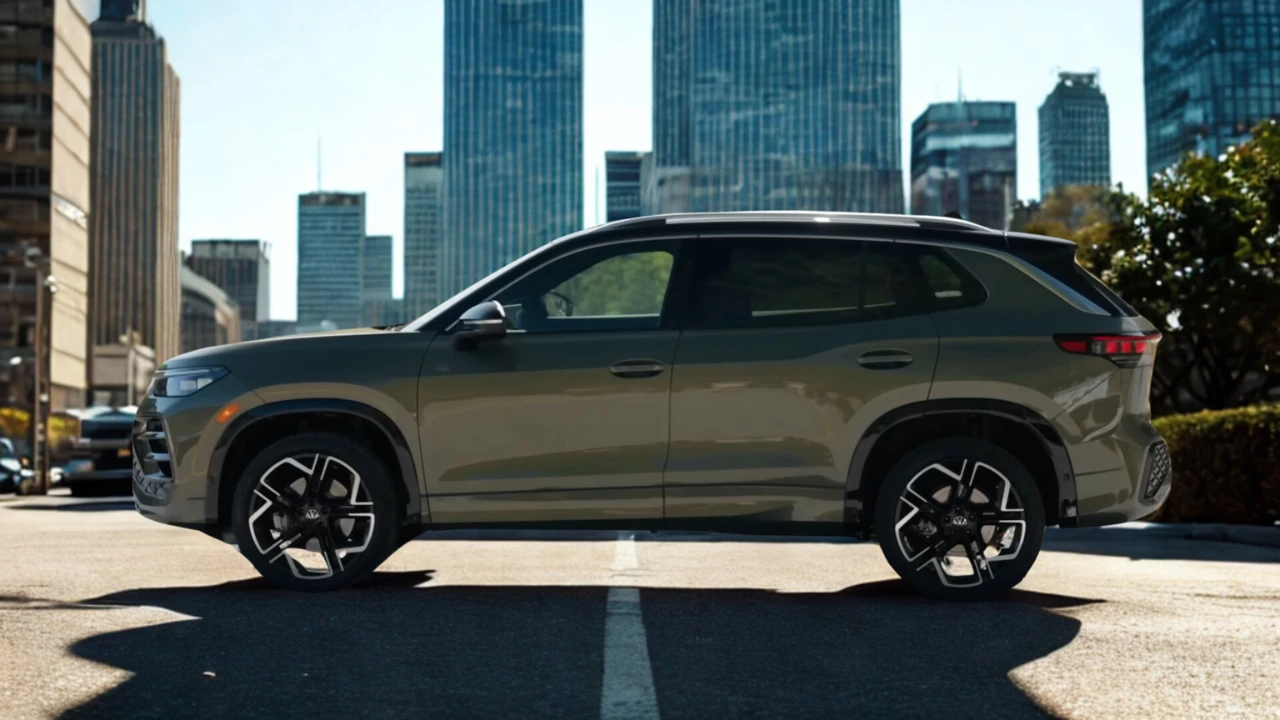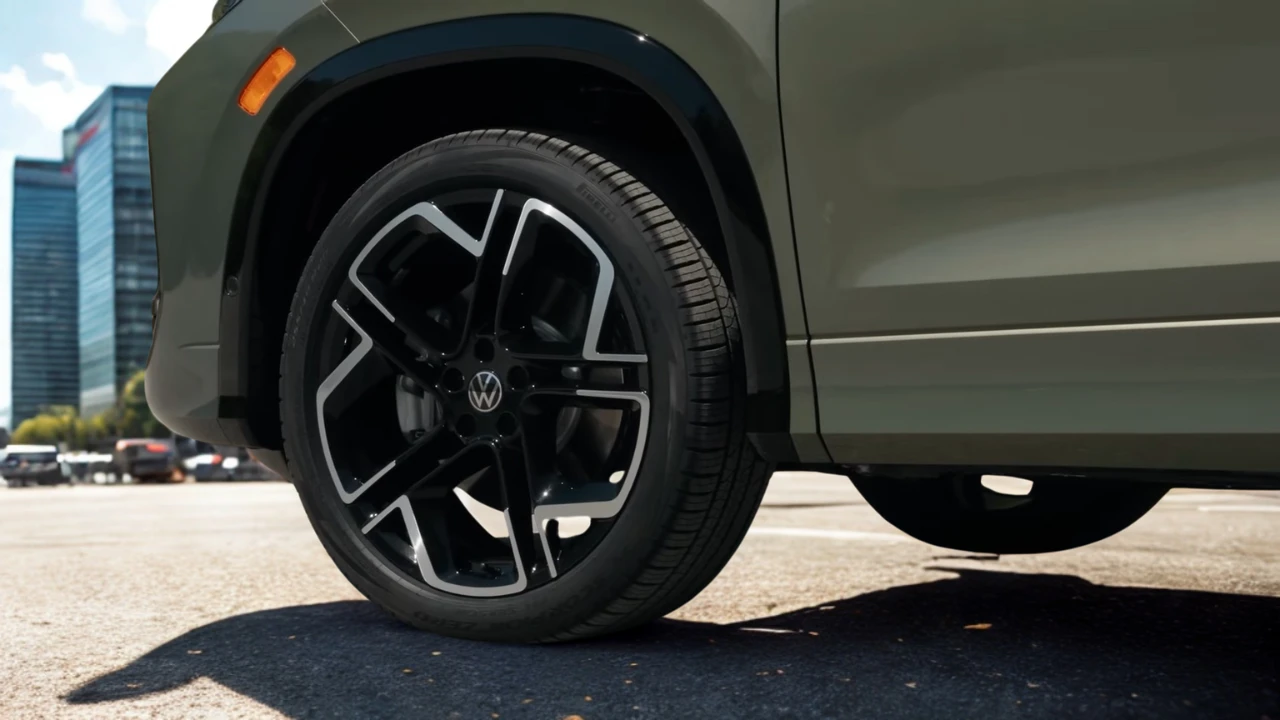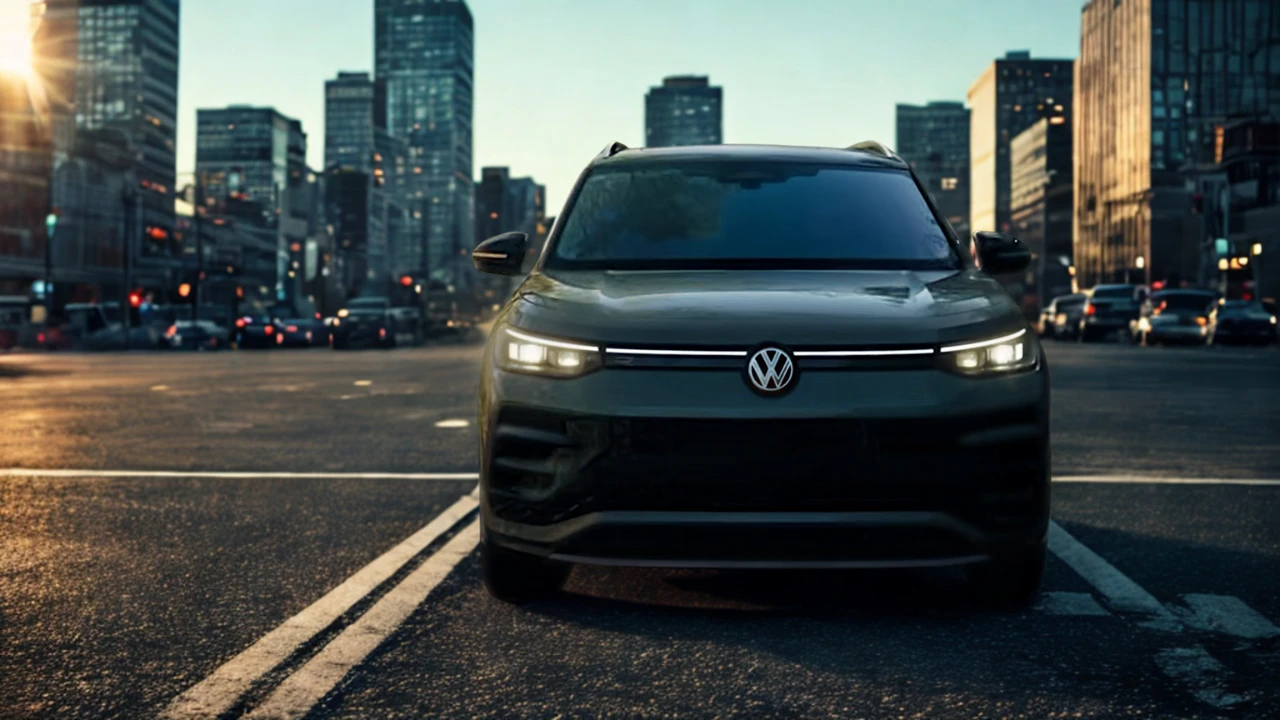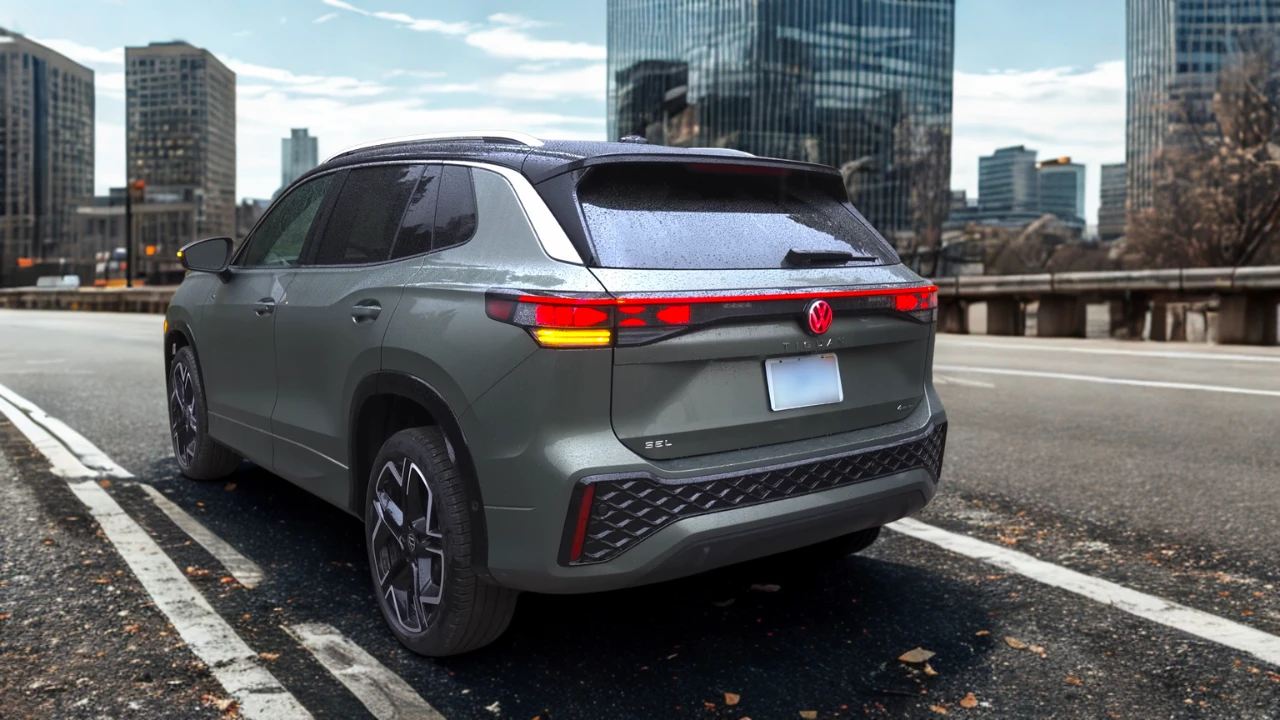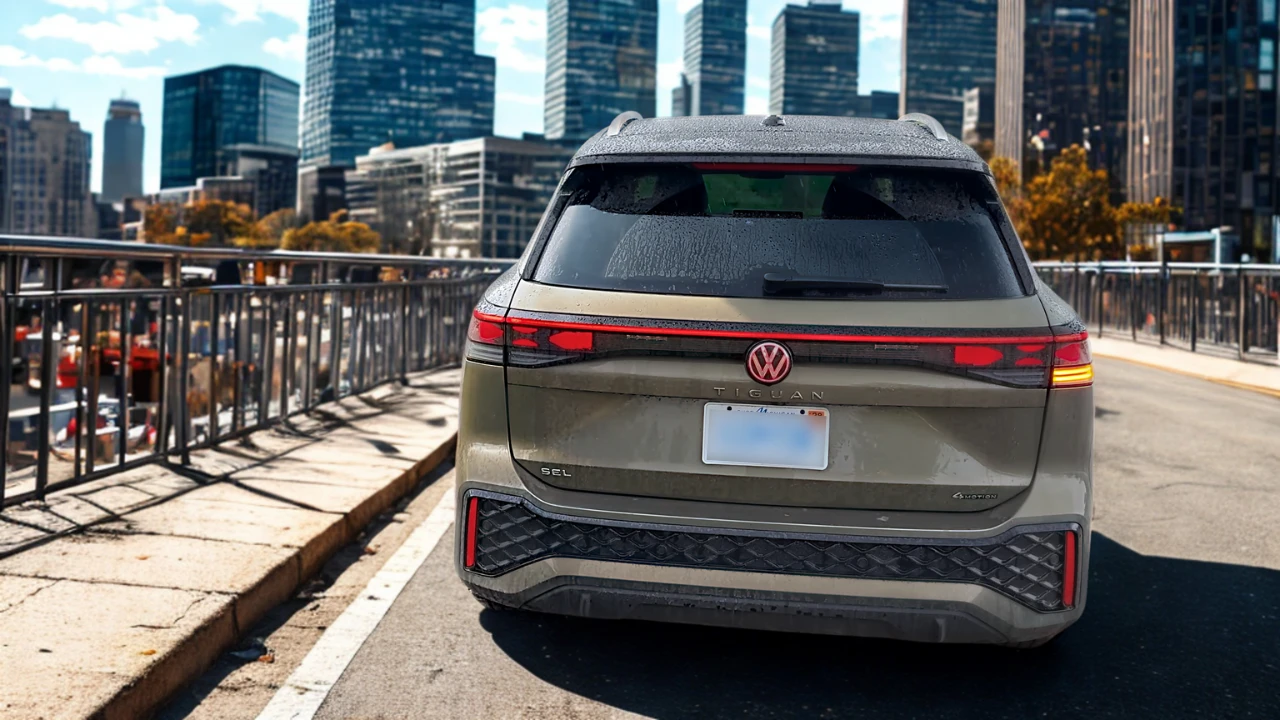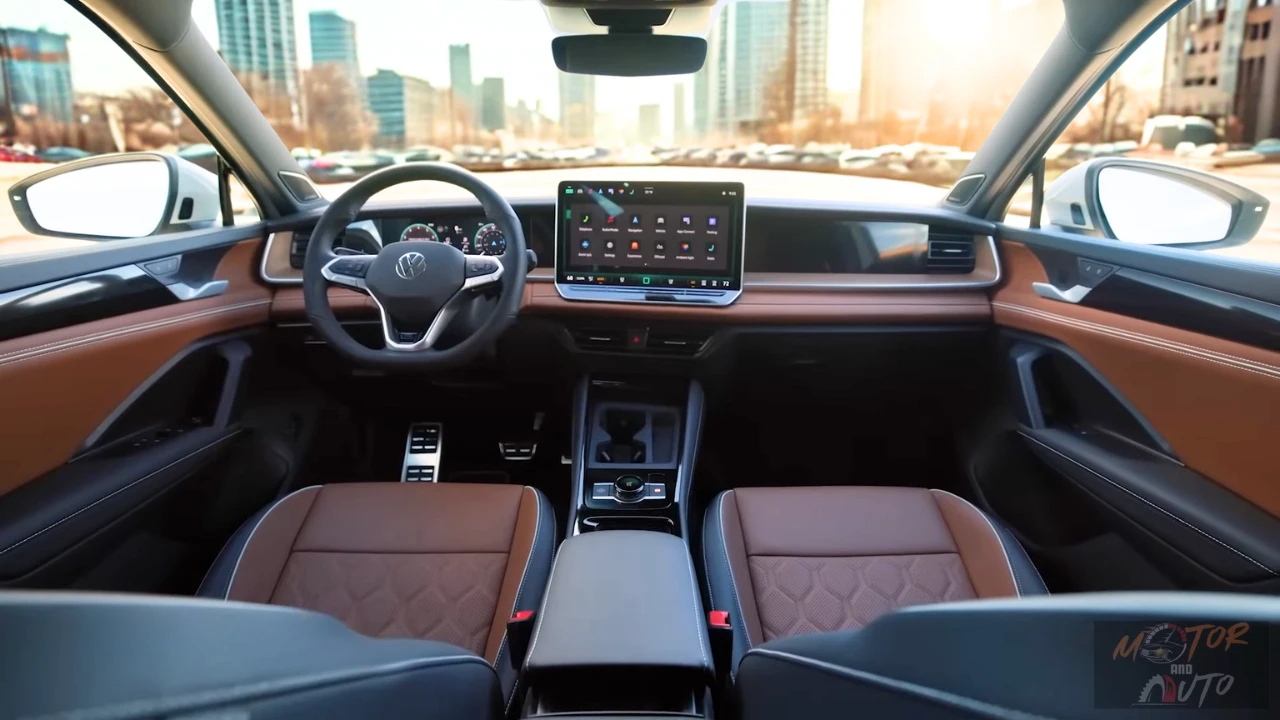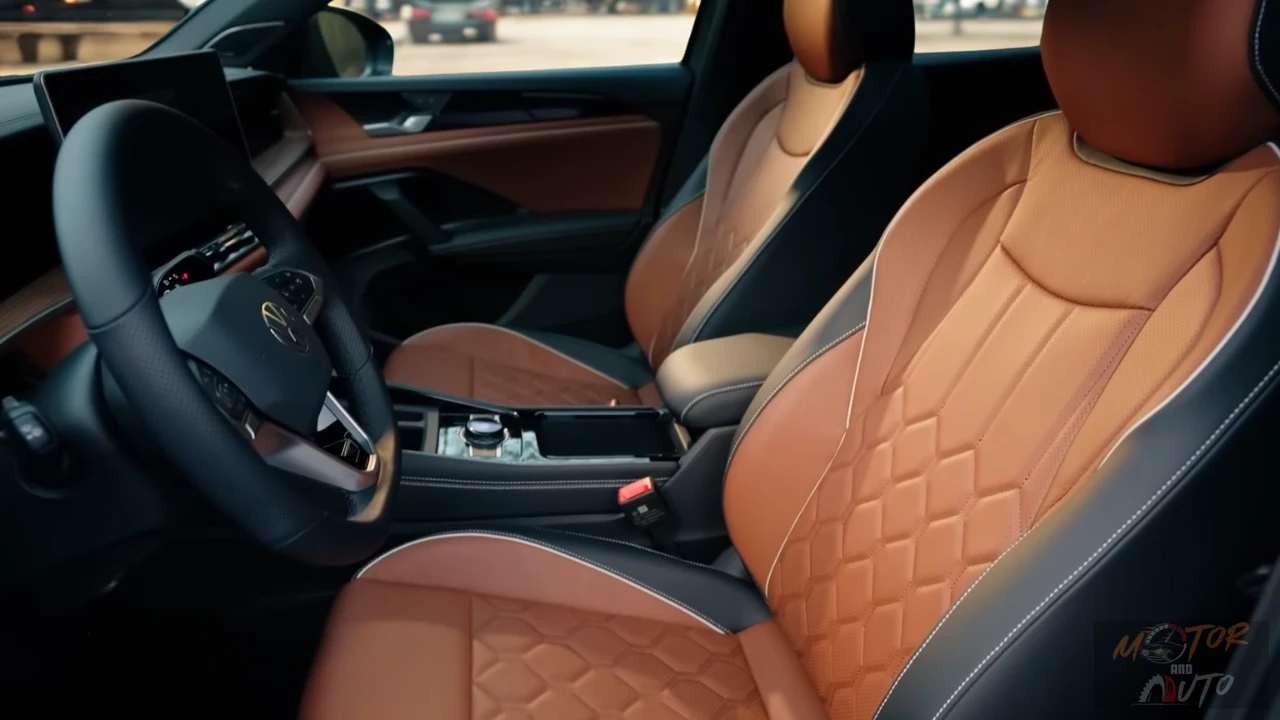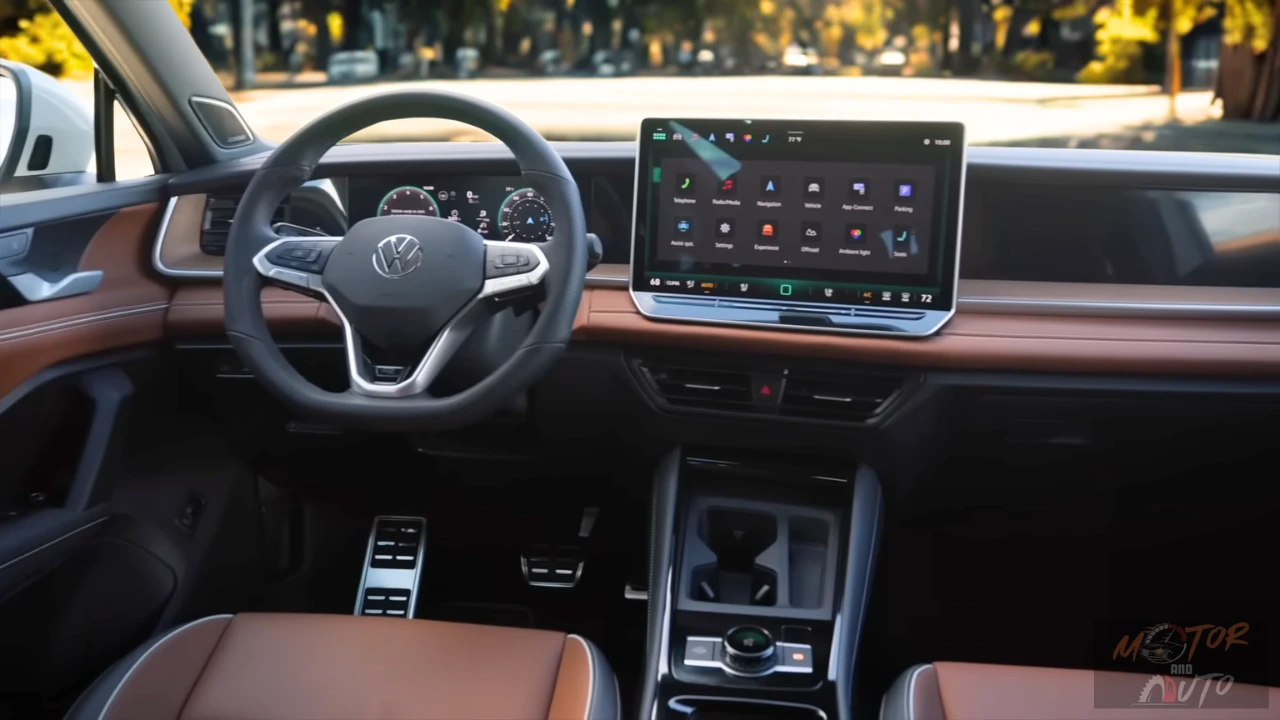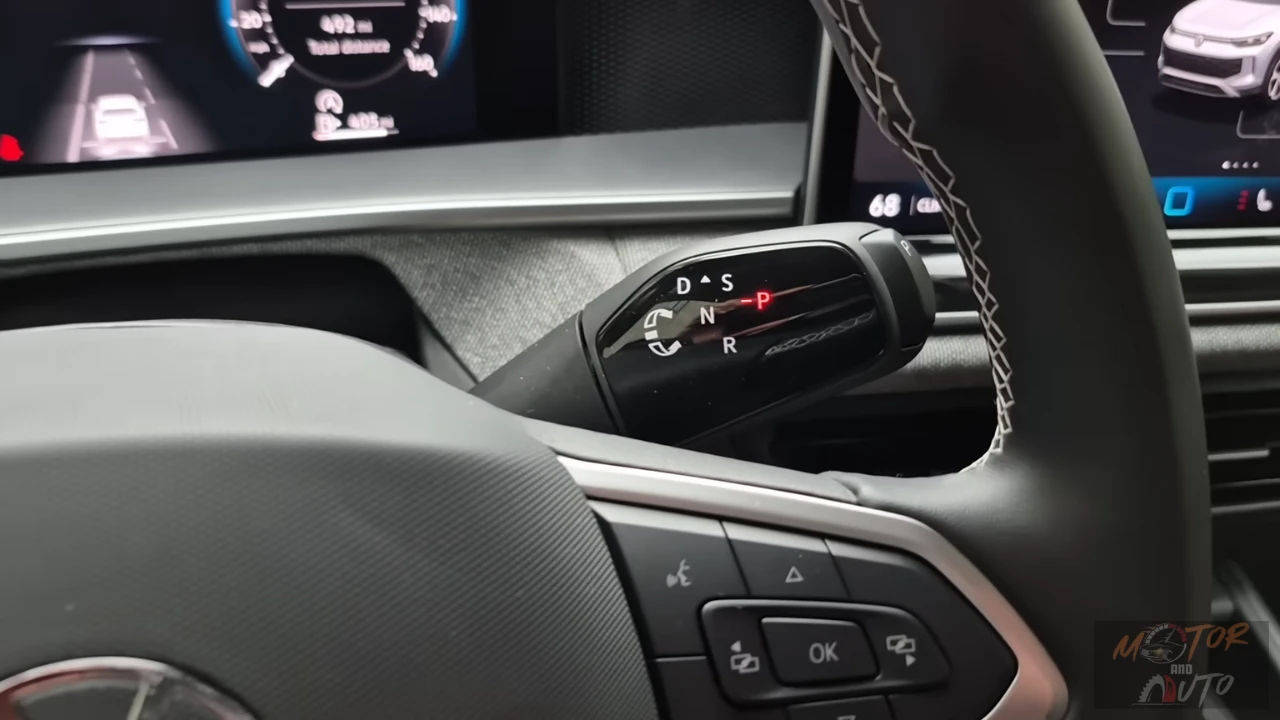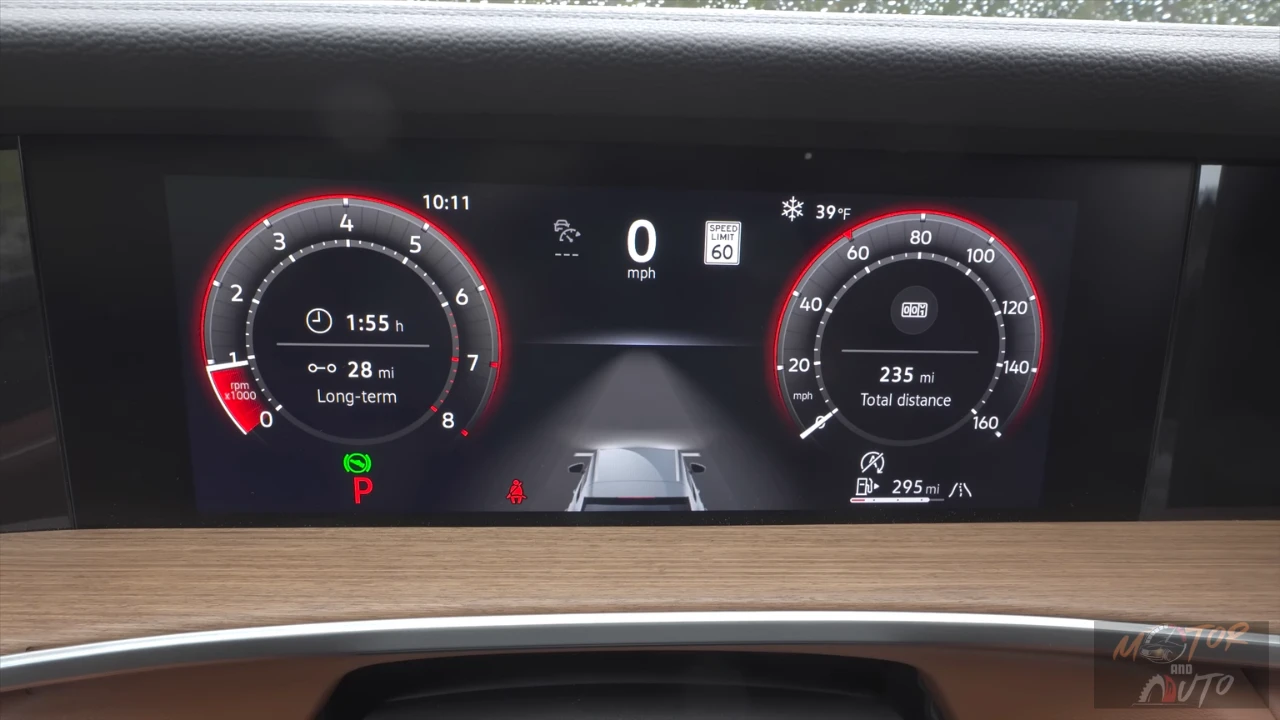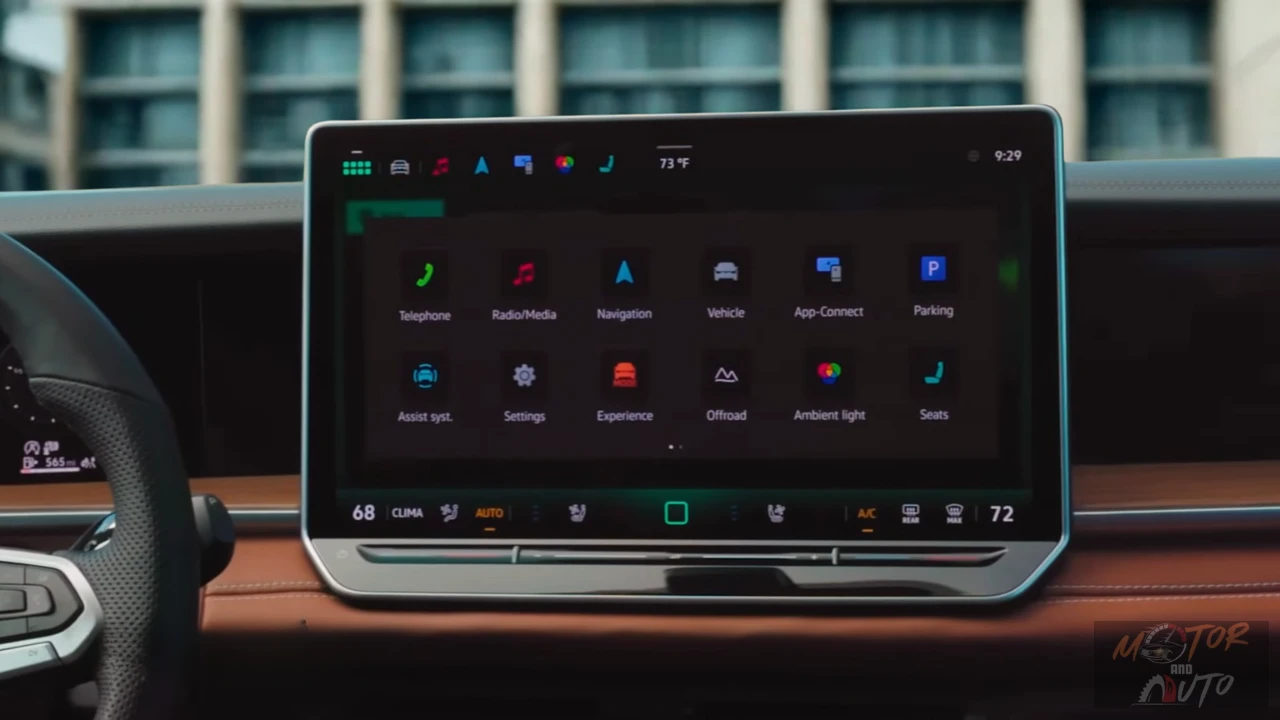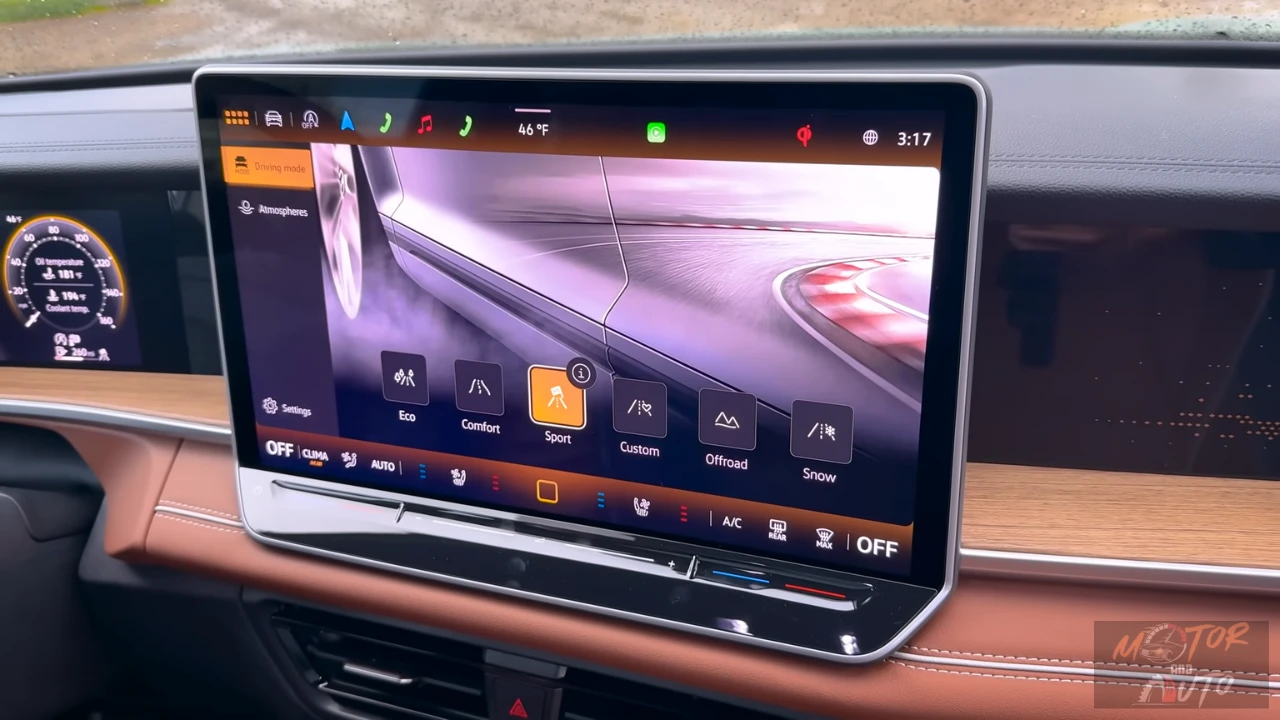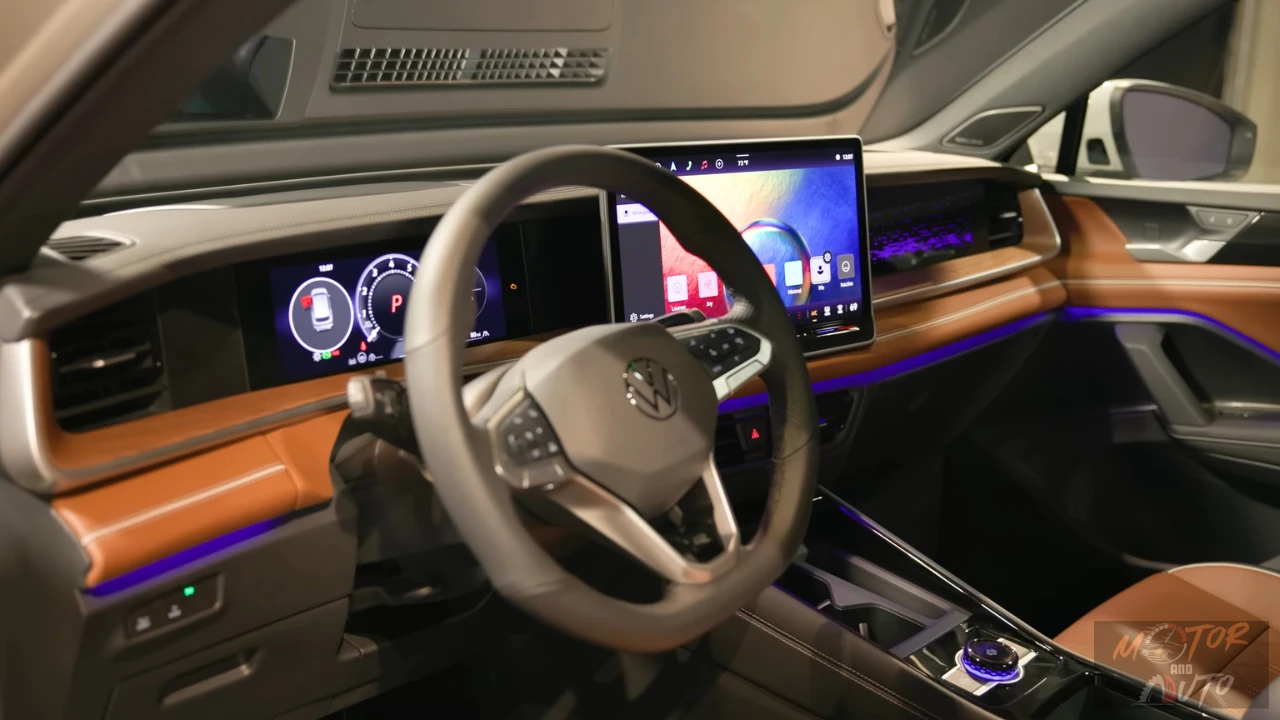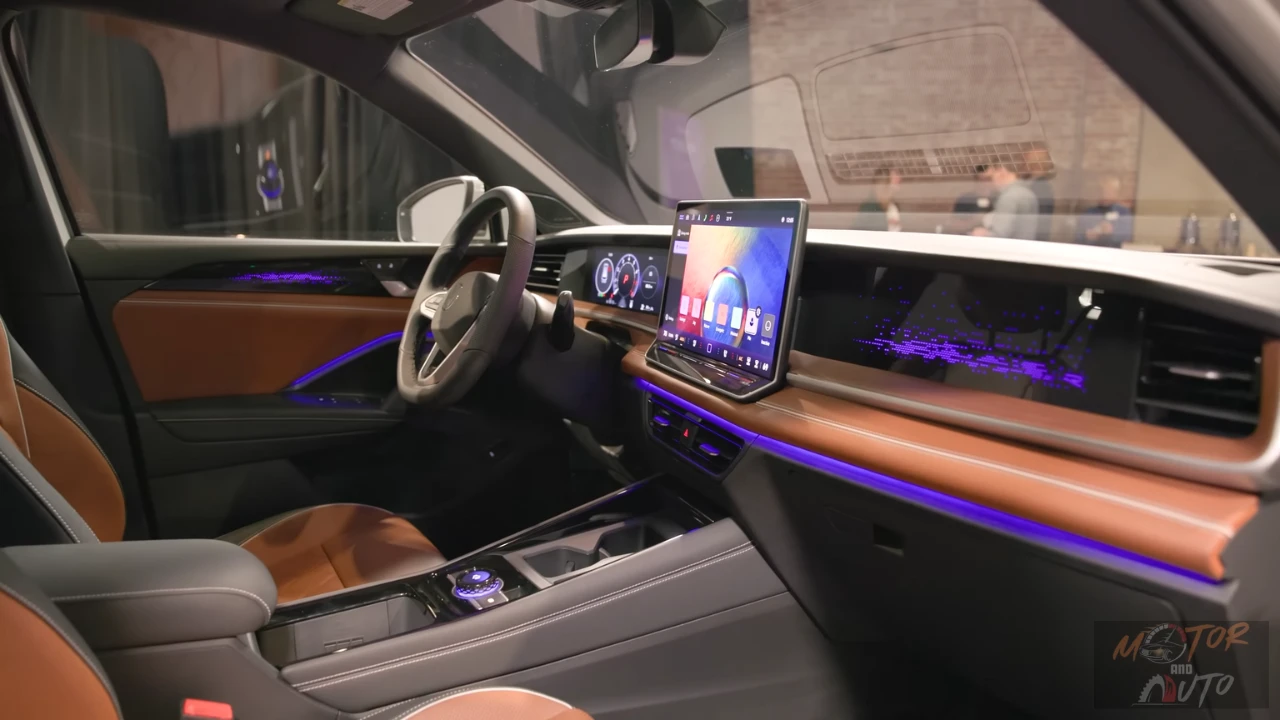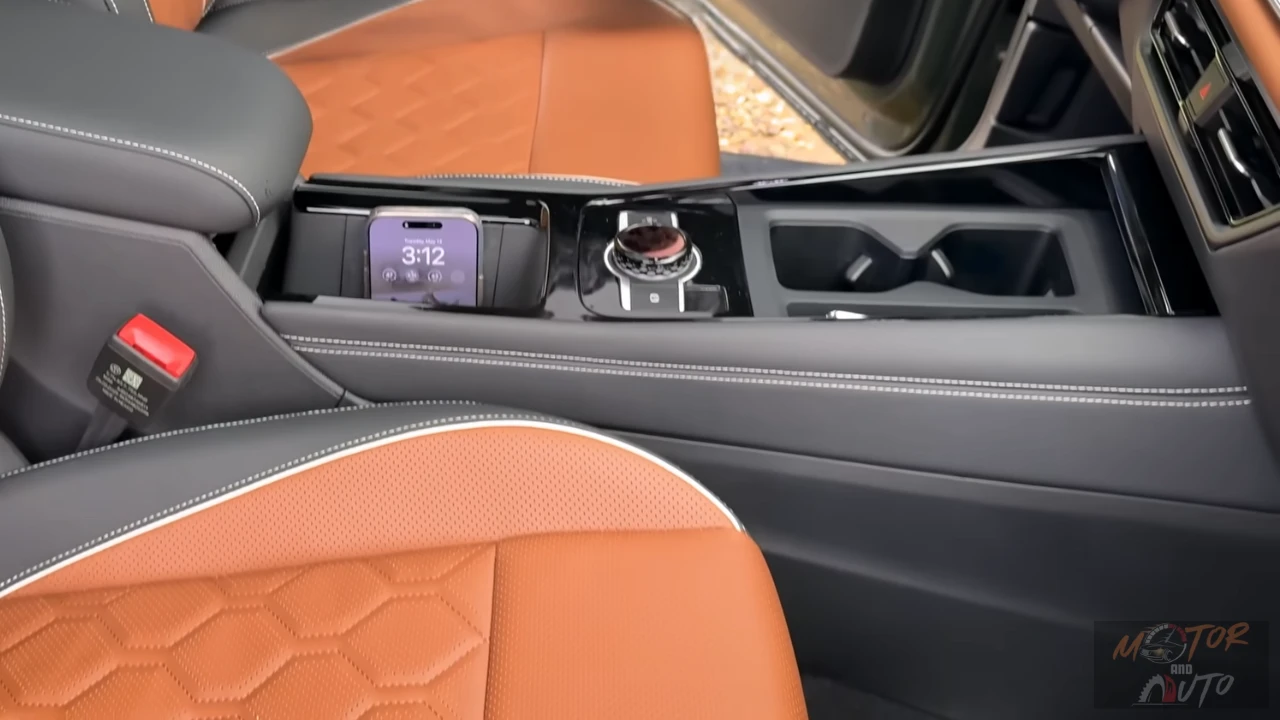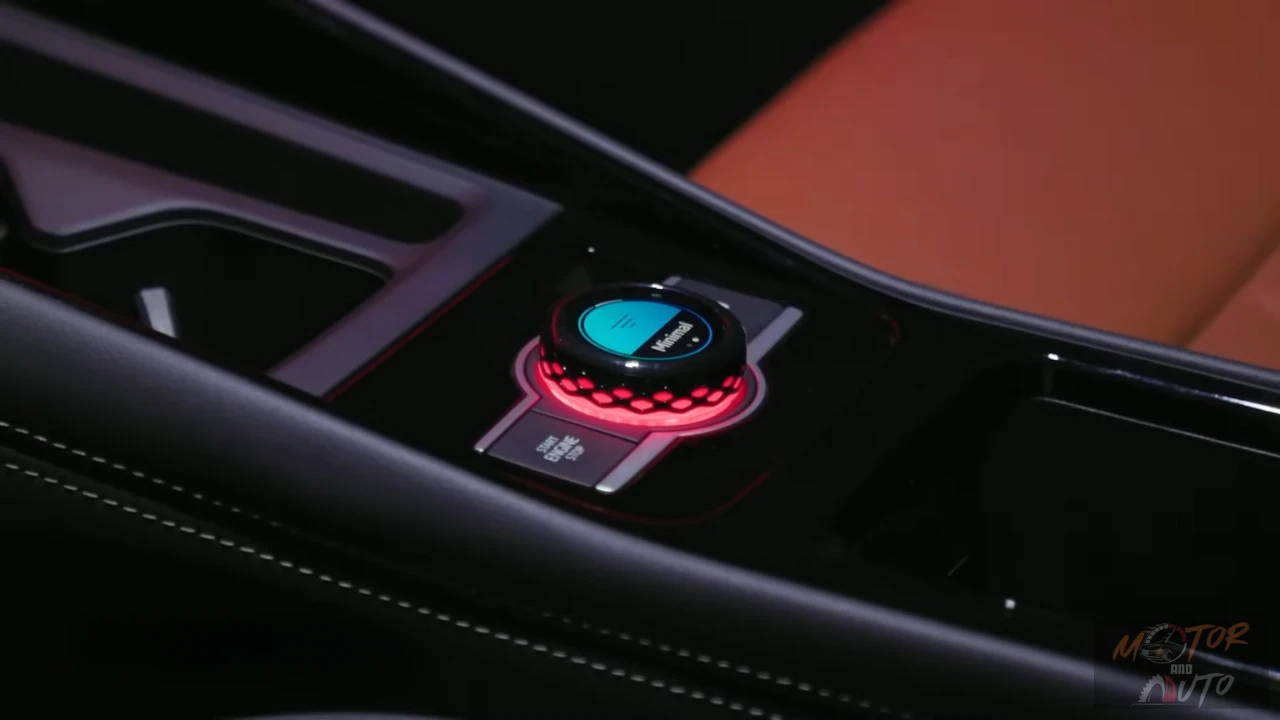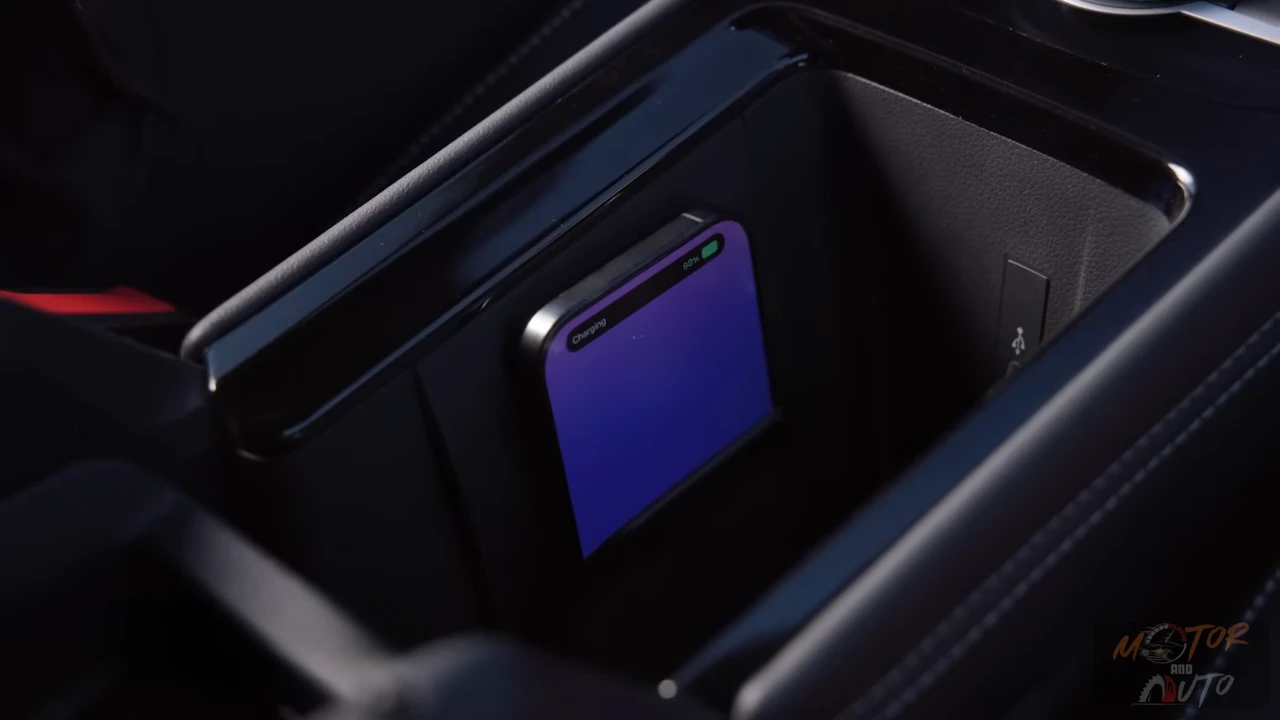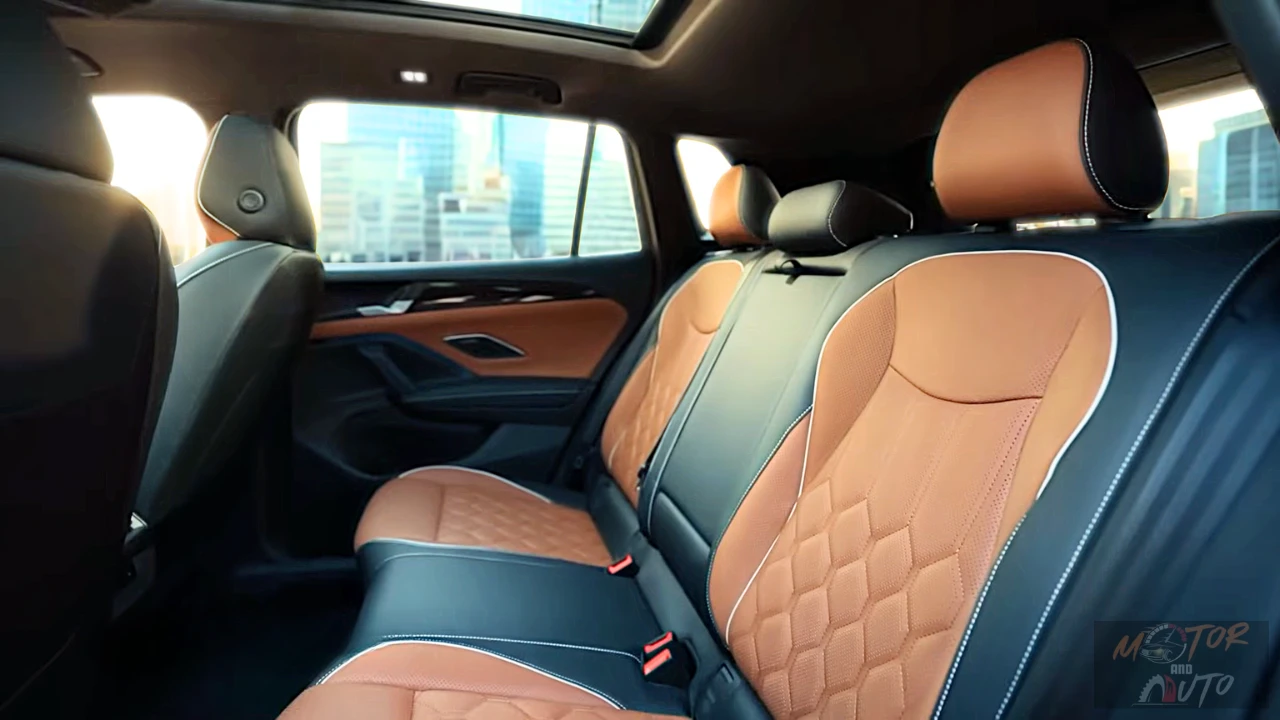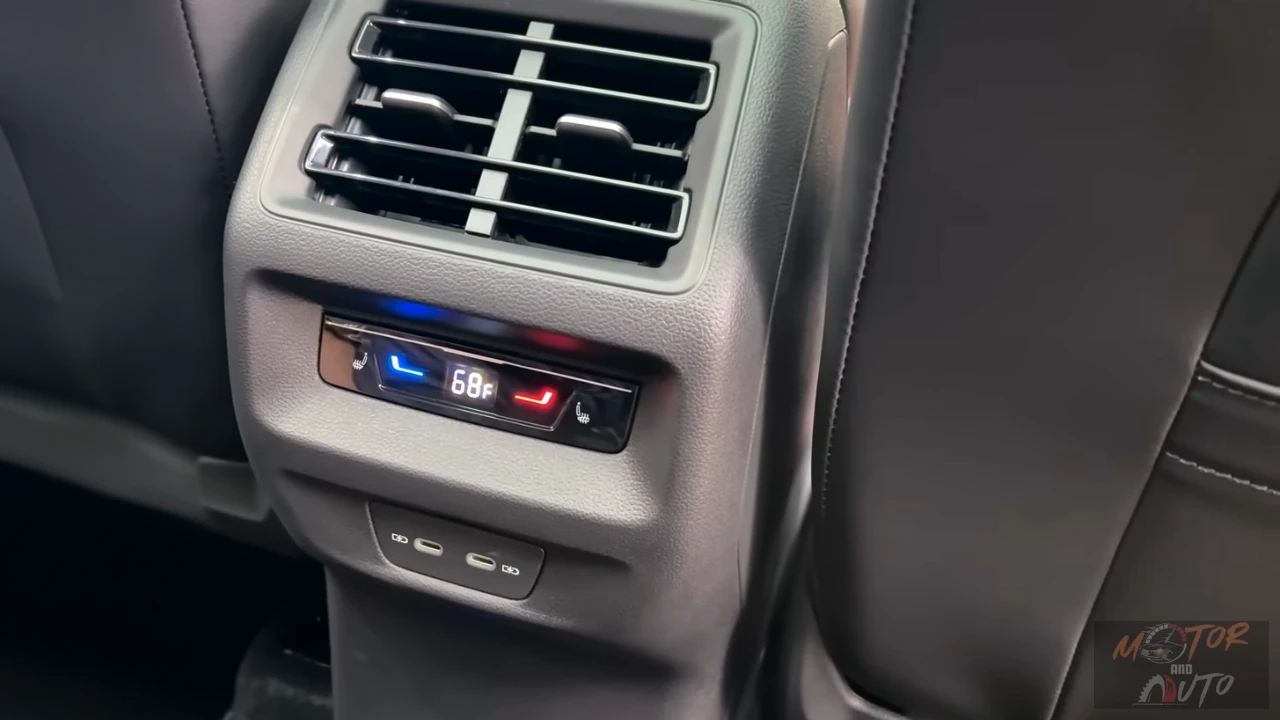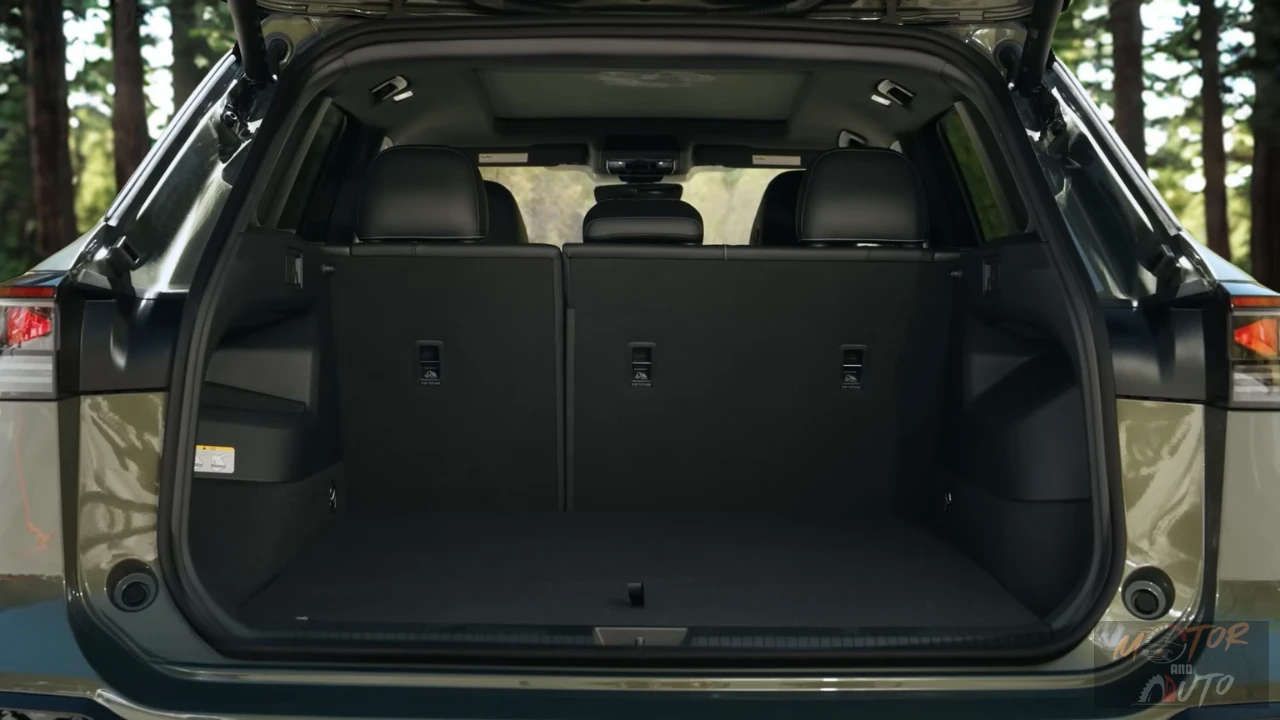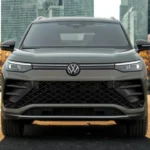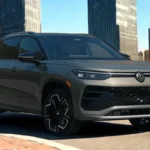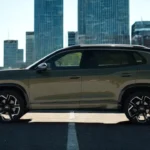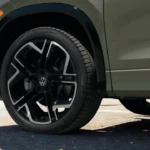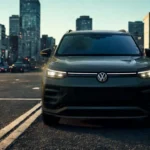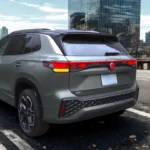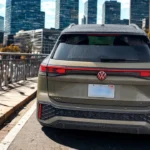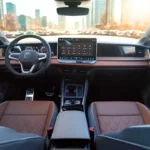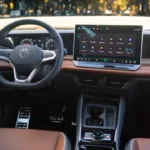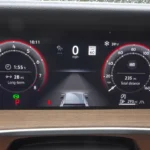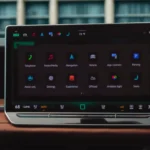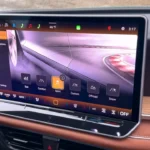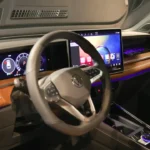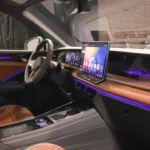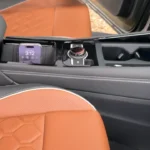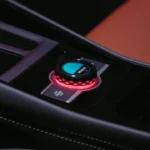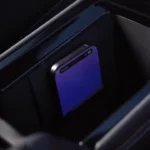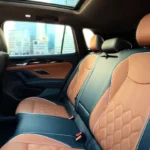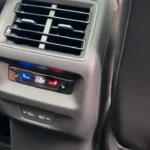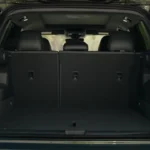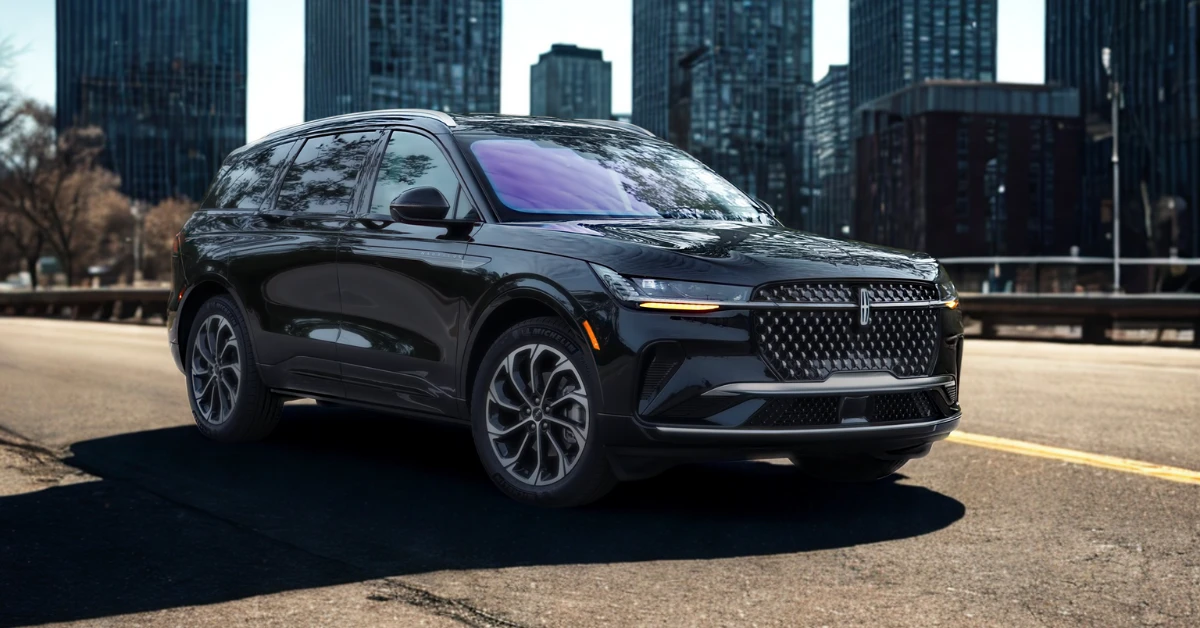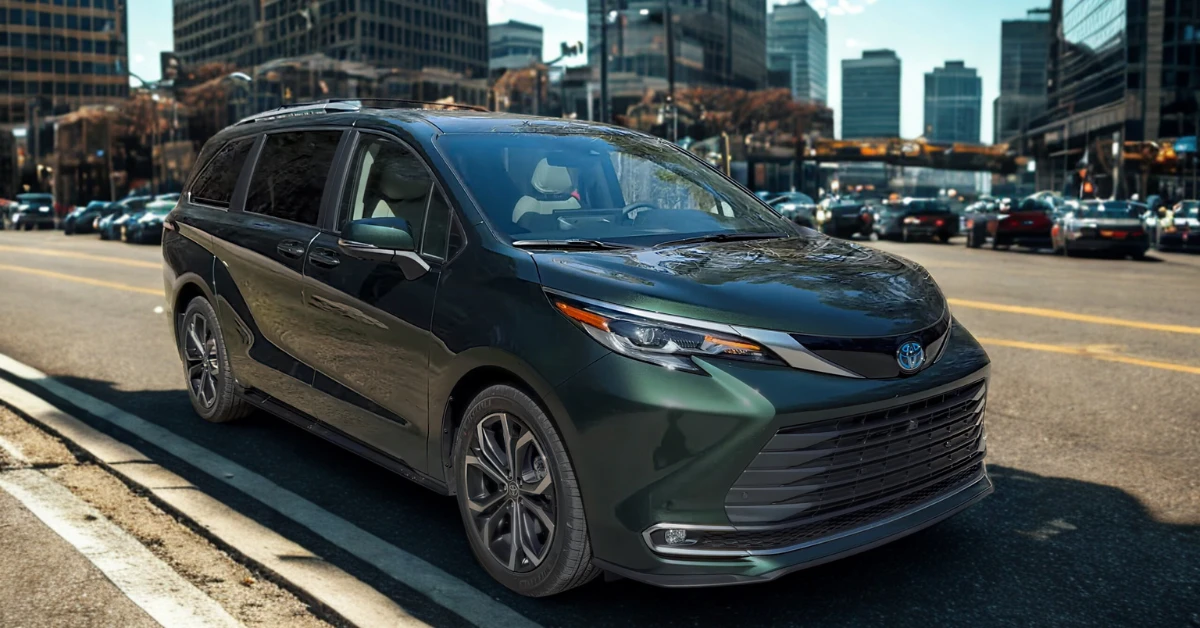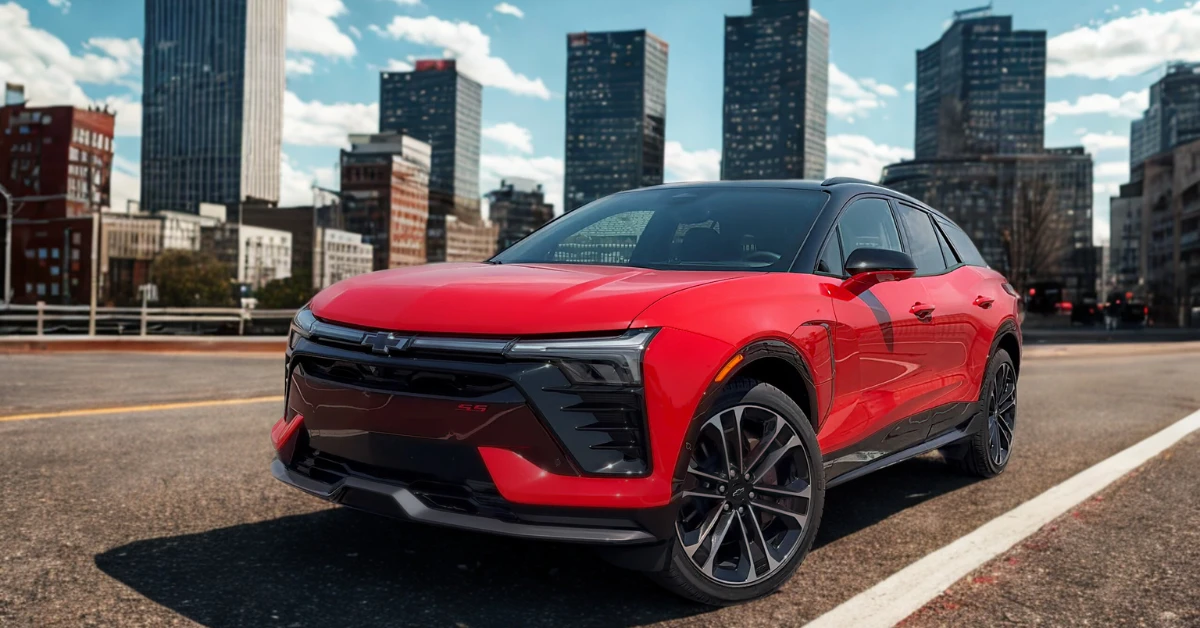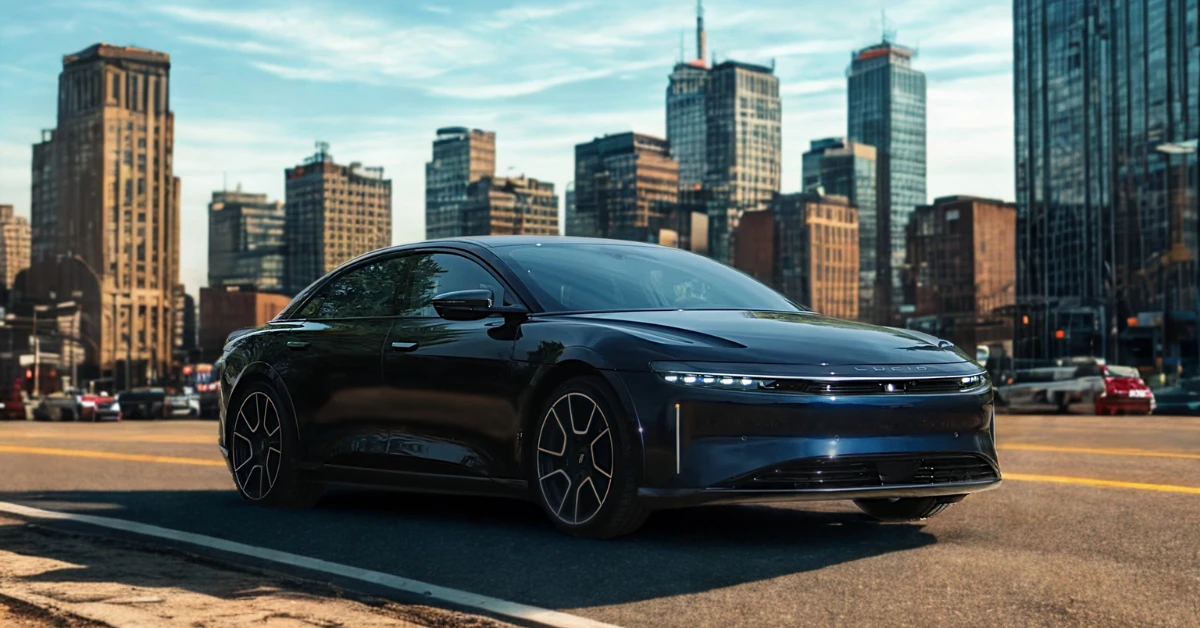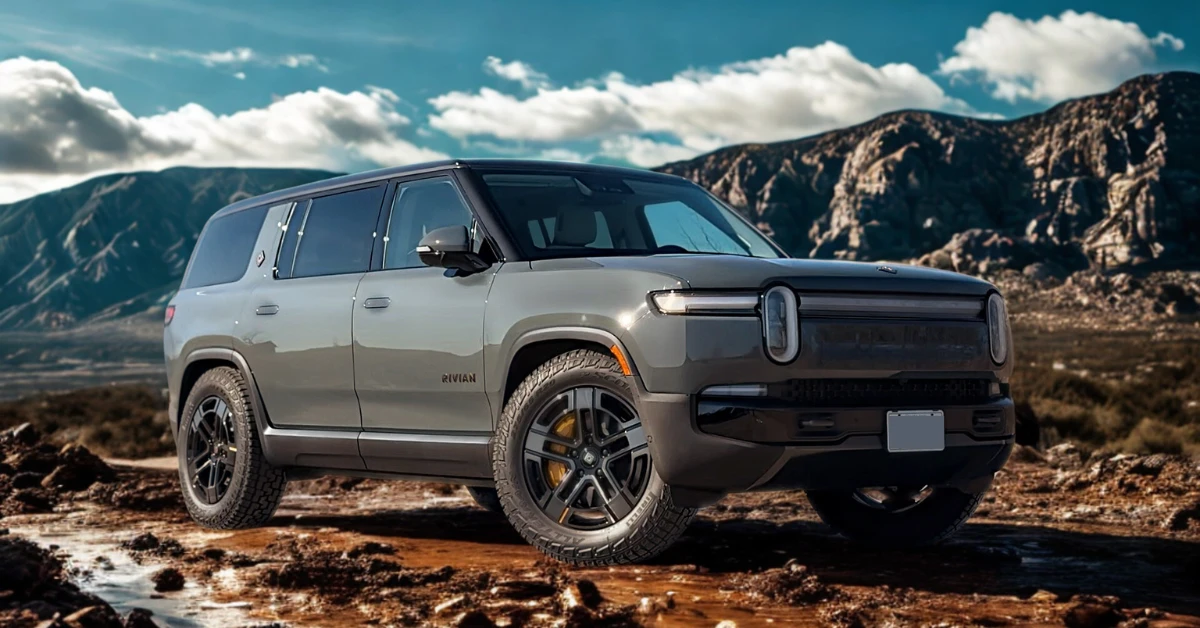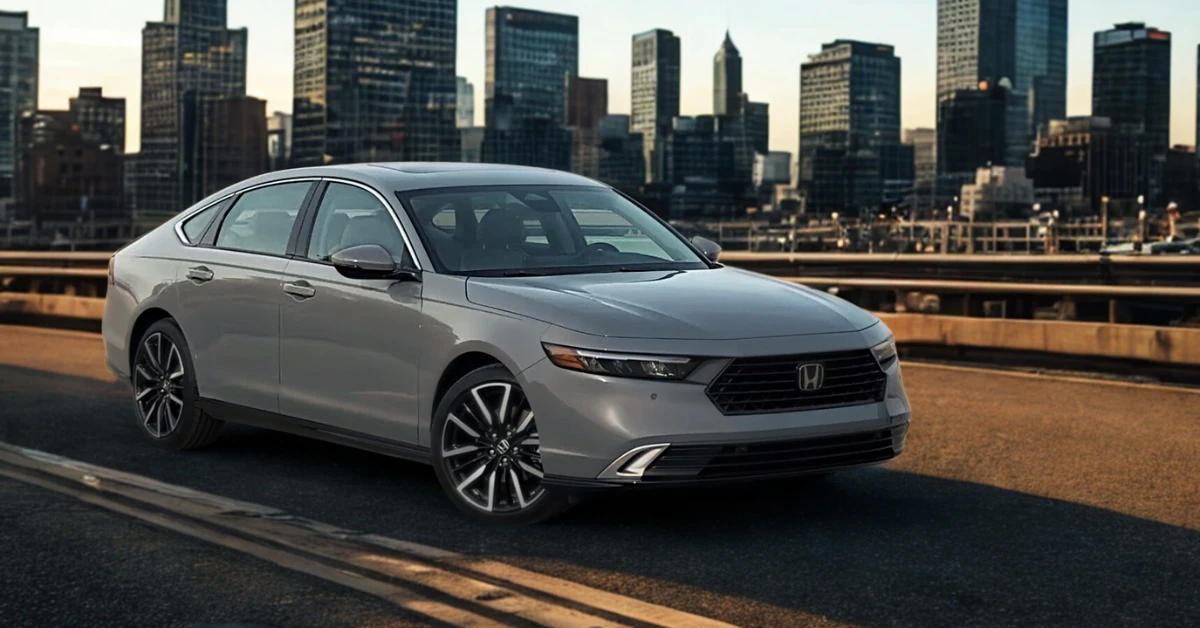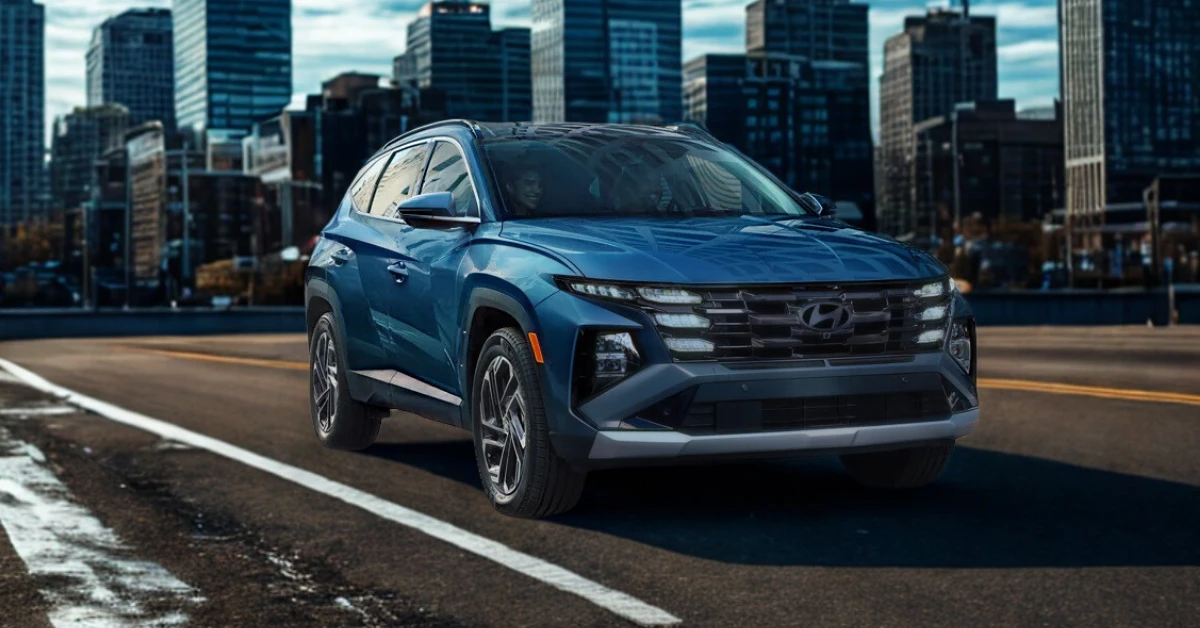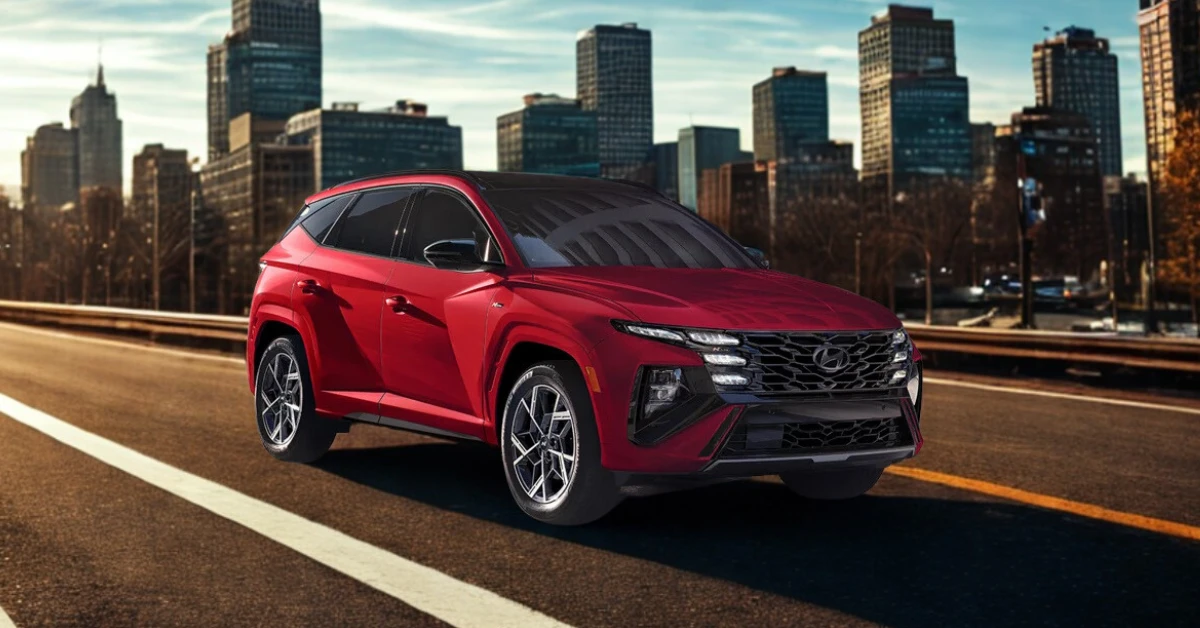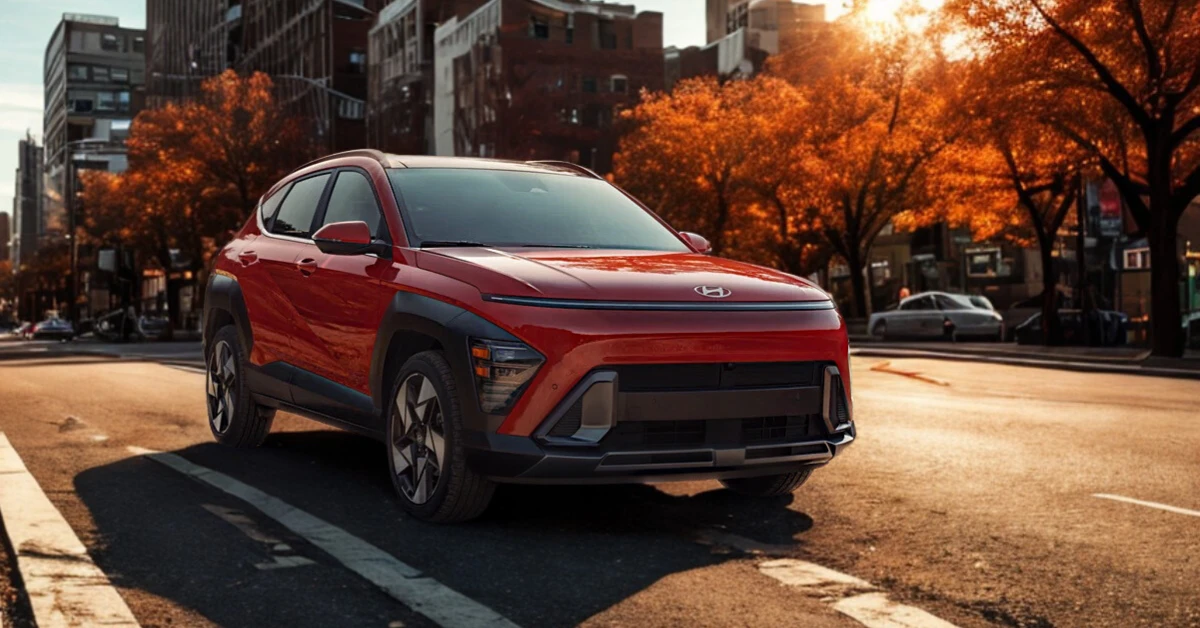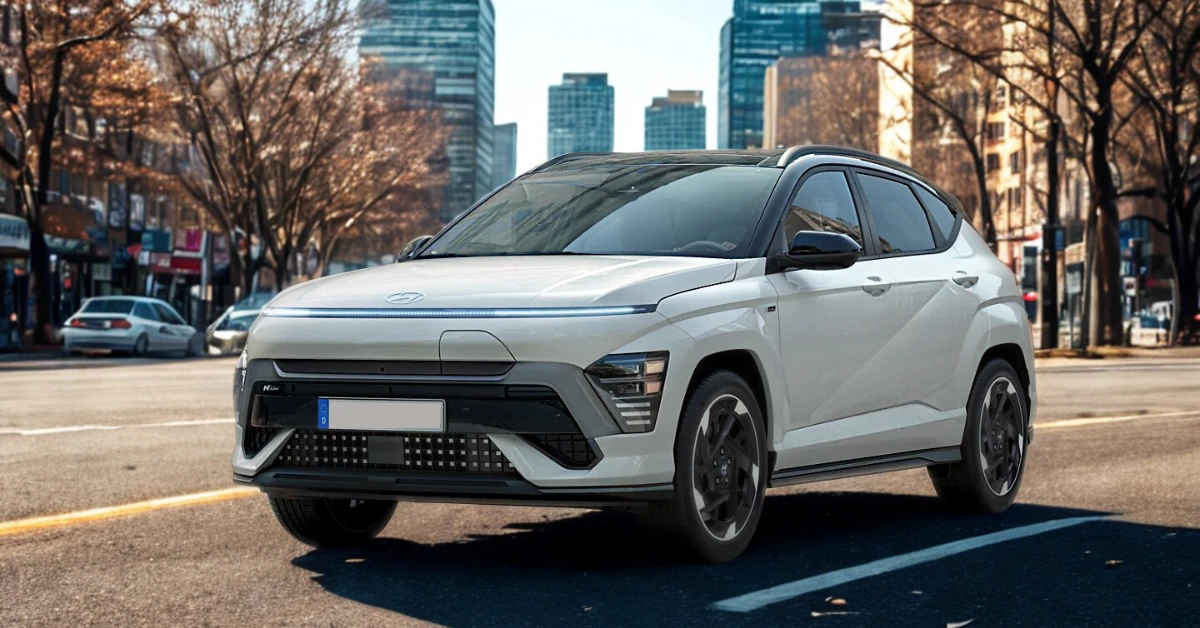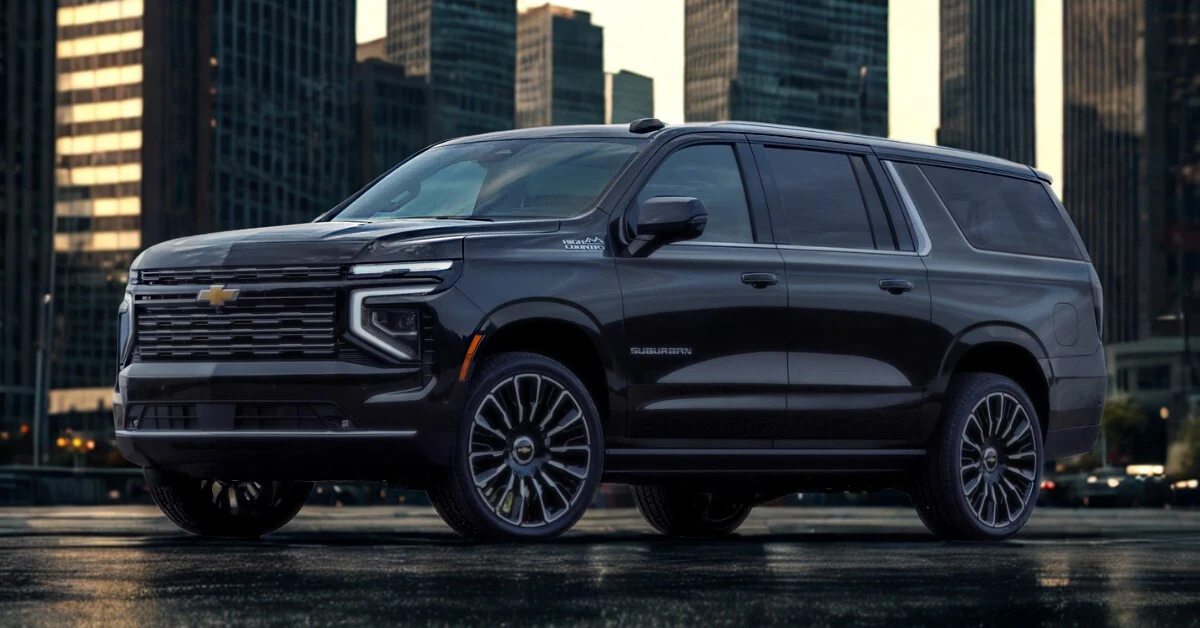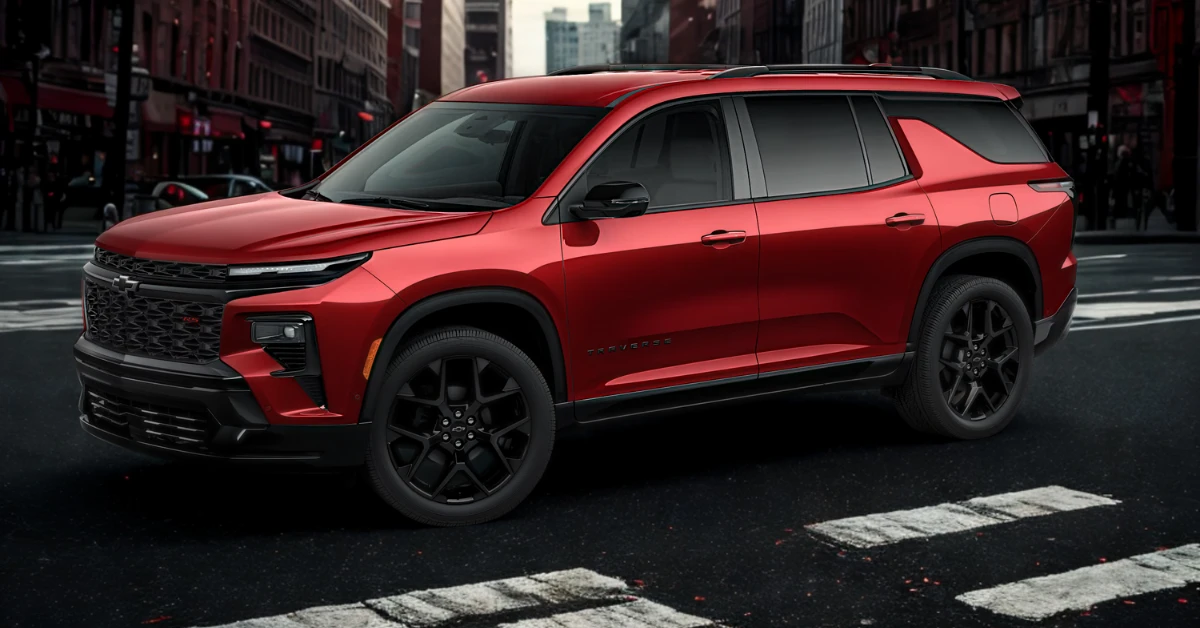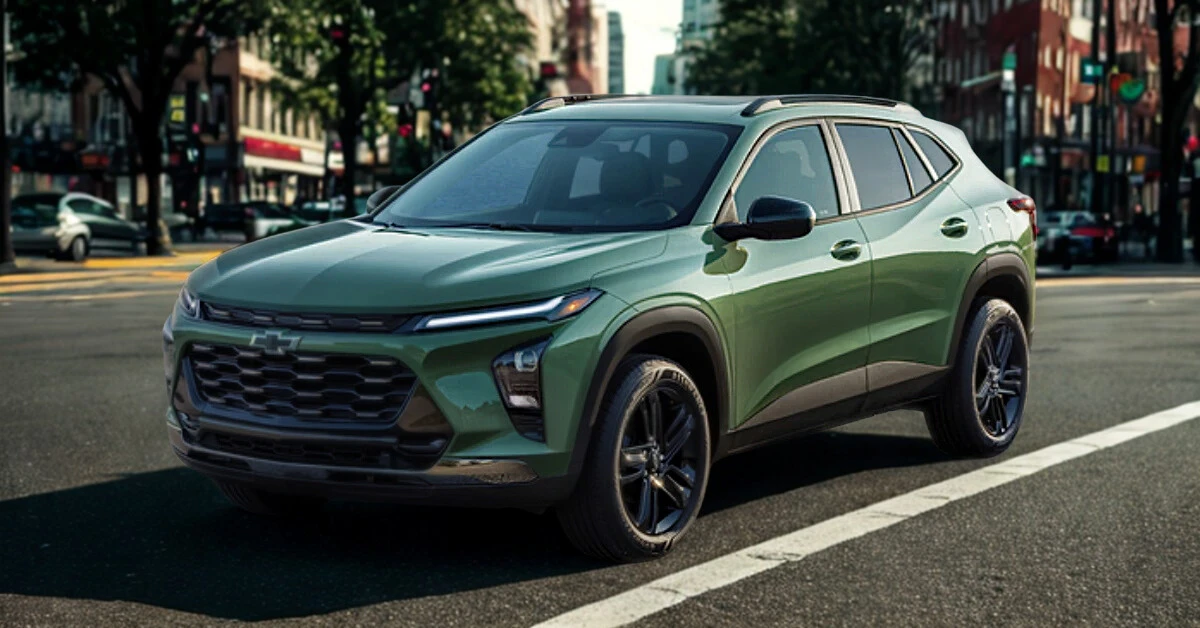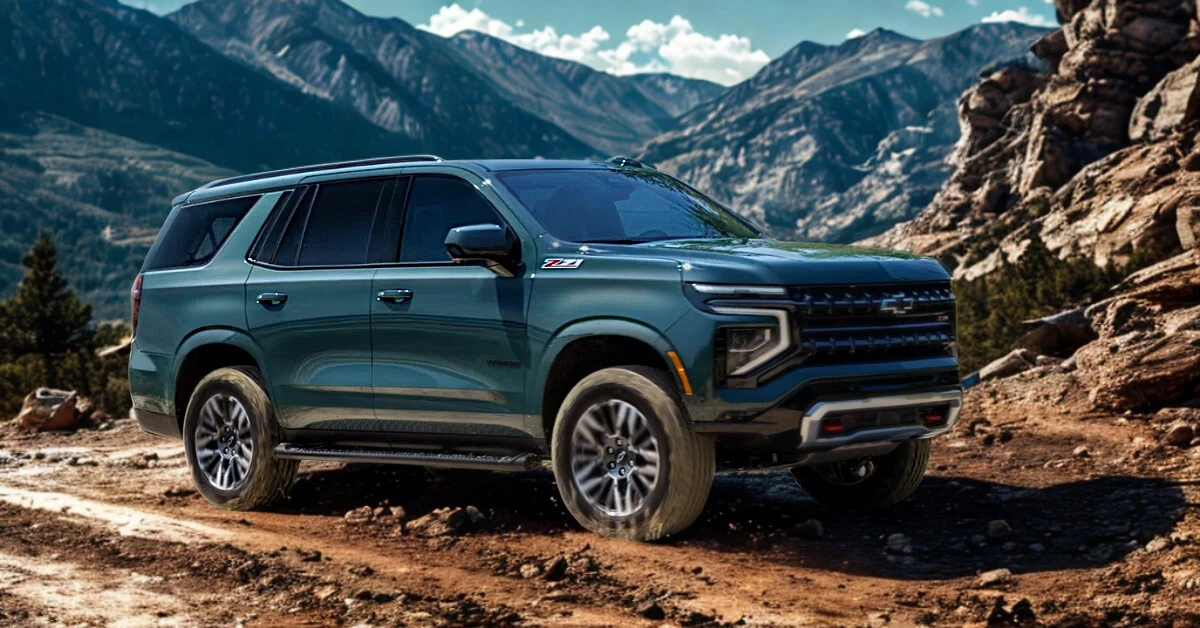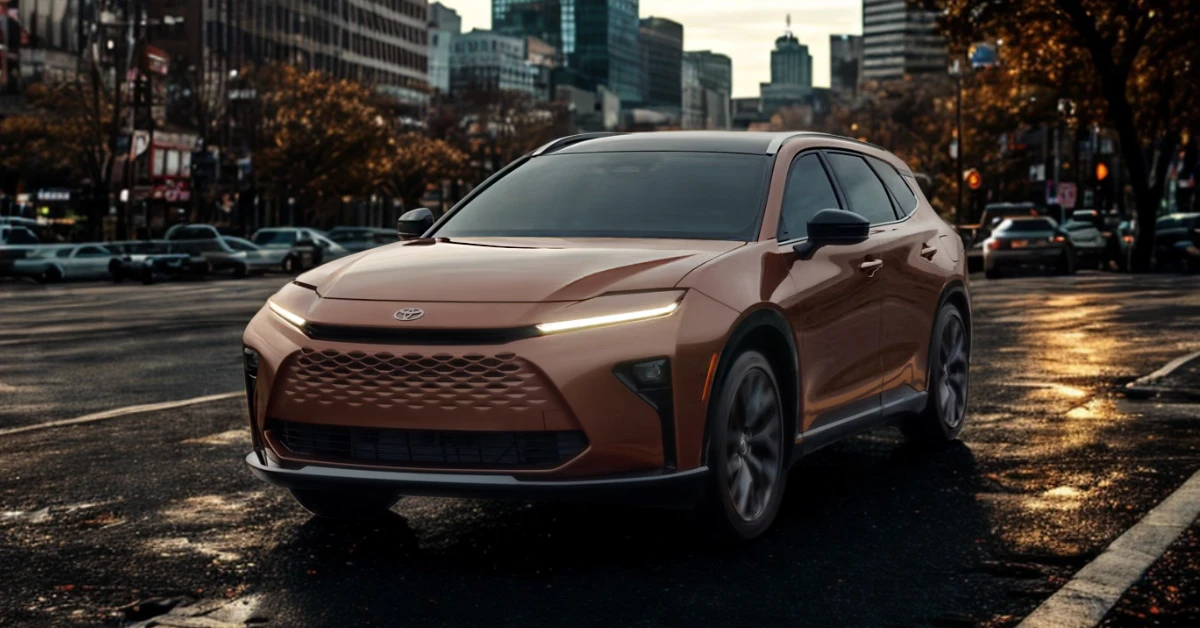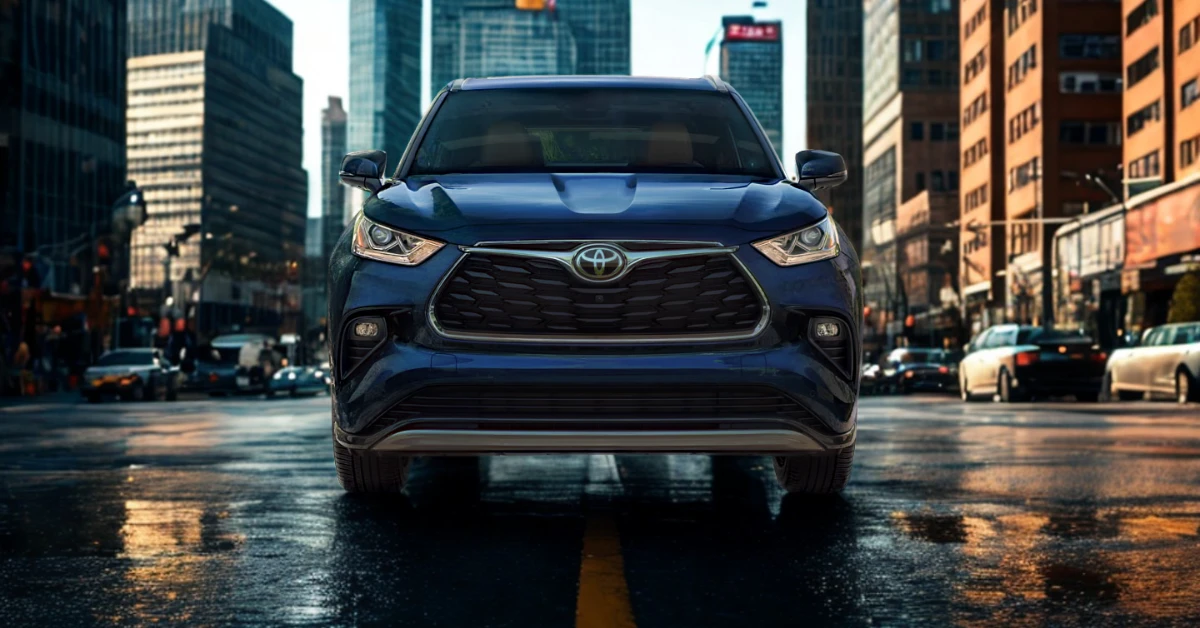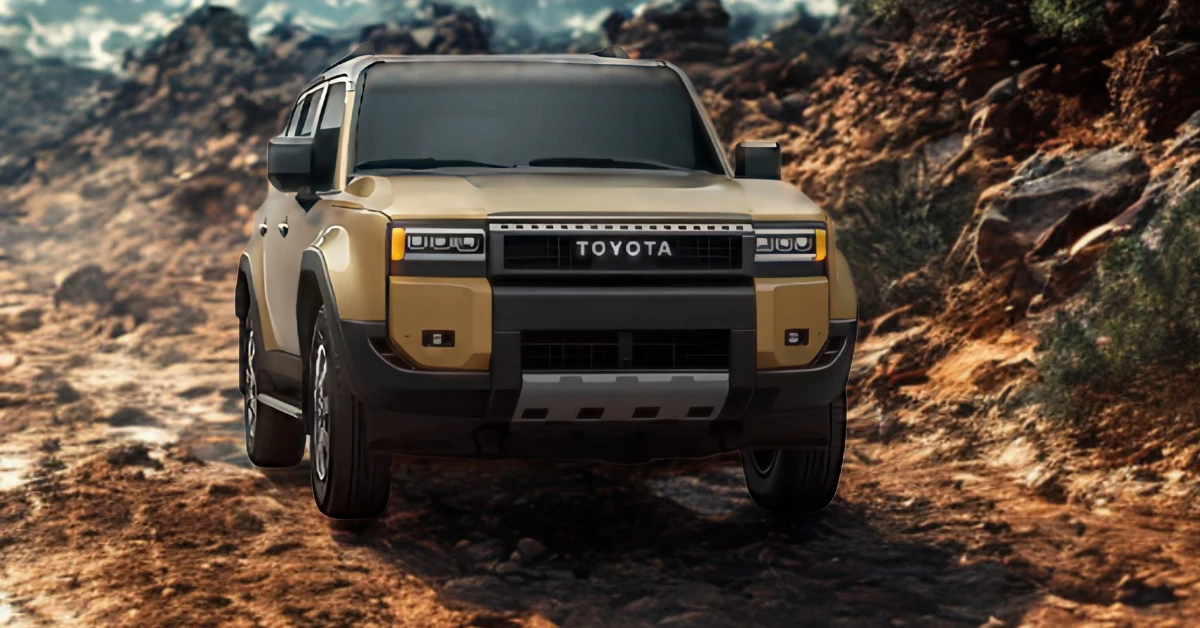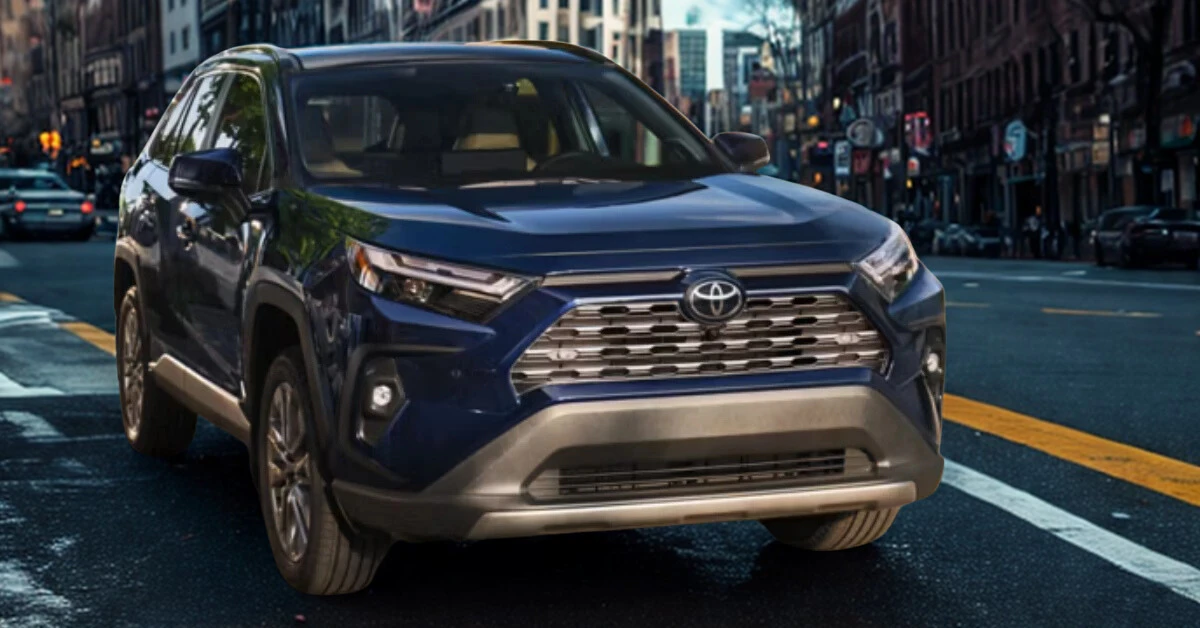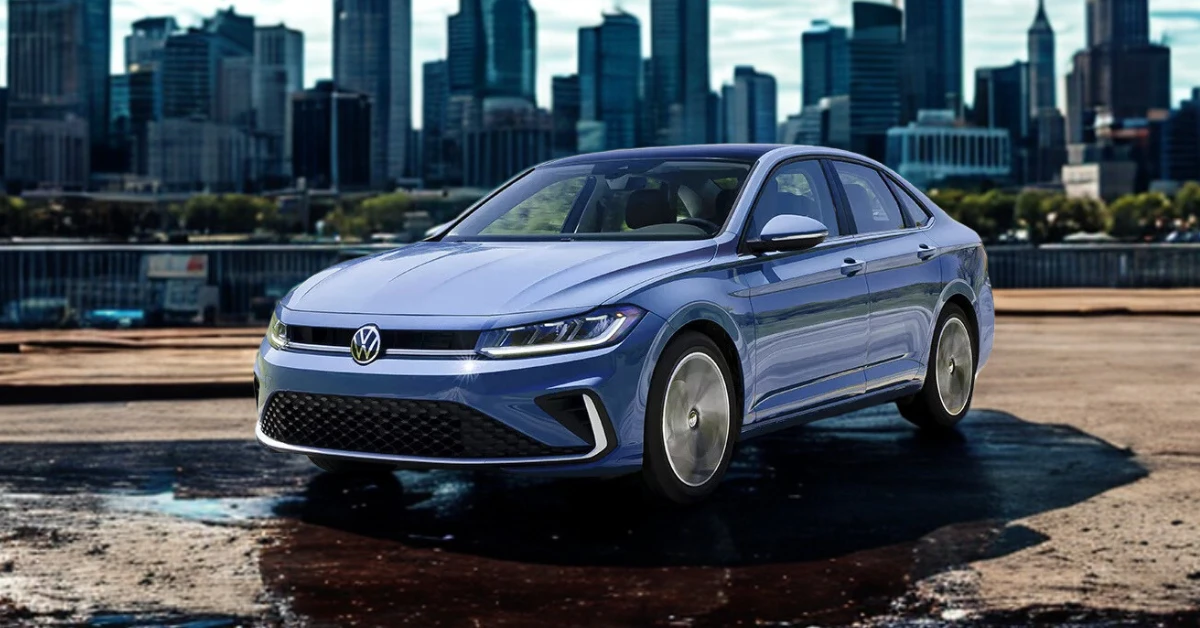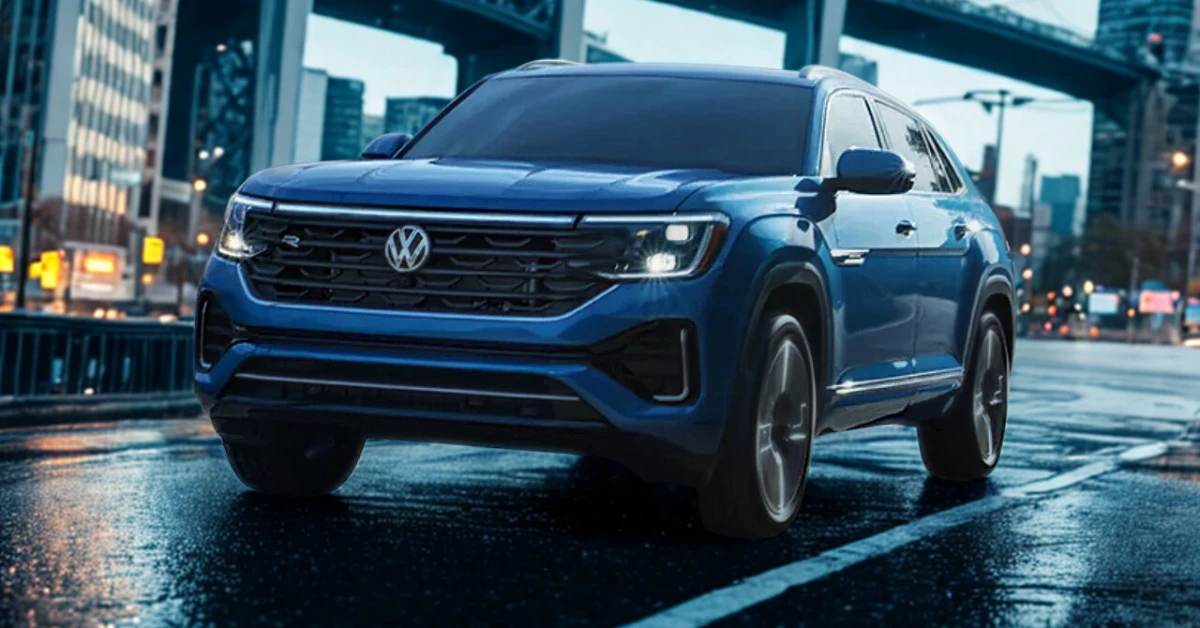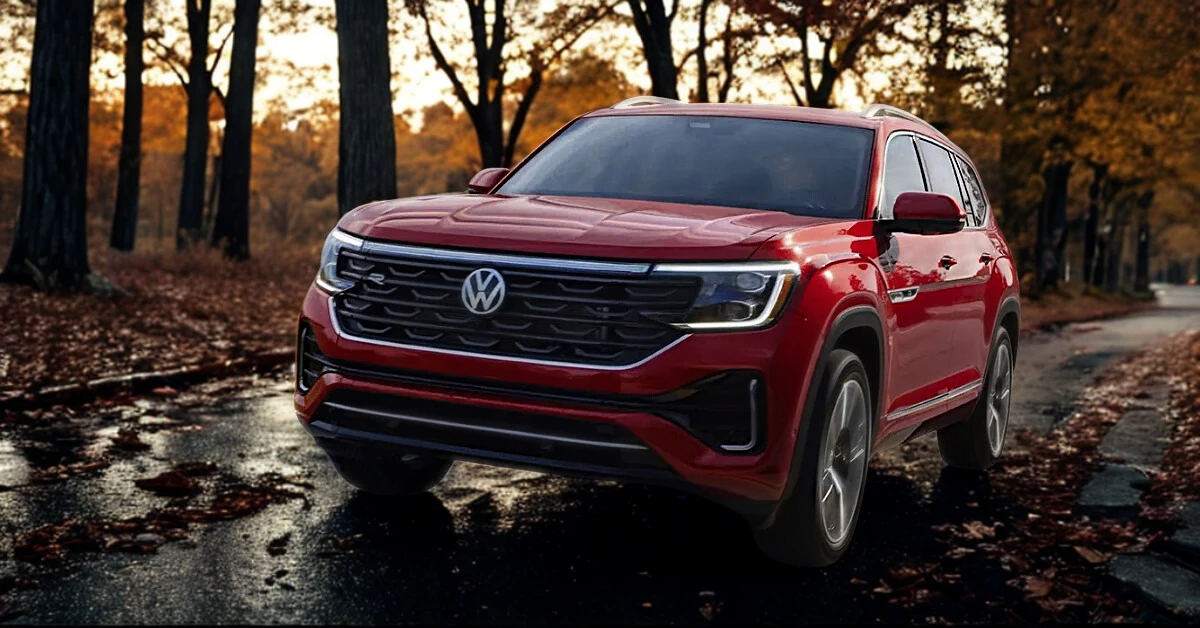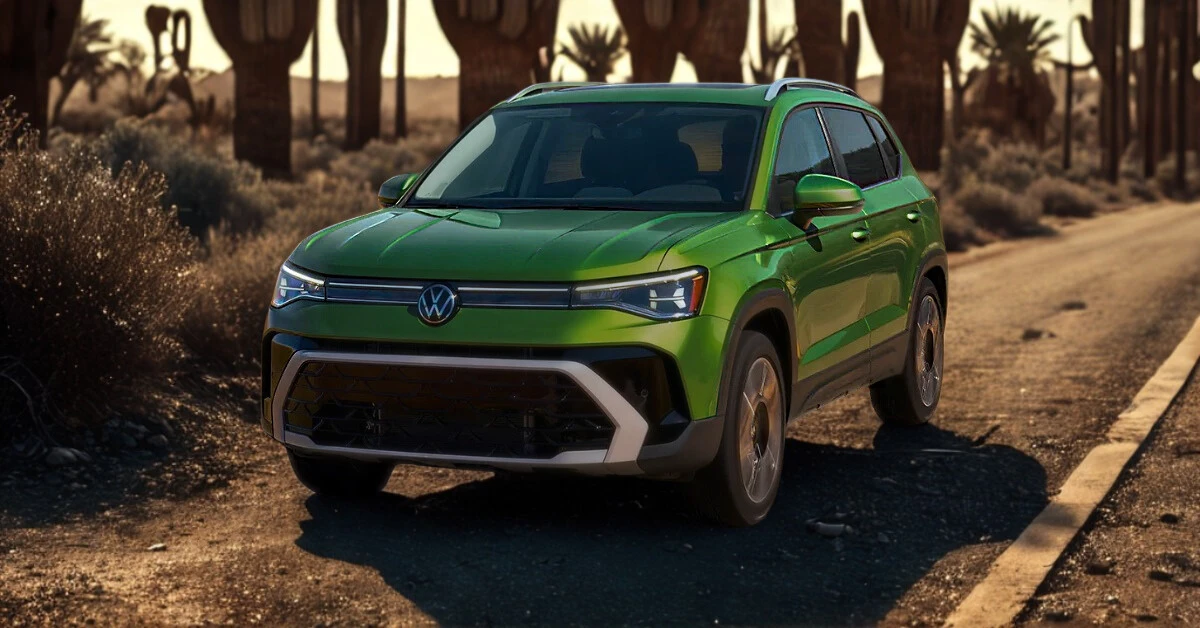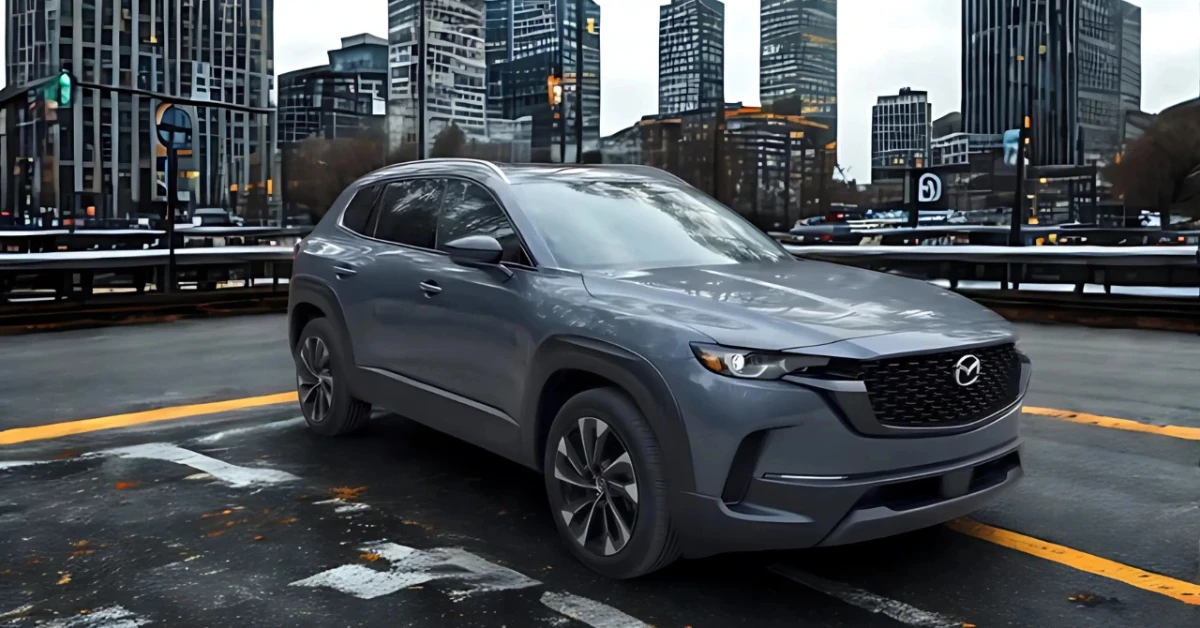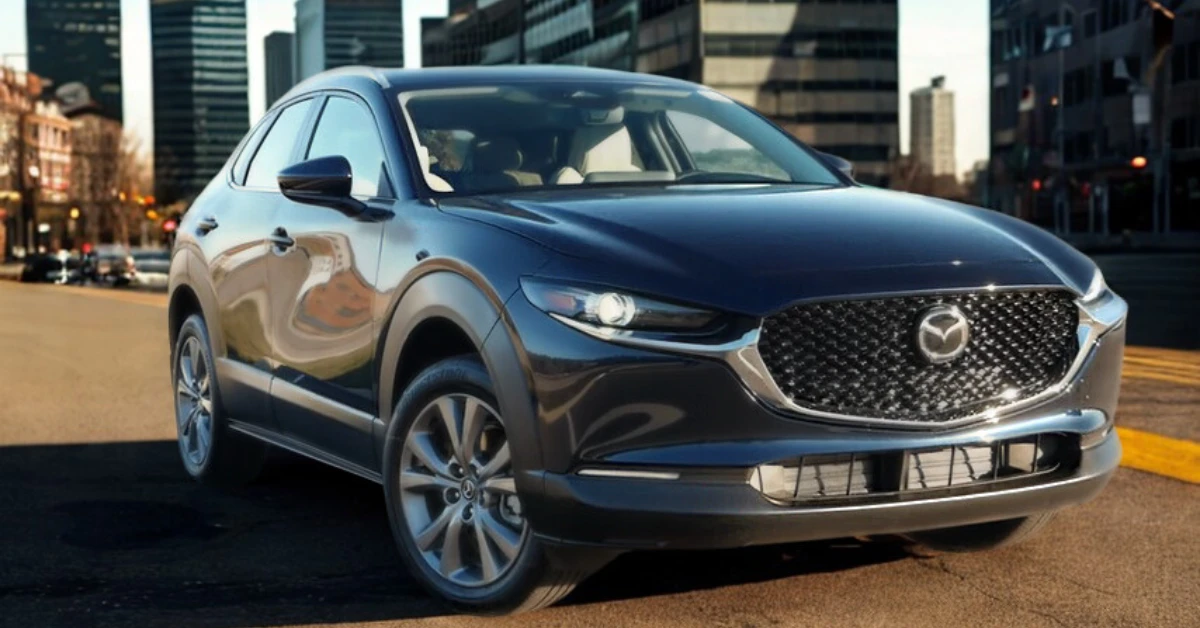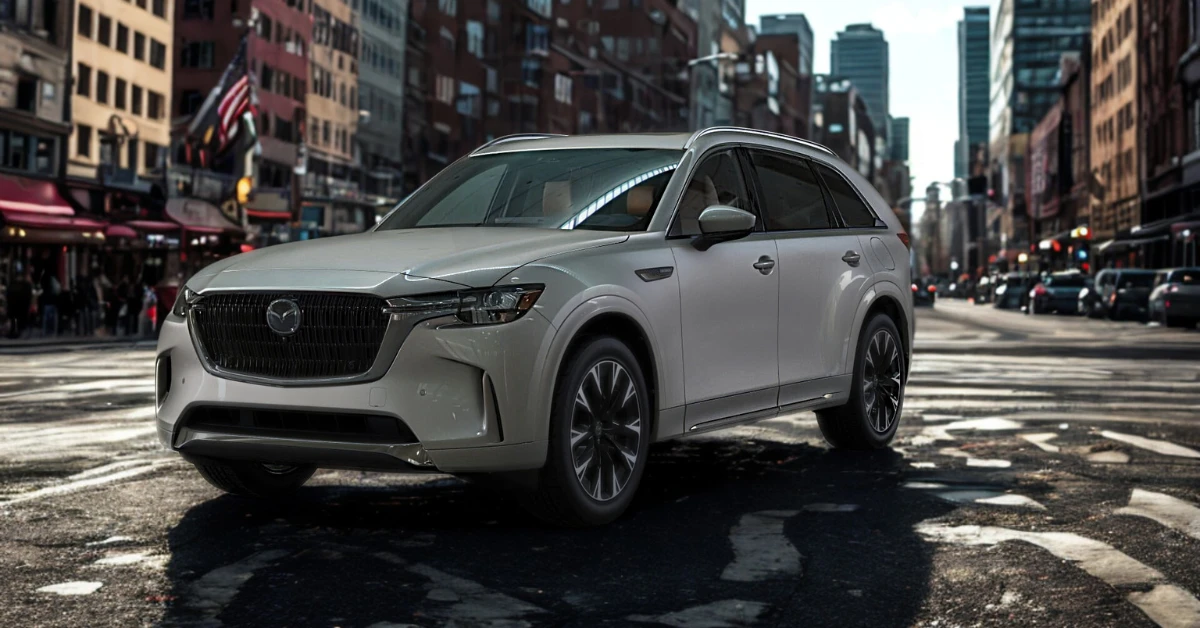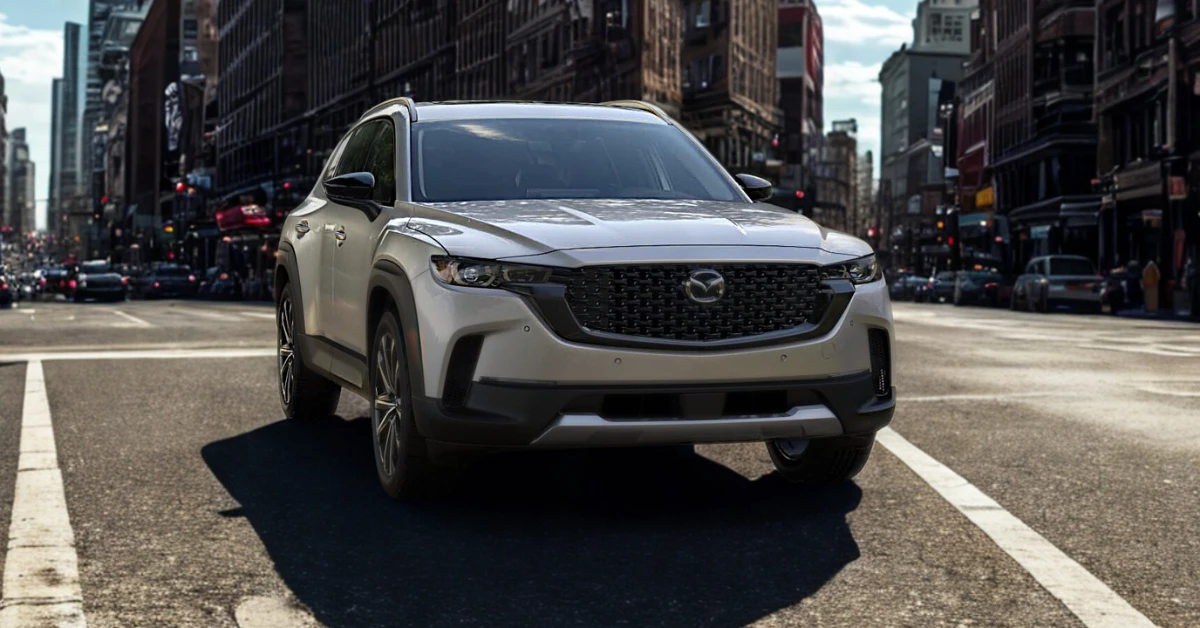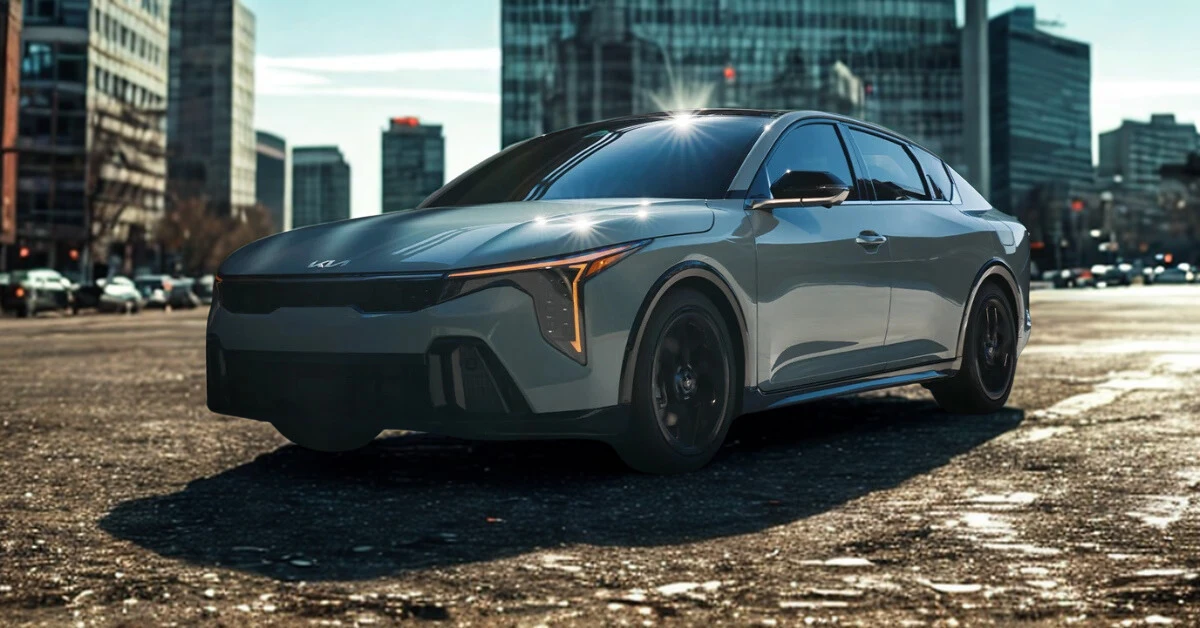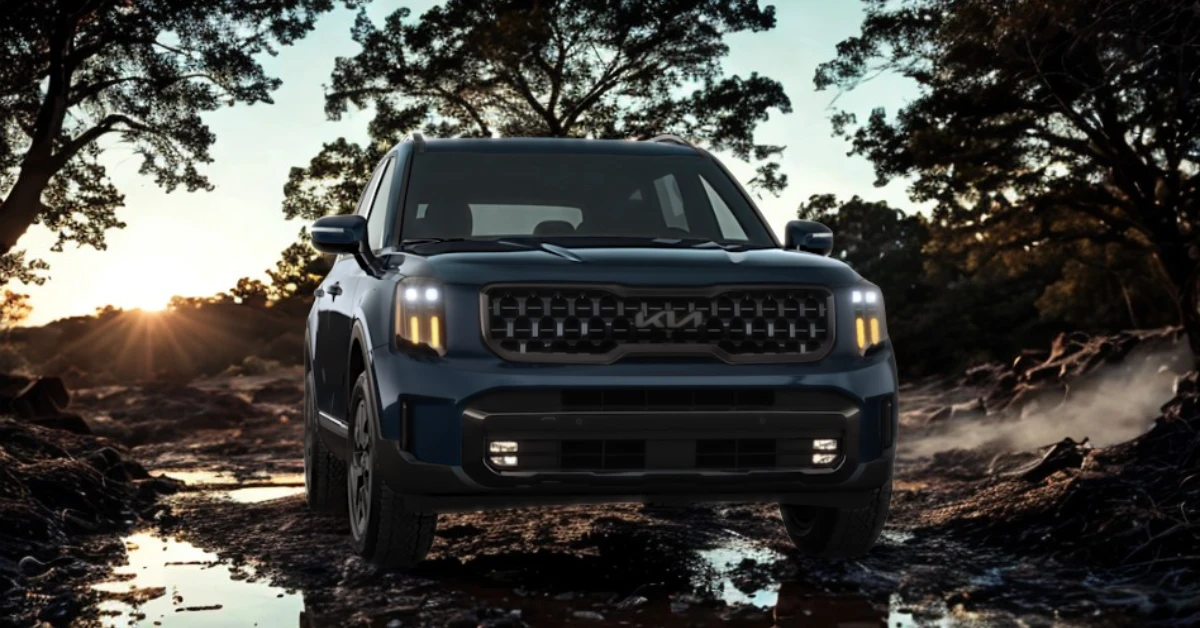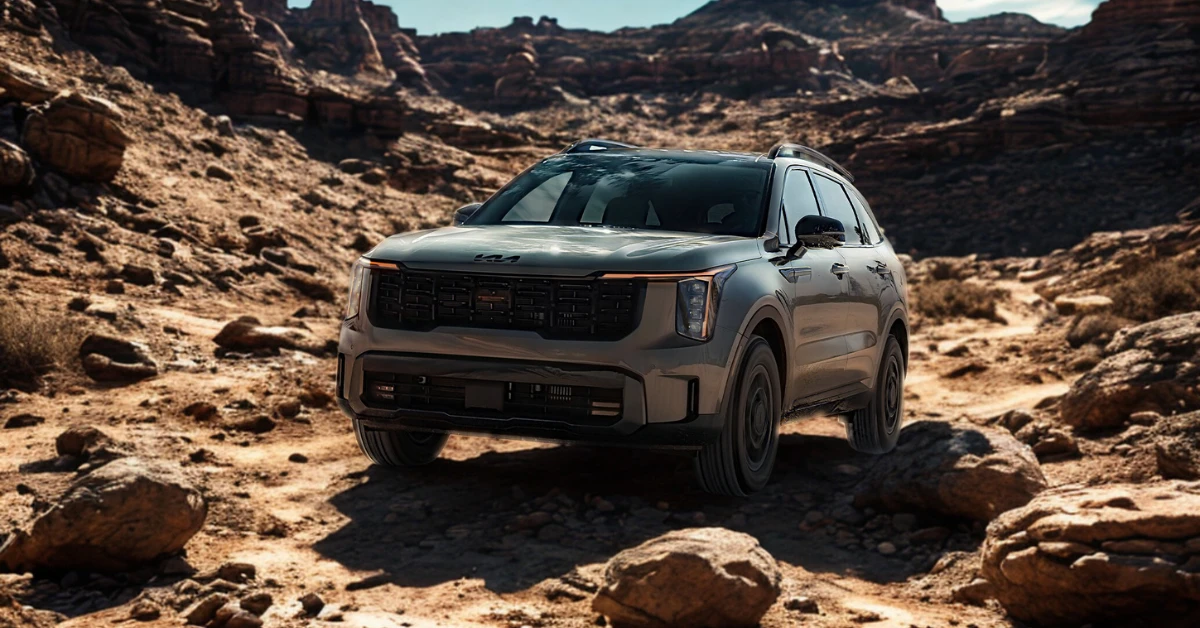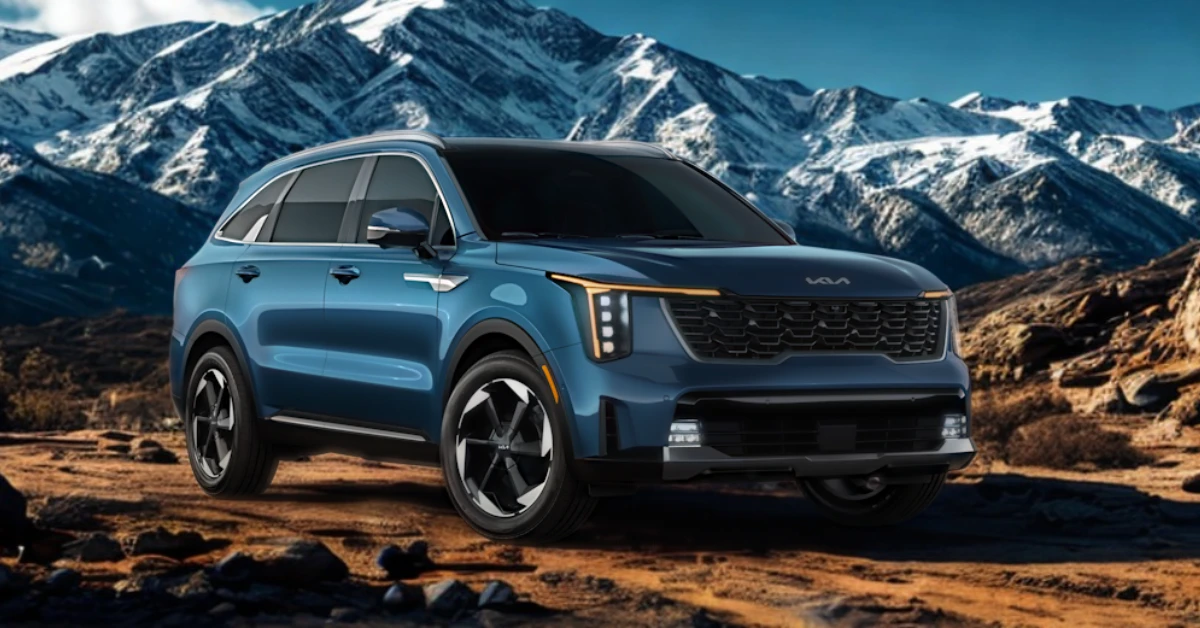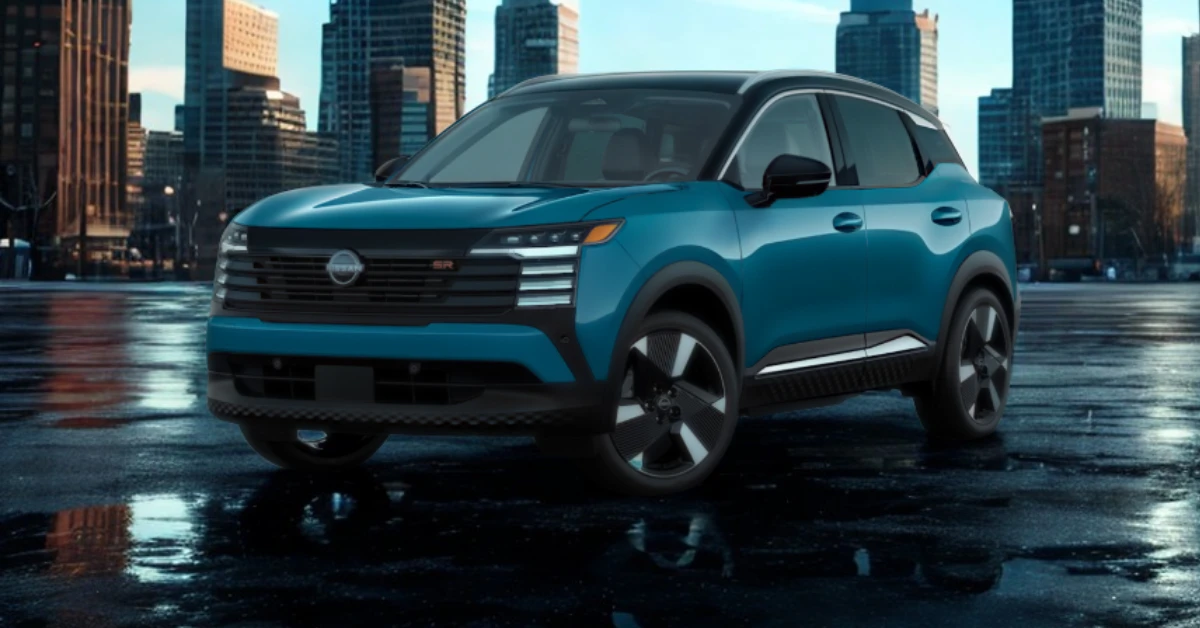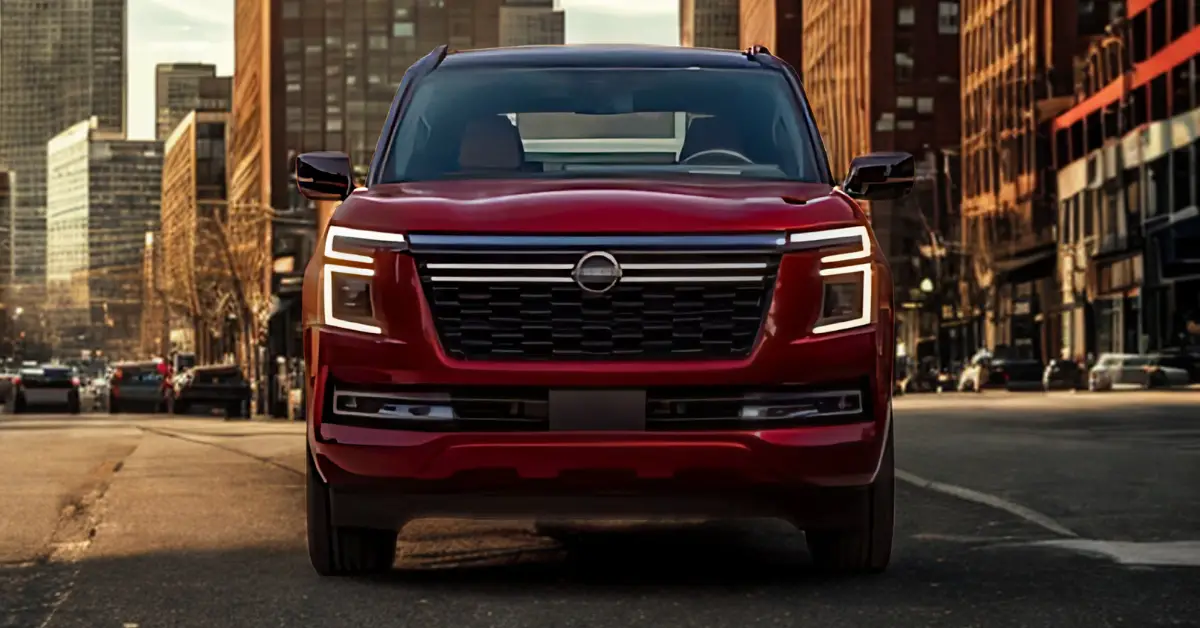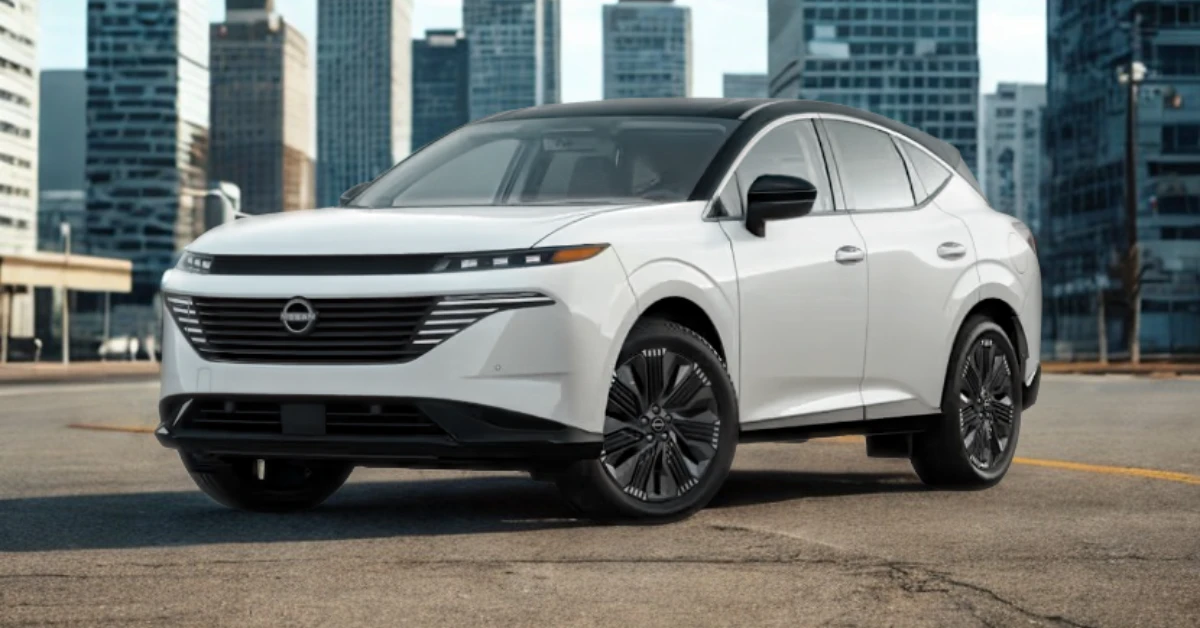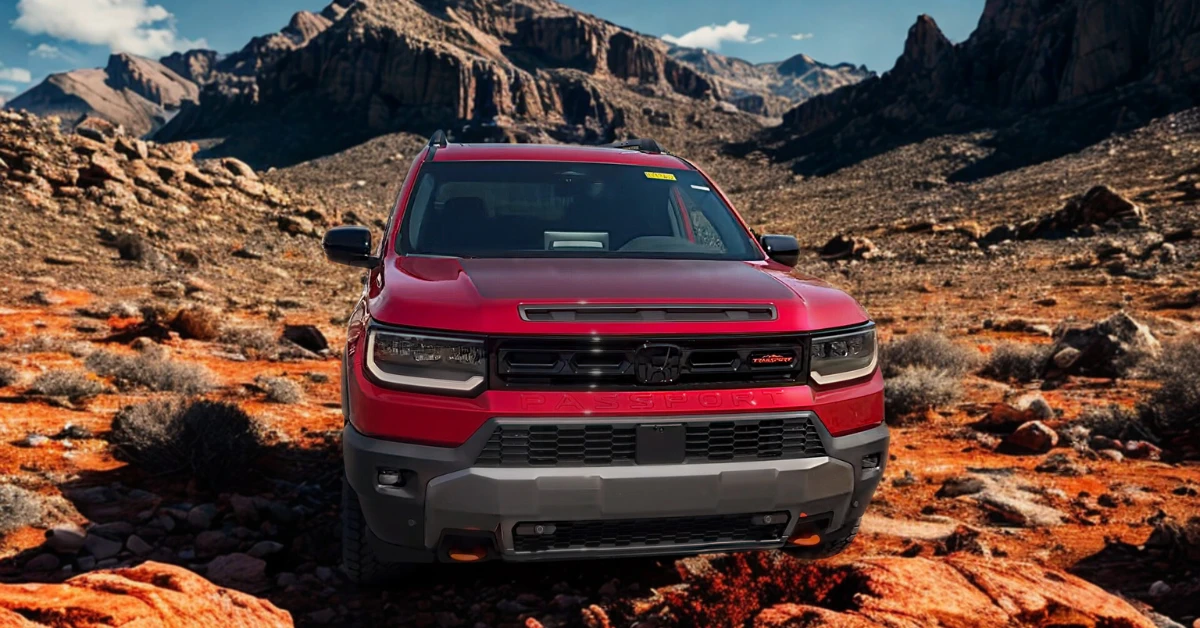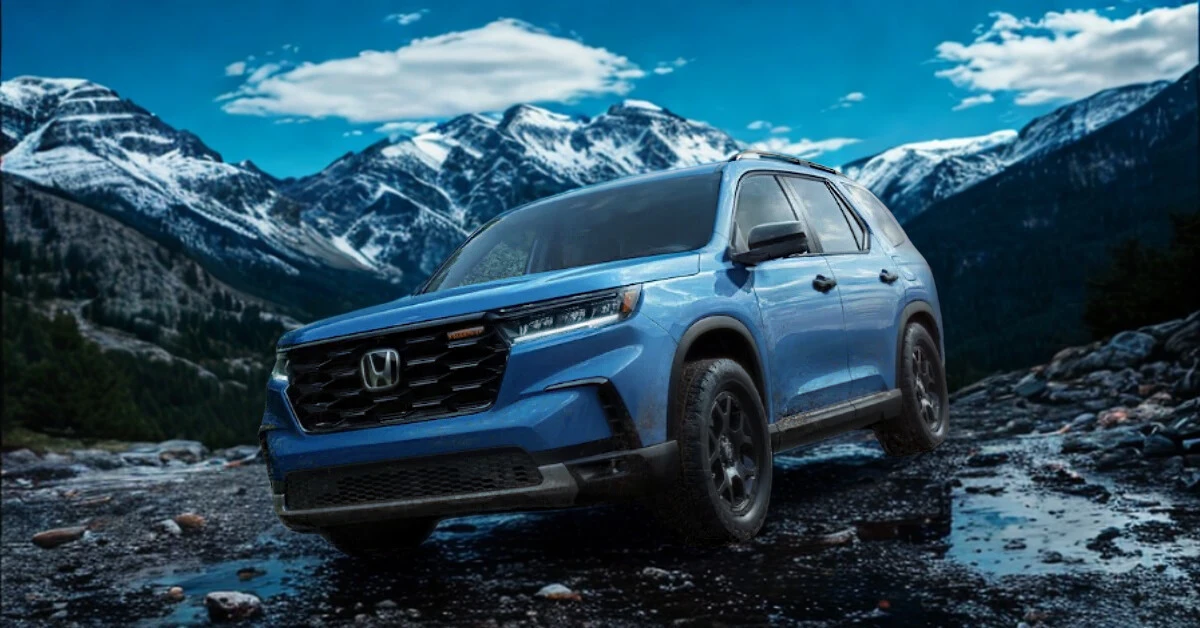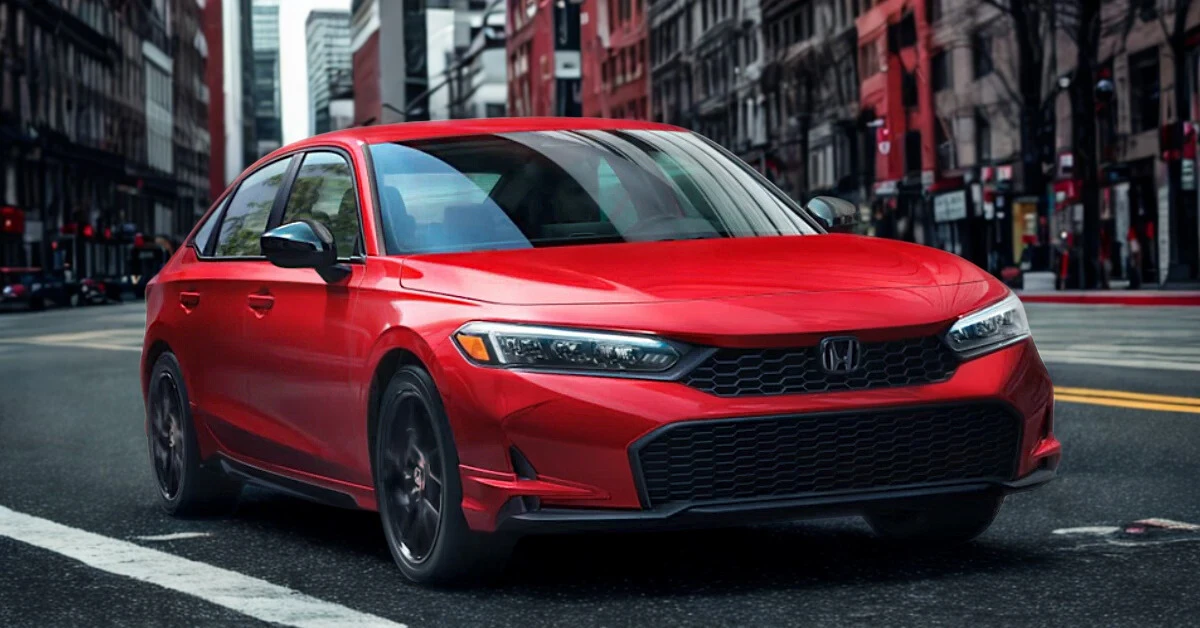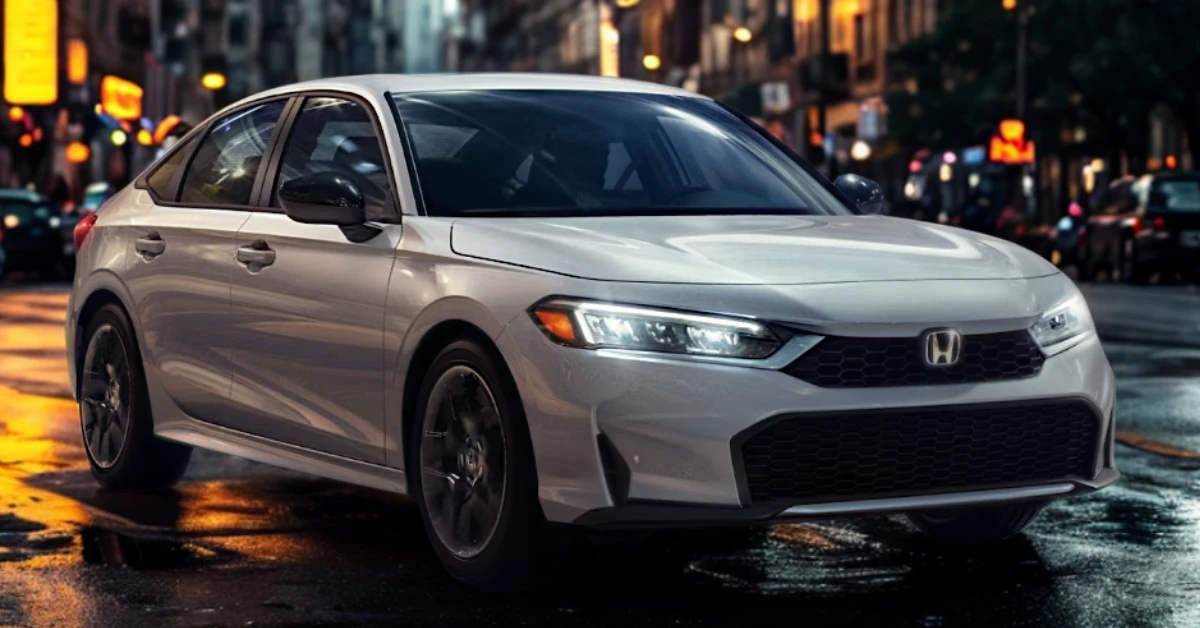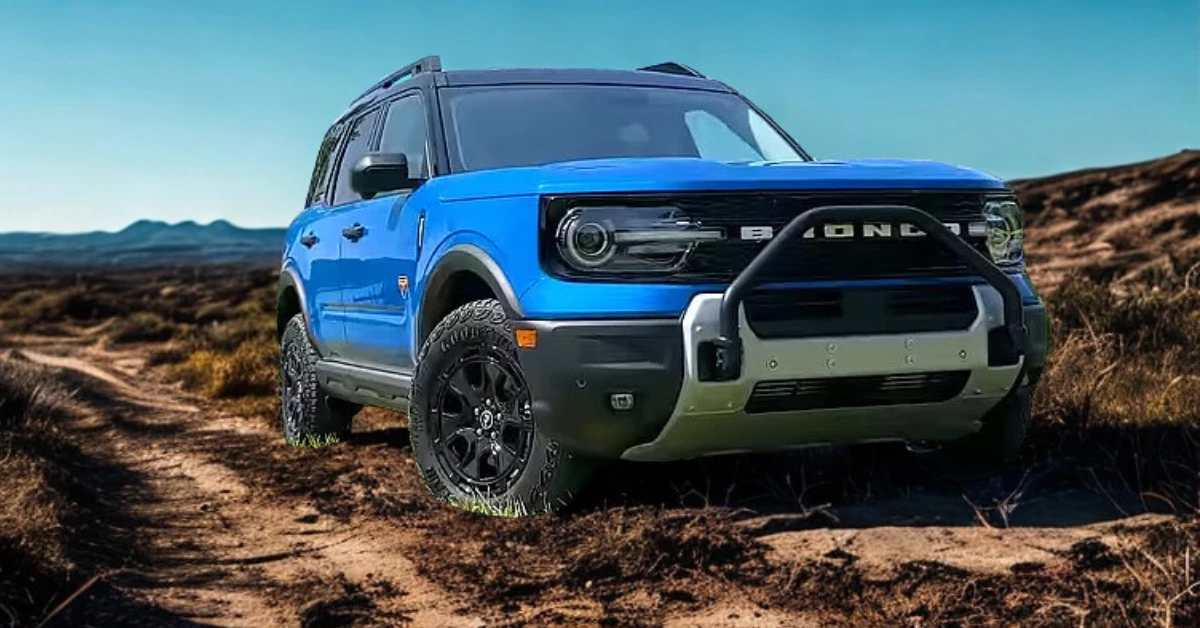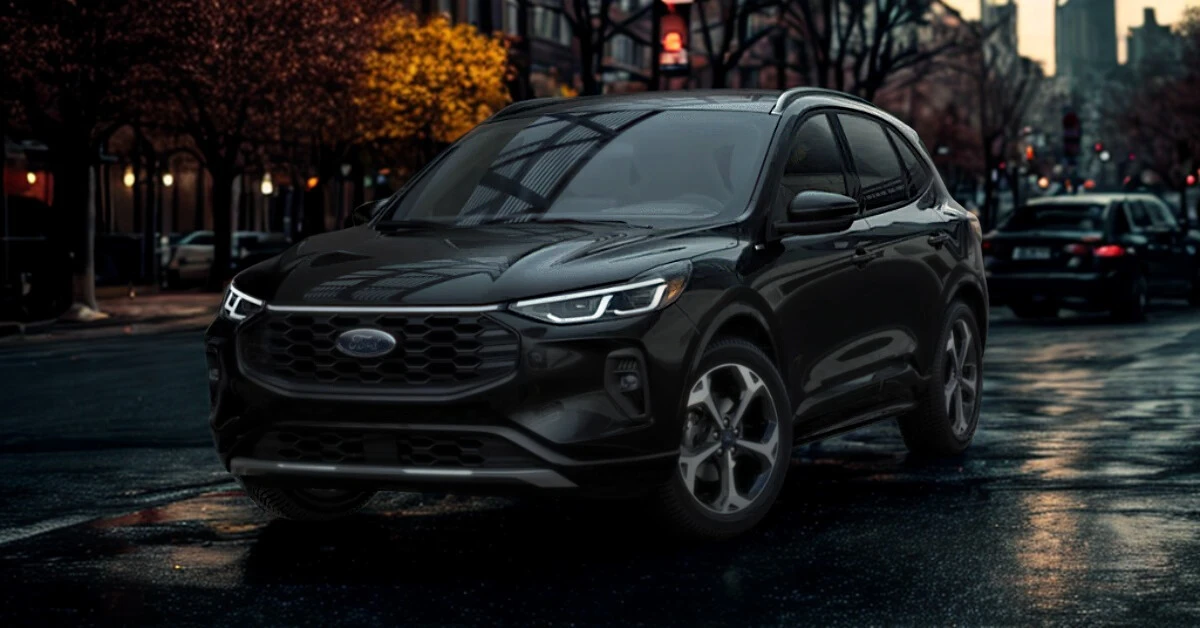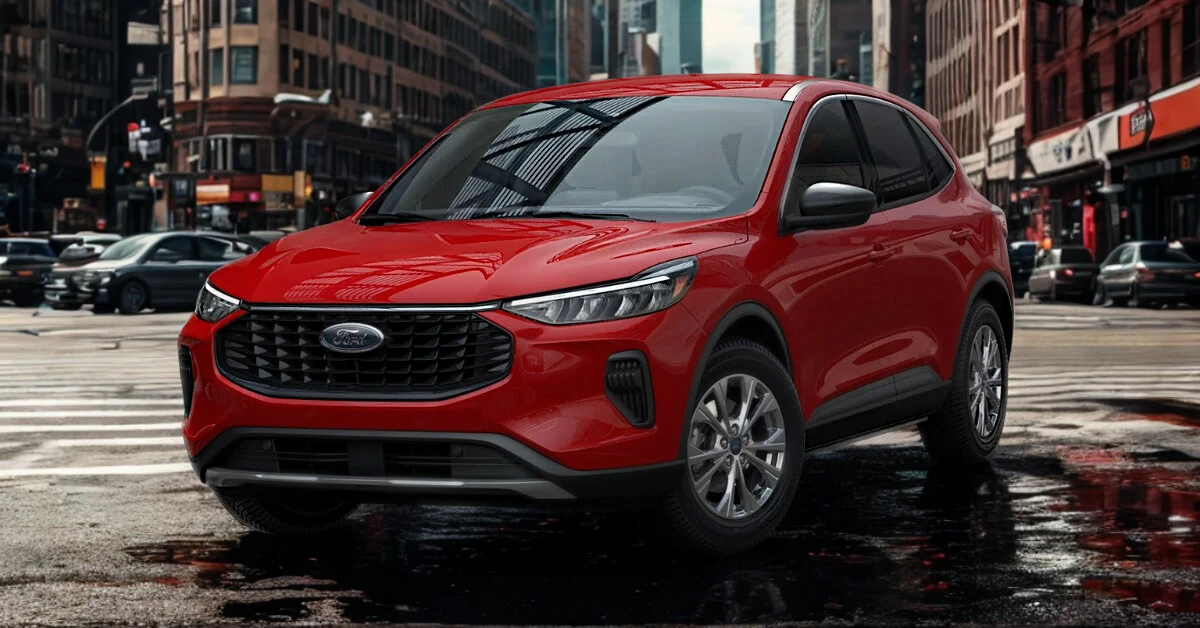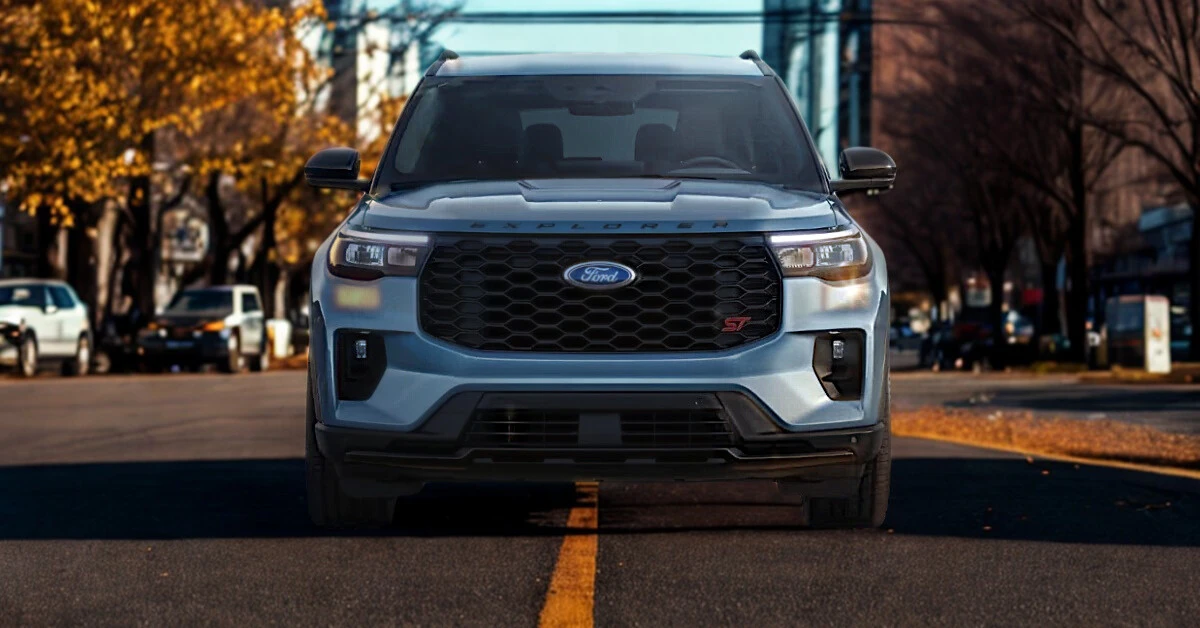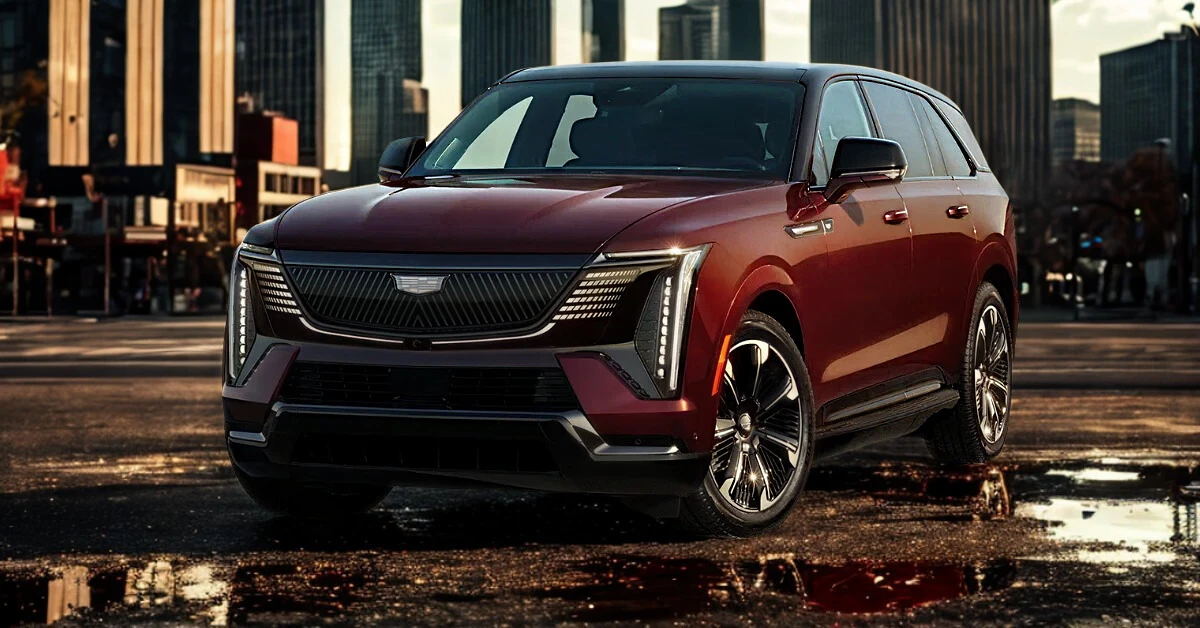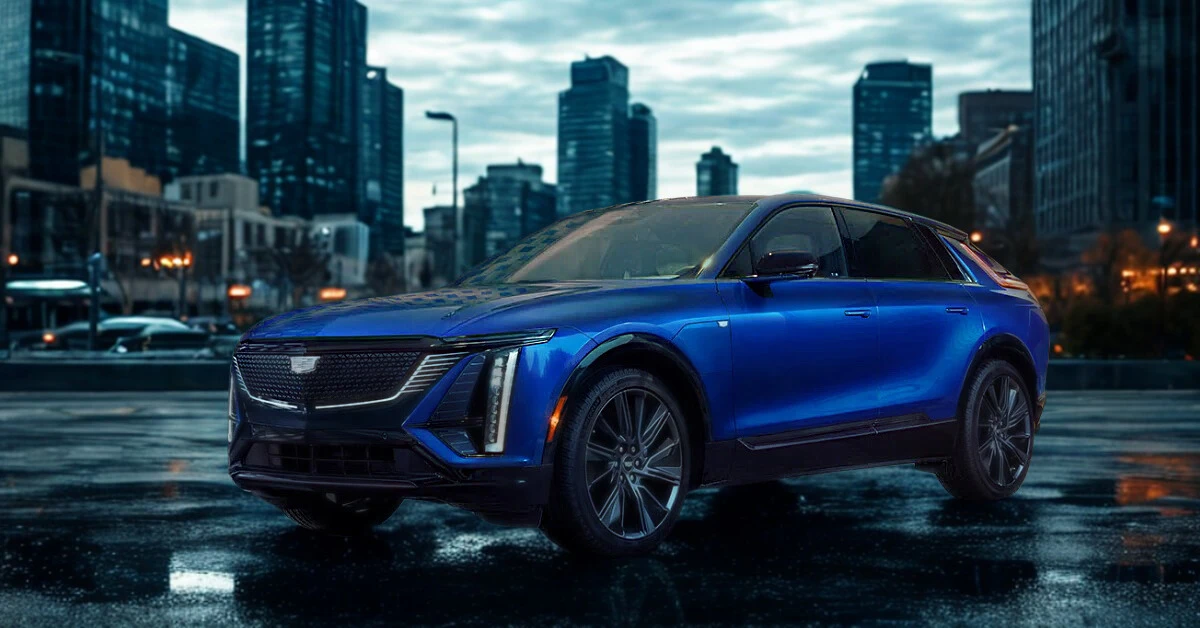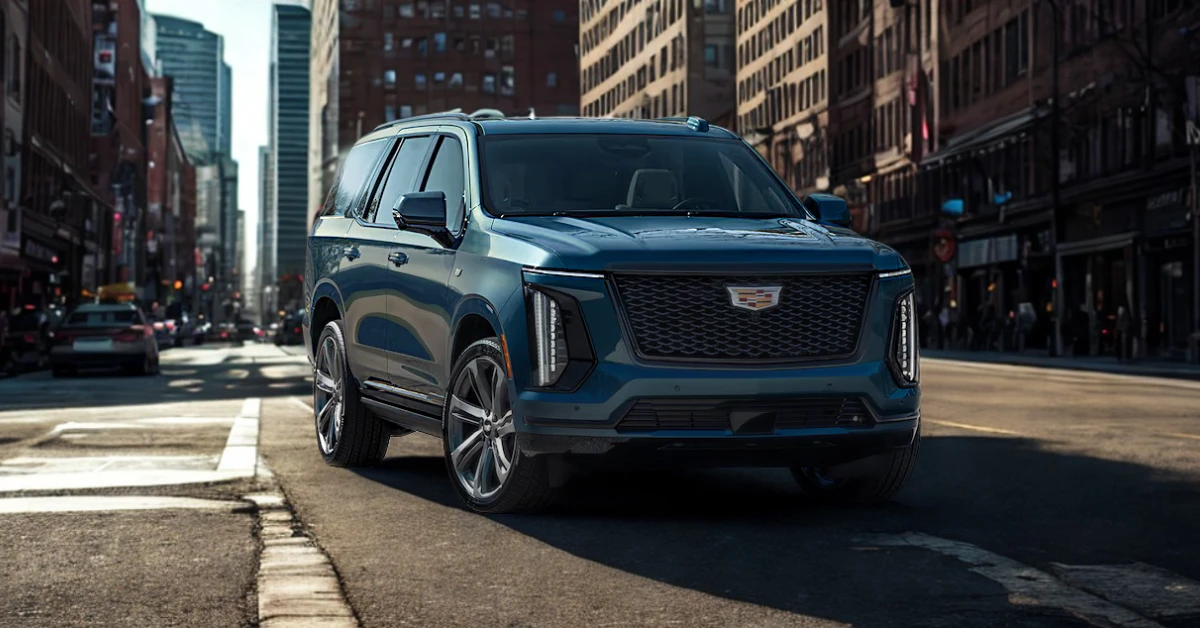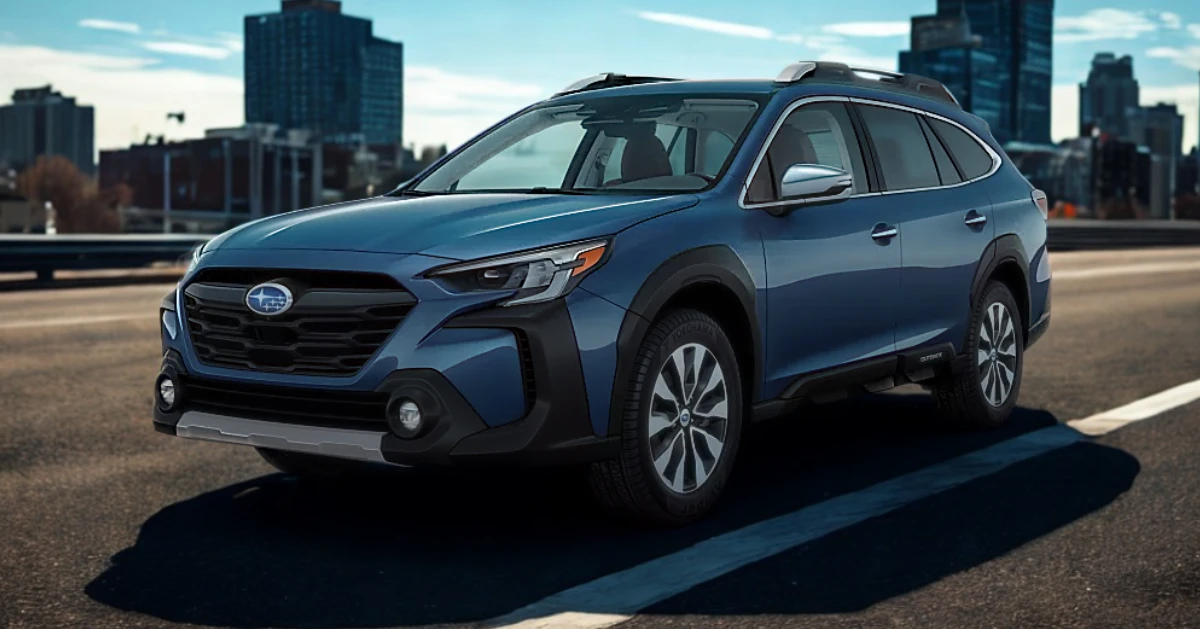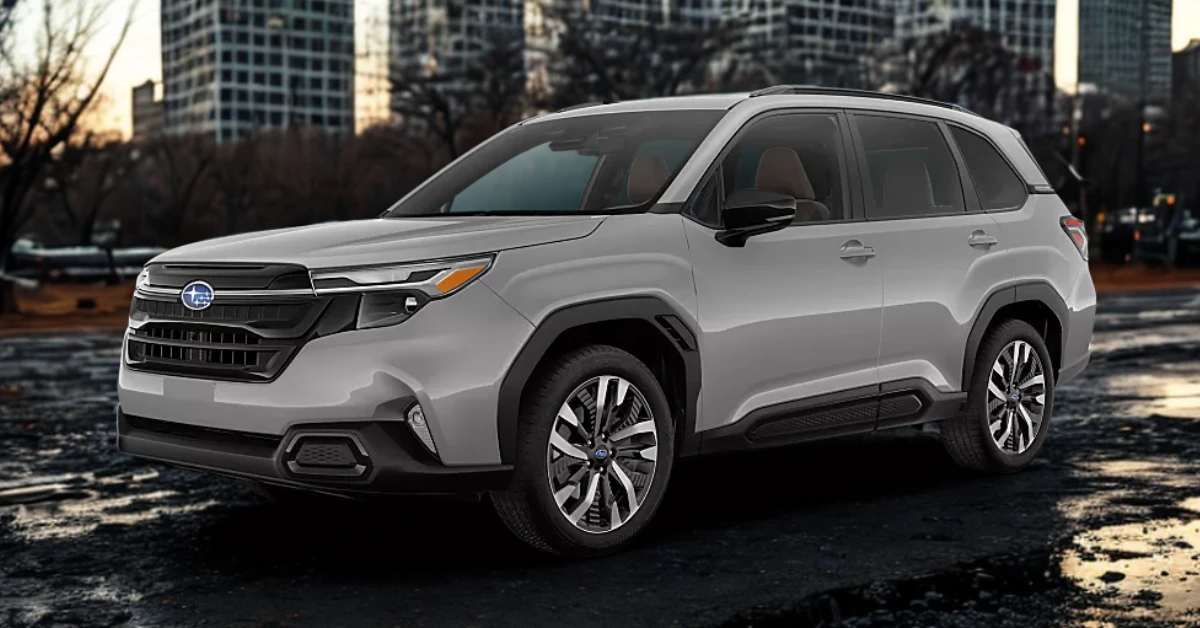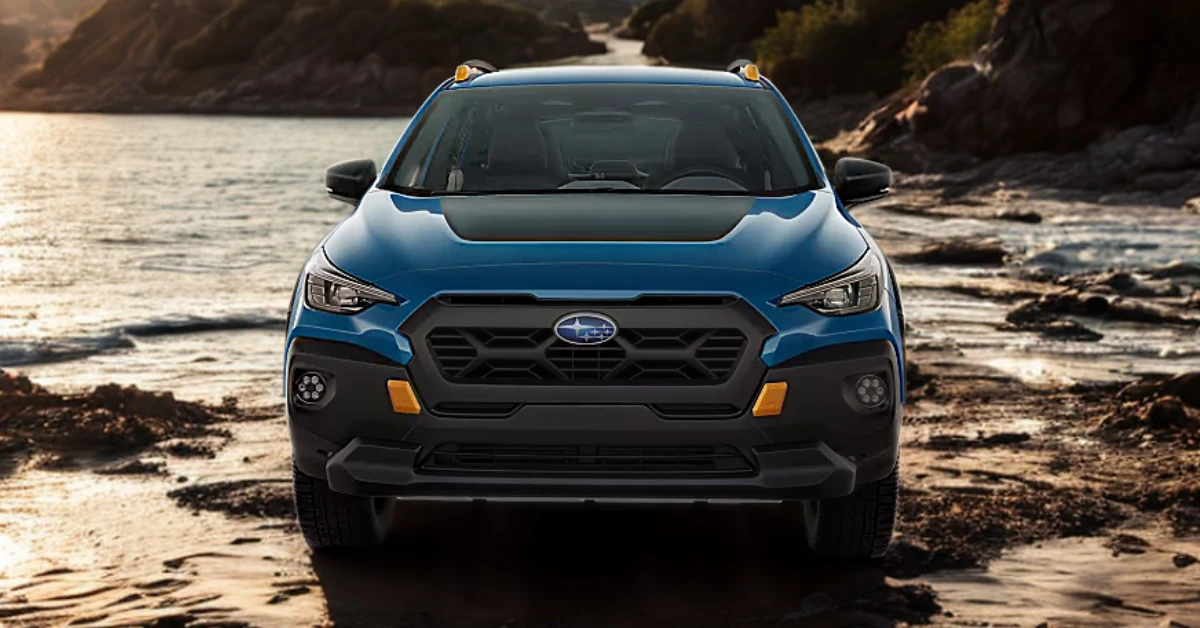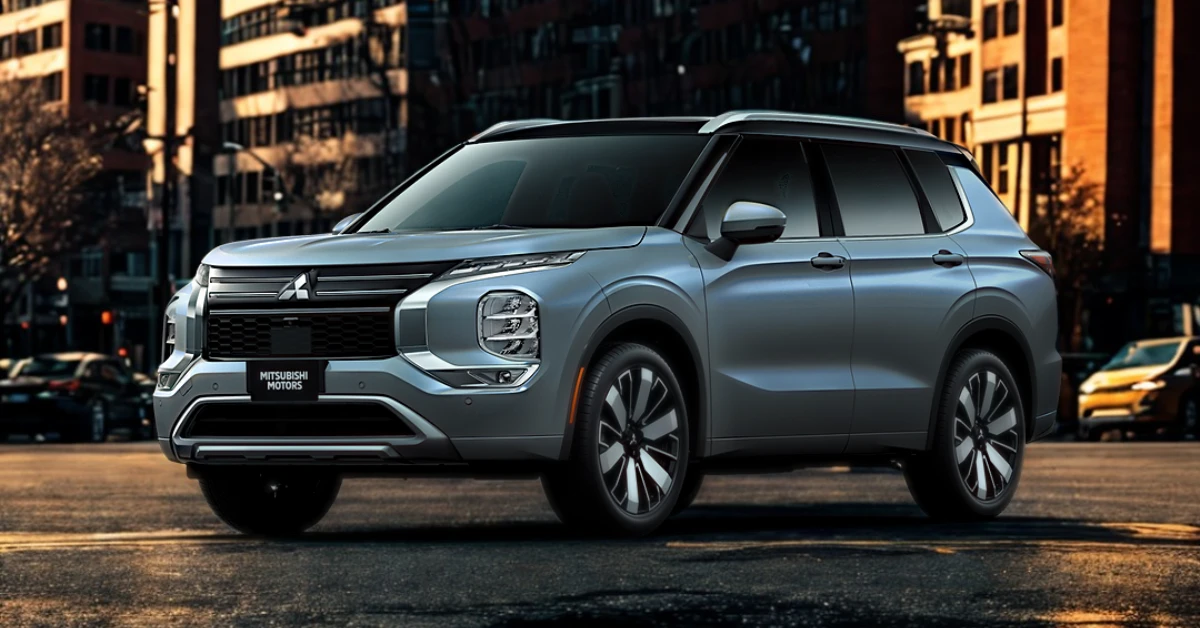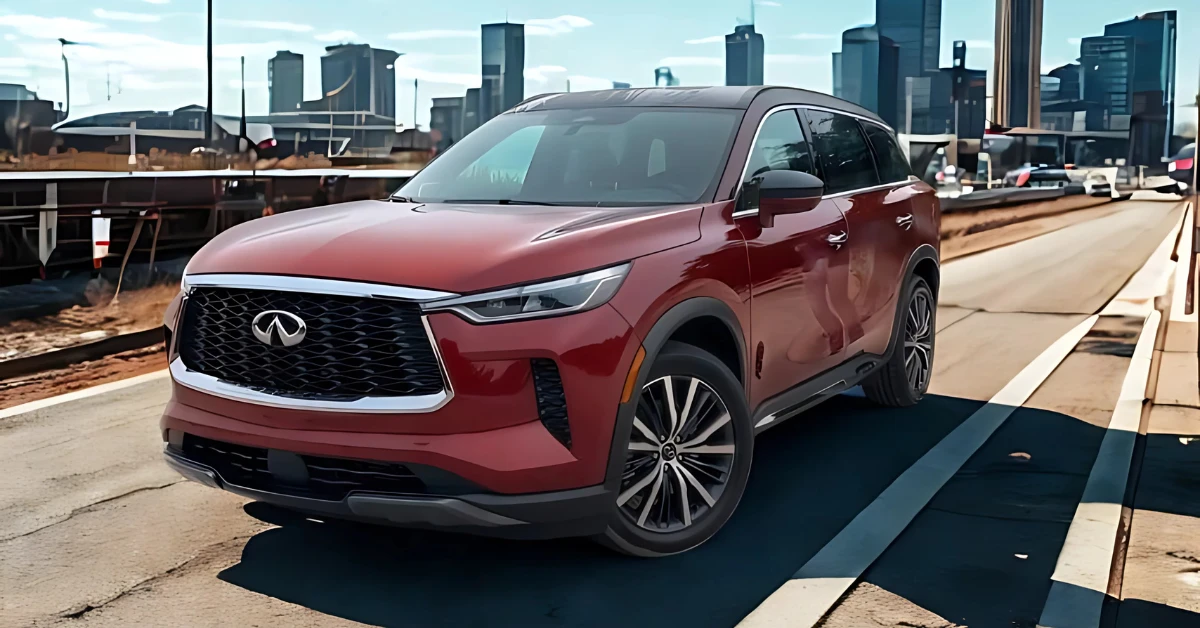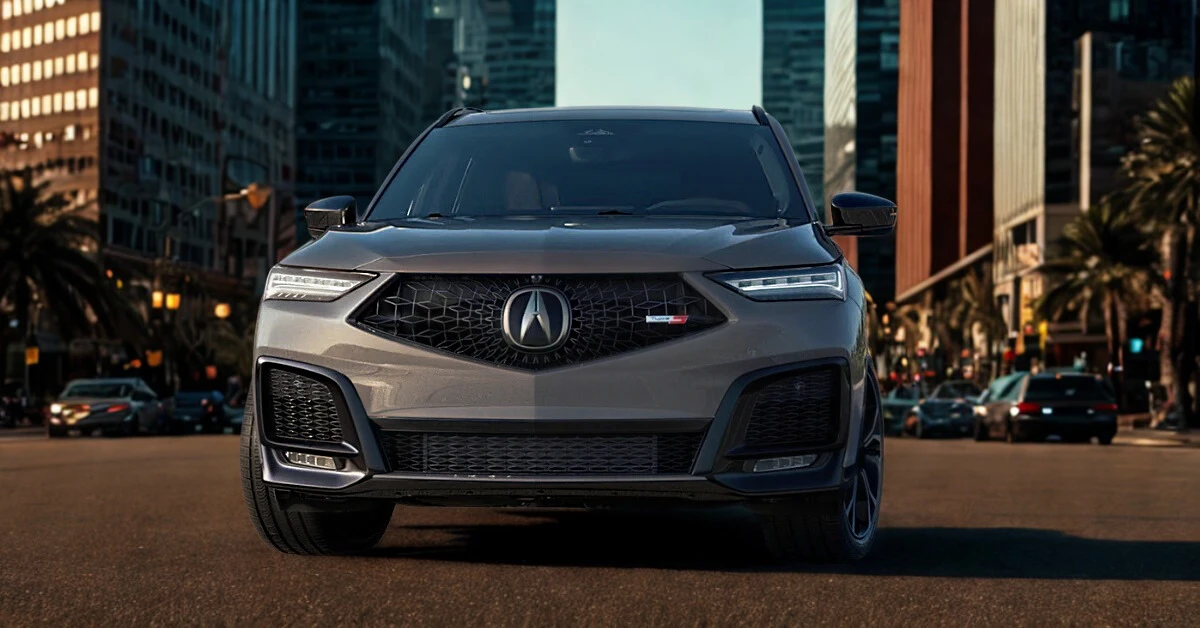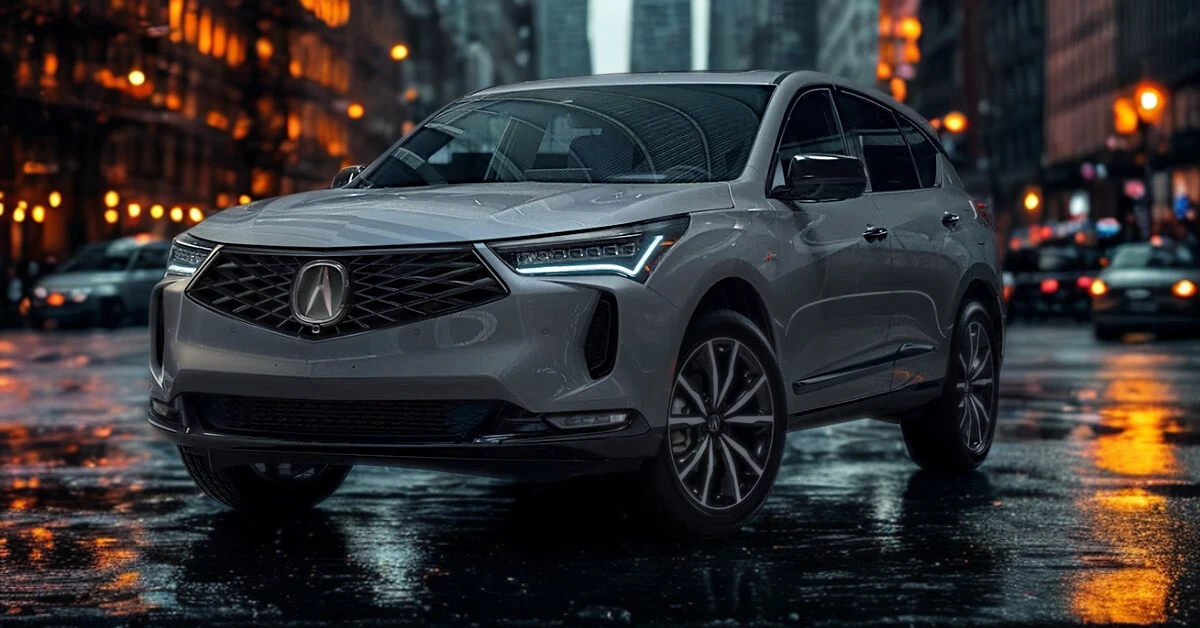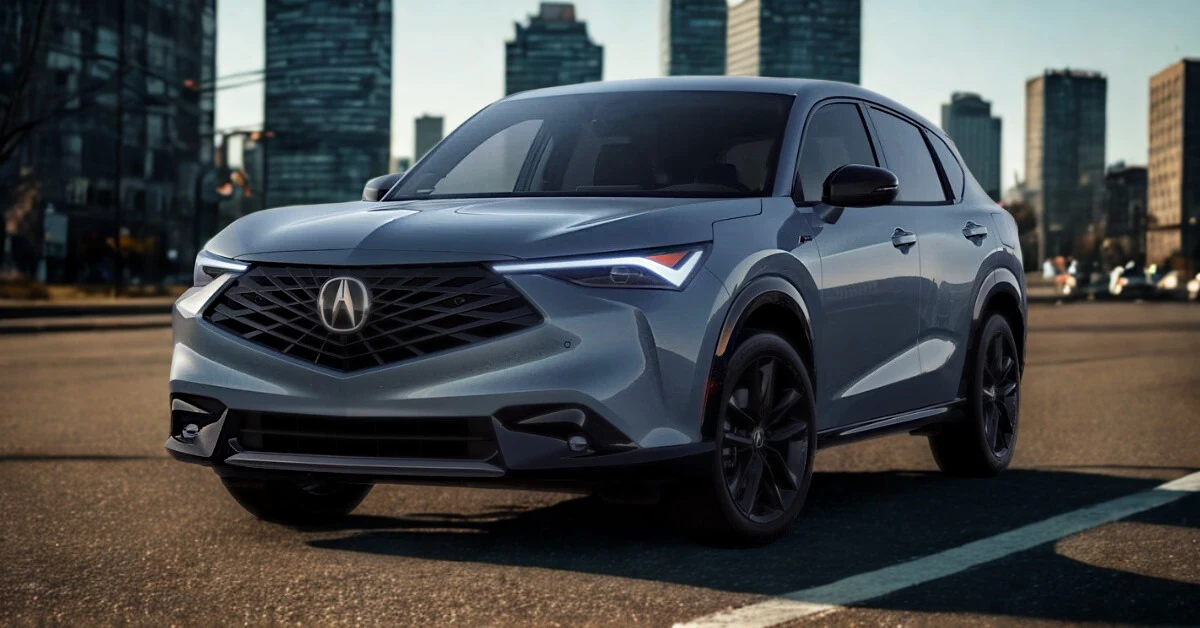- POWERTRAINS
- TRIMS
- COLORS
- DIMENSIONS
| Specification | S FWD | S 4MOTION | SE FWD | SE 4MOTION | SE R-Line Black FWD | SE R-Line Black 4MOTION | SEL R-Line 4MOTION |
|---|---|---|---|---|---|---|---|
| Base Price | $30,920 | $32,420 | $33,720 | $35,220 | $36,880 | $38,420 | $41,180 |
| Engine Type | 2.0L TSI Turbo I-4 | 2.0L TSI Turbo I-4 | 2.0L TSI Turbo I-4 | 2.0L TSI Turbo I-4 | 2.0L TSI Turbo I-4 | 2.0L TSI Turbo I-4 | 2.0L TSI Turbo I-4 |
| Fuel Type | Regular Unleaded | Regular Unleaded | Regular Unleaded | Regular Unleaded | Regular Unleaded | Regular Unleaded | Regular Unleaded |
| Displacement | 2.0L/121 cu. in. | 2.0L/121 cu. in. | 2.0L/121 cu. in. | 2.0L/121 cu. in. | 2.0L/121 cu. in. | 2.0L/121 cu. in. | 2.0L/121 cu. in. |
| Fuel System | Gasoline Direct Injection | Gasoline Direct Injection | Gasoline Direct Injection | Gasoline Direct Injection | Gasoline Direct Injection | Gasoline Direct Injection | Gasoline Direct Injection |
| Horsepower | 201 @ 5000 rpm | 201 @ 5000 rpm | 201 @ 5000 rpm | 201 @ 5000 rpm | 201 @ 5000 rpm | 201 @ 5000 rpm | 201 @ 5000 rpm |
| Torque | 206 lb-ft @ 1500 rpm | 221 lb-ft @ 1500 rpm | 206 lb-ft @ 1500 rpm | 221 lb-ft @ 1500 rpm | 206 lb-ft @ 1500 rpm | 221 lb-ft @ 1500 rpm | 221 lb-ft @ 1500 rpm |
| Transmission | 8-Speed Automatic | 8-Speed Automatic w/ Drive Modes | 8-Speed Automatic | 8-Speed Automatic w/ Drive Modes | 8-Speed Automatic | 8-Speed Automatic w/ Drive Modes | 8-Speed Automatic w/ Drive Modes |
| Transmission Code | PS | PJ | PS | PJ | PS | PJ | PJ |
| Drive Type | Front-Wheel Drive | All-Wheel Drive | Front-Wheel Drive | All-Wheel Drive | Front-Wheel Drive | All-Wheel Drive | All-Wheel Drive |
| Final Drive Ratio | 3.33:1 | 3.33:1 | 3.33:1 | 3.33:1 | 3.33:1 | 3.33:1 | 3.33:1 |
| Fuel Economy (city/hwy/combined) | 23/30/26 mpg | 22/29/25 mpg | 23/30/26 mpg | 22/29/25 mpg | 23/30/26 mpg | 22/29/24 mpg | 22/29/24 mpg |
| Fuel Tank Capacity | 15.6 gal. | 15.6 gal. | 15.6 gal. | 15.6 gal. | 15.6 gal. | 15.6 gal. | 15.6 gal. |
| Range (city/hwy) | 359/468 miles | 343/452 miles | 359/468 miles | 343/452 miles | 359/468 miles | 343/452 miles | 343/452 miles |
| Max Towing Capacity | 1,500 lbs | 1,800 lbs | 1,500 lbs | 1,800 lbs | 1,500 lbs | 1,800 lbs | 1,800 lbs |
| Curb Weight | 3,563 lbs | 3,801 lbs | 3,607 lbs | 3,801 lbs | 3,607 lbs | 3,801 lbs | 3,801 lbs |
| Suspension Type (F/R) | Strut / Multi-Link | Strut / Multi-Link | Strut / Multi-Link | Strut / Multi-Link | Strut / Multi-Link | Strut / Multi-Link | Strut / Multi-Link |
| Ground Clearance | 7.0 inches | 7.0 inches | 7.0 inches | 7.0 inches | 7.0 inches | 7.0 inches | 7.0 inches |
| Wheel Size | 17″ x 7″ | 17″ x 7″ | 19″ x 8.5″ | 19″ x 8.5″ | 20″ x 8.5″ | 20″ x 8.5″ | 20″ x 8.5″ |
| Tire Size | P215/65HR17 | P215/65HR17 | P235/50HR19 | P235/50HR19 | P255/40HR20 | P255/40HR20 | P255/40HR20 |
| Special Features | Engine Start-Stop, Travel Assist | Engine Start-Stop, Travel Assist, Hill Descent Control | Engine Start-Stop, Travel Assist | Engine Start-Stop, Travel Assist, Hill Descent Control | Engine Start-Stop, Travel Assist, Sunroof | Engine Start-Stop, Travel Assist, Hill Descent Control, Sunroof | Engine Start-Stop, Travel Assist, Hill Descent Control, Premium Audio |
Interior Features
| Feature | S FWD | S 4MOTION | SE FWD | SE 4MOTION | SE R-Line Black FWD | SE R-Line Black 4MOTION | SEL R-Line 4MOTION |
|---|---|---|---|---|---|---|---|
| Seating | Cloth Seating Surfaces | Cloth Seating Surfaces | Perforated V-Tex Leatherette | Perforated V-Tex Leatherette | Perforated V-Tex Leatherette | Perforated V-Tex Leatherette | Perforated Varenna Leather |
| Driver’s Seat | 6-way manual | 6-way manual | 8-way power w/ lumbar | 8-way power w/ lumbar | 8-way power w/ lumbar | 8-way power w/ lumbar | 8-way power w/ lumbar & memory |
| Passenger Seat | 6-way manual | 6-way manual | 6-way manual w/ height adj. | 6-way manual w/ height adj. | 6-way manual w/ height adj. | 6-way manual w/ height adj. | Power adjustable w/ lumbar |
| Heated Front Seats | Standard | Standard | Standard | Standard | Standard | Standard | Standard w/ Ventilation |
| Heated Rear Seats | Not Available | Not Available | Not Available | Not Available | Not Available | Not Available | Standard |
| Climate Control | Dual Zone Automatic | Dual Zone Automatic | Dual Zone Automatic | Dual Zone Automatic | Dual Zone Automatic | Dual Zone Automatic | Dual Zone w/ Rear Controls |
| Steering Wheel | Leatherette | Leatherette | Leatherette | Leatherette | Sport Leather | Sport Leather | Sport Heated Leather |
| Cargo Space Behind 2nd Row | 26.5 cu. ft. | 26.5 cu. ft. | 26.5 cu. ft. | 26.5 cu. ft. | 26.5 cu. ft. | 26.5 cu. ft. | 26.5 cu. ft. |
| Cargo Space Behind 1st Row | 58.9 cu. ft. | 58.9 cu. ft. | 58.9 cu. ft. | 58.9 cu. ft. | 58.9 cu. ft. | 58.9 cu. ft. | 58.9 cu. ft. |
| Sunroof | Not Available | Not Available | Not Available | Not Available | Express Open/Close Sliding & Tilting | Express Open/Close Sliding & Tilting | Express Open/Close Sliding & Tilting |
| Interior Trim | Metal-Look w/ Cloth Dashboard | Metal-Look w/ Cloth Dashboard | Metal-Look w/ Leatherette Dashboard | Metal-Look w/ Leatherette Dashboard | Metal-Look w/ Leatherette Dashboard | Metal-Look w/ Leatherette Dashboard | Genuine Wood w/ Leatherette Dashboard |
Technology
| Feature | S FWD | S 4MOTION | SE FWD | SE 4MOTION | SE R-Line Black FWD | SE R-Line Black 4MOTION | SEL R-Line 4MOTION |
|---|---|---|---|---|---|---|---|
| Infotainment | MIB4 Composition Media 12.9″ Touchscreen | MIB4 Composition Media 12.9″ Touchscreen | MIB4 Composition Media 12.9″ Touchscreen | MIB4 Composition Media 12.9″ Touchscreen | MIB4 Composition Media 12.9″ Touchscreen | MIB4 Composition Media 12.9″ Touchscreen | MIB4 Discover Media 15″ Touchscreen Nav |
| Smartphone Integration | Wireless Apple CarPlay & Android Auto | Wireless Apple CarPlay & Android Auto | Wireless Apple CarPlay & Android Auto | Wireless Apple CarPlay & Android Auto | Wireless Apple CarPlay & Android Auto | Wireless Apple CarPlay & Android Auto | Wireless Apple CarPlay & Android Auto |
| Audio System | 7-speaker (6 + center) | 7-speaker (6 + center) | 7-speaker (6 + center) | 7-speaker (6 + center) | 7-speaker (6 + center) | 7-speaker (6 + center) | 12-speaker harman kardon Premium |
| SiriusXM | 3-month trial w/360L | 3-month trial w/360L | 3-month trial w/360L | 3-month trial w/360L | 3-month trial w/360L | 3-month trial w/360L | 3-month trial w/360L |
| 4G LTE Wi-Fi | Standard (trial included) | Standard (trial included) | Standard (trial included) | Standard (trial included) | Standard (trial included) | Standard (trial included) | Standard (trial included) |
| Wireless Charging | 15W Qi Inductive Charger | 15W Qi Inductive Charger | 15W Qi Inductive Charger | 15W Qi Inductive Charger | 15W Qi Inductive Charger | 15W Qi Inductive Charger | 15W Qi Inductive Charger |
| Digital Cockpit | Digital/Analog Appearance | Digital/Analog Appearance | Digital/Analog Appearance | Digital/Analog Appearance | Digital/Analog Appearance w/ HUD | Digital/Analog Appearance w/ HUD | Digital/Analog Appearance w/ HUD |
| Navigation System | Not Standard | Not Standard | Not Standard | Not Standard | Not Standard | Not Standard | Integrated w/ Voice Activation |
Safety & Driver Assistance
| Feature | S FWD | S 4MOTION | SE FWD | SE 4MOTION | SE R-Line Black FWD | SE R-Line Black 4MOTION | SEL R-Line 4MOTION |
|---|---|---|---|---|---|---|---|
| VW Car-Net Safe & Secure | 5-year included | 5-year included | 5-year included | 5-year included | 5-year included | 5-year included | 5-year included |
| Front Assist | Forward Collision Warning & Auto Emergency Braking | Forward Collision Warning & Auto Emergency Braking | Forward Collision Warning & Auto Emergency Braking | Forward Collision Warning & Auto Emergency Braking | Forward Collision Warning & Auto Emergency Braking | Forward Collision Warning & Auto Emergency Braking | Forward Collision Warning & Auto Emergency Braking |
| Active Side Assist | Blind Spot Monitoring | Blind Spot Monitoring | Blind Spot Monitoring | Blind Spot Monitoring | Blind Spot Monitoring | Blind Spot Monitoring | Blind Spot Monitoring |
| Lane Assist | Lane Keeping & Departure Warning | Lane Keeping & Departure Warning | Lane Keeping & Departure Warning | Lane Keeping & Departure Warning | Lane Keeping & Departure Warning | Lane Keeping & Departure Warning | Lane Keeping & Departure Warning |
| Parking Sensors | Front & Rear | Front & Rear | Front & Rear | Front & Rear | Front & Rear | Front & Rear | Front & Rear w/ Park Assist |
| Adaptive Cruise Control | Stop & Go w/ Travel Assist | Stop & Go w/ Travel Assist | Stop & Go w/ Travel Assist | Stop & Go w/ Travel Assist | Stop & Go w/ Travel Assist | Stop & Go w/ Travel Assist | Stop & Go w/ Travel Assist |
| Camera System | Rear Back-Up w/ Washer | Rear Back-Up w/ Washer | Rear Back-Up w/ Washer | Rear Back-Up w/ Washer | Rear Back-Up w/ Washer | Rear Back-Up w/ Washer | Aerial View 360° Camera System |
| Rear Traffic Alert | Standard | Standard | Standard | Standard | Standard | Standard | Standard |
All-Weather & Off-Road Features
| Feature | S FWD | S 4MOTION | SE FWD | SE 4MOTION | SE R-Line Black FWD | SE R-Line Black 4MOTION | SEL R-Line 4MOTION |
|---|---|---|---|---|---|---|---|
| 4MOTION AWD System | Not Available | Full-Time All-Wheel Drive | Not Available | Full-Time All-Wheel Drive | Not Available | Full-Time All-Wheel Drive | Full-Time All-Wheel Drive |
| Hill Descent Control | Not Available | Standard | Not Available | Standard | Not Available | Standard | Standard |
| Hill Hold Control | Standard | Standard | Standard | Standard | Standard | Standard | Standard |
| Drive Mode Selection | Not Available | Standard w/ Eco Mode | Not Available | Standard w/ Eco Mode | Not Available | Standard w/ Eco Mode | Standard w/ Eco Mode |
| Electronic Stability Control | Standard | Standard | Standard | Standard | Standard | Standard | Standard |
| Traction Control | Standard | Standard | Standard | Standard | Standard | Standard | Standard |
Exterior Features
| Feature | S FWD | S 4MOTION | SE FWD | SE 4MOTION | SE R-Line Black FWD | SE R-Line Black 4MOTION | SEL R-Line 4MOTION |
|---|---|---|---|---|---|---|---|
| Grille | Black | Black | Black | Black | Black | Black | Black |
| Bumpers | Body-Colored Front, Black Rear w/ Metal-Look Accent | Body-Colored Front, Black Rear w/ Metal-Look Accent | Body-Colored Front, Black Rear w/ Metal-Look Accent | Body-Colored Front, Black Rear w/ Metal-Look Accent | Body-Colored Front & Rear w/ Black Insert | Body-Colored Front & Rear w/ Black Insert | Body-Colored Front & Rear w/ Black Insert |
| Door Handles | Body-Colored | Body-Colored | Body-Colored | Body-Colored | Body-Colored | Body-Colored | Body-Colored |
| Fog Lights | Not Standard | Not Standard | Not Standard | Not Standard | Not Standard | Not Standard | Standard |
| Window Trim | Chrome Side, Black Front | Chrome Side, Black Front | Chrome Side, Black Front | Chrome Side, Black Front | Black Side & Front | Black Side & Front | Chrome Side, Black Front |
| Power Side Mirrors | Heated w/ Manual Folding | Heated w/ Manual Folding | Heated w/ Manual Folding | Heated w/ Manual Folding | Heated w/ Manual Folding | Heated w/ Manual Folding | Heated w/ Power Folding |
| Wipers | Rain Detecting Variable w/ Heated Jets | Rain Detecting Variable w/ Heated Jets | Rain Detecting Variable w/ Heated Jets | Rain Detecting Variable w/ Heated Jets | Rain Detecting Variable w/ Heated Jets | Rain Detecting Variable w/ Heated Jets | Rain Detecting Variable w/ Heated Jets & Park |
| Power Liftgate | Standard | Standard | Standard | Standard | Standard | Standard | Standard w/ Easy Open/Close |
| Headlights | Auto LED w/ Auto High-Beam | Auto LED w/ Auto High-Beam | Auto LED w/ Auto High-Beam | Auto LED w/ Auto High-Beam | Auto LED w/ Auto High-Beam | Auto LED w/ Auto High-Beam | Projector LED w/ Auto High-Beam |
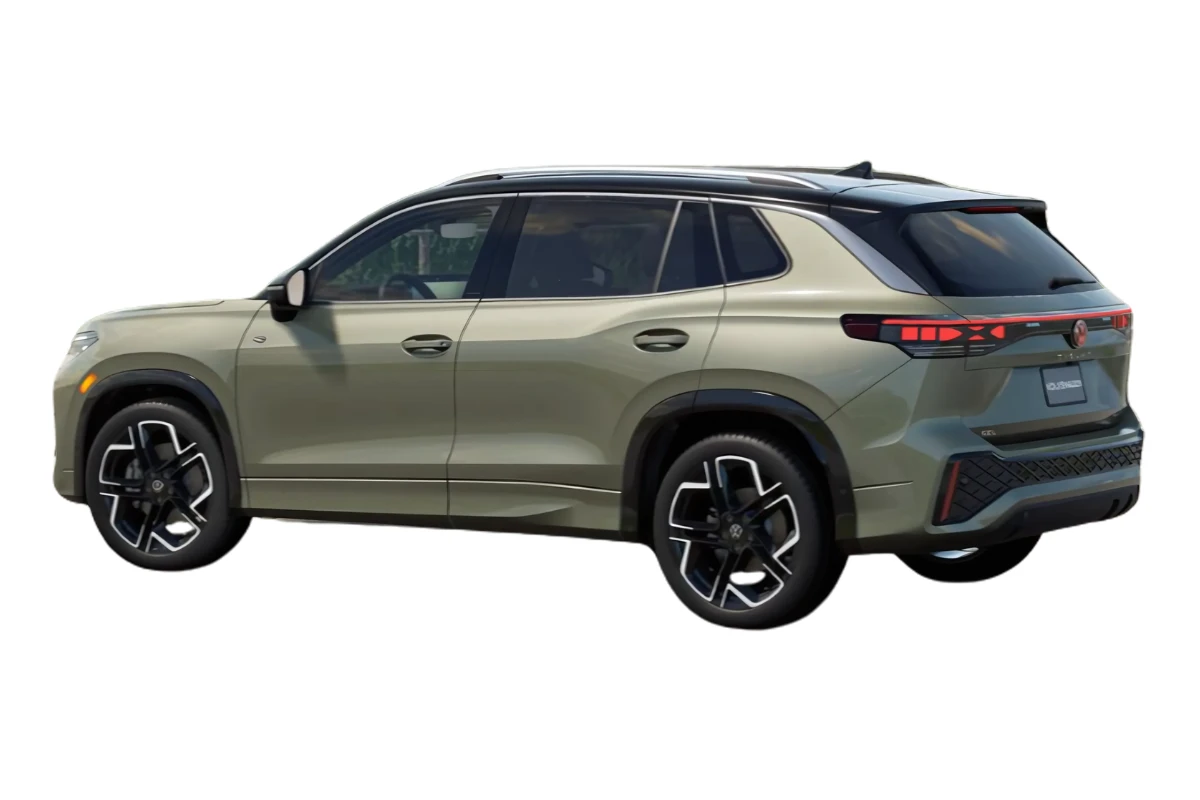
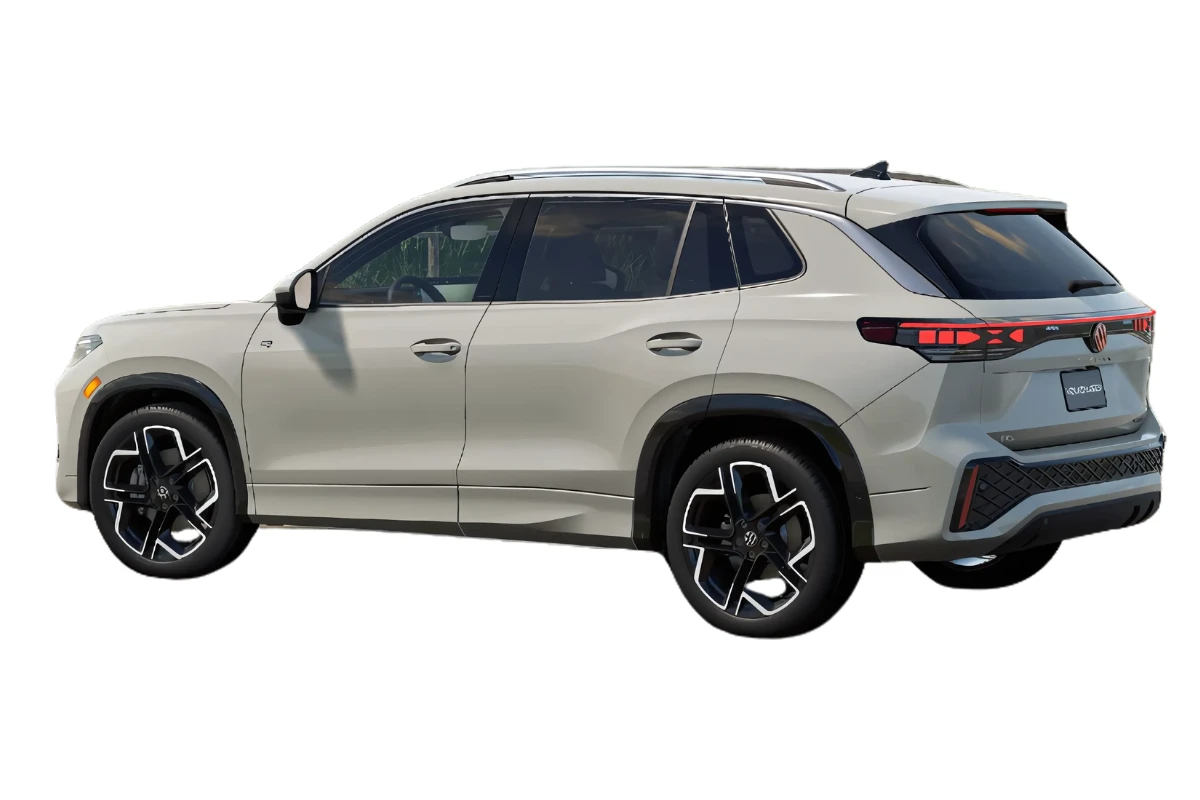
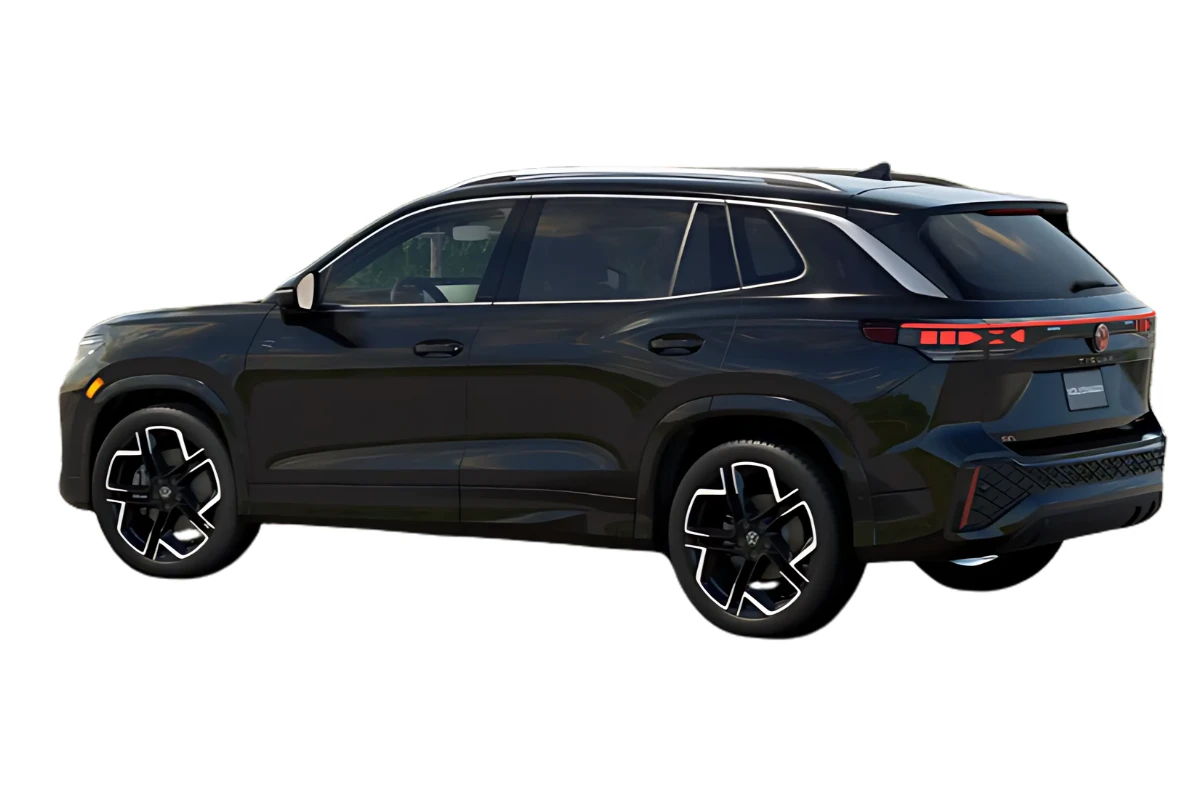
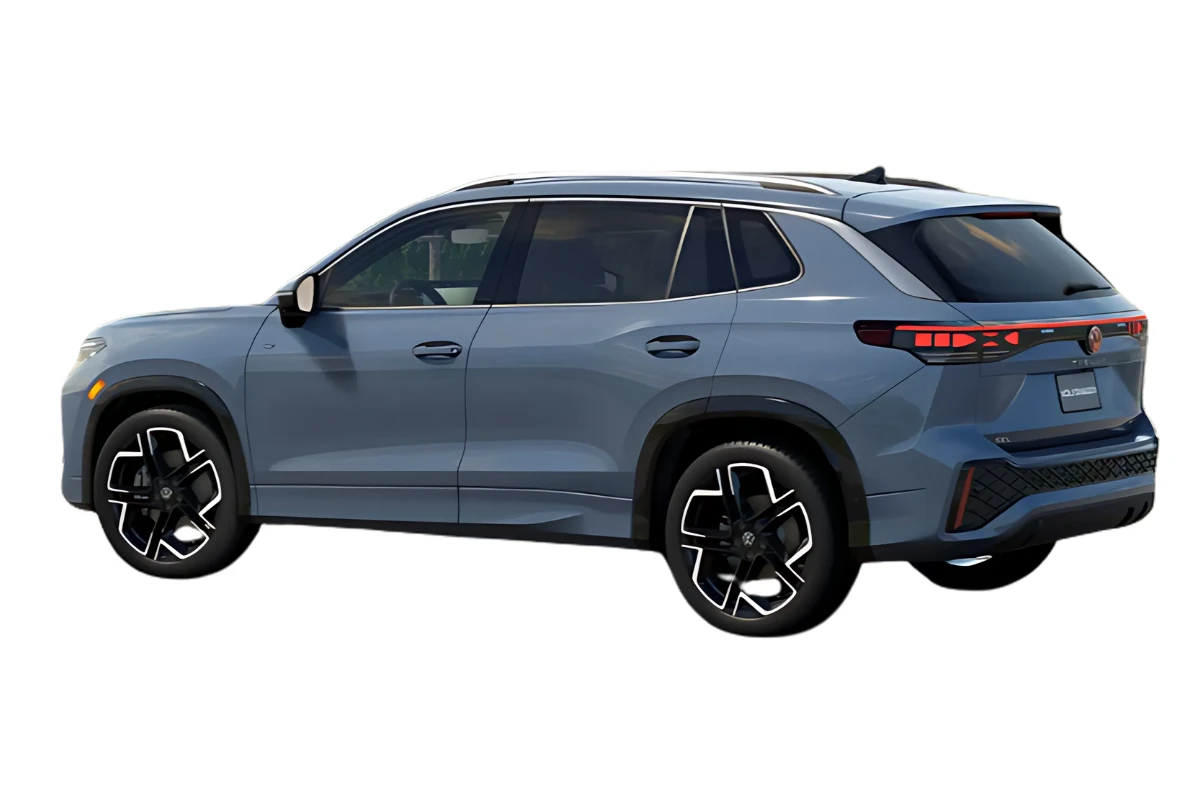
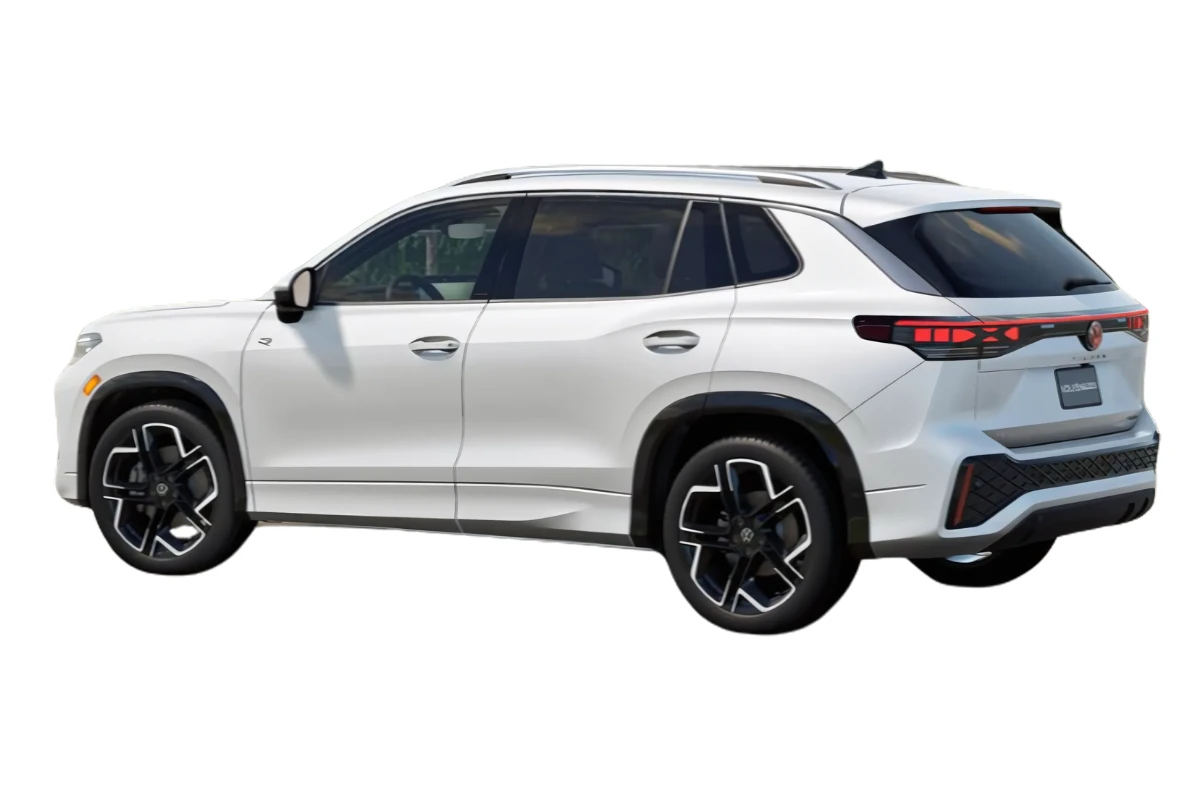
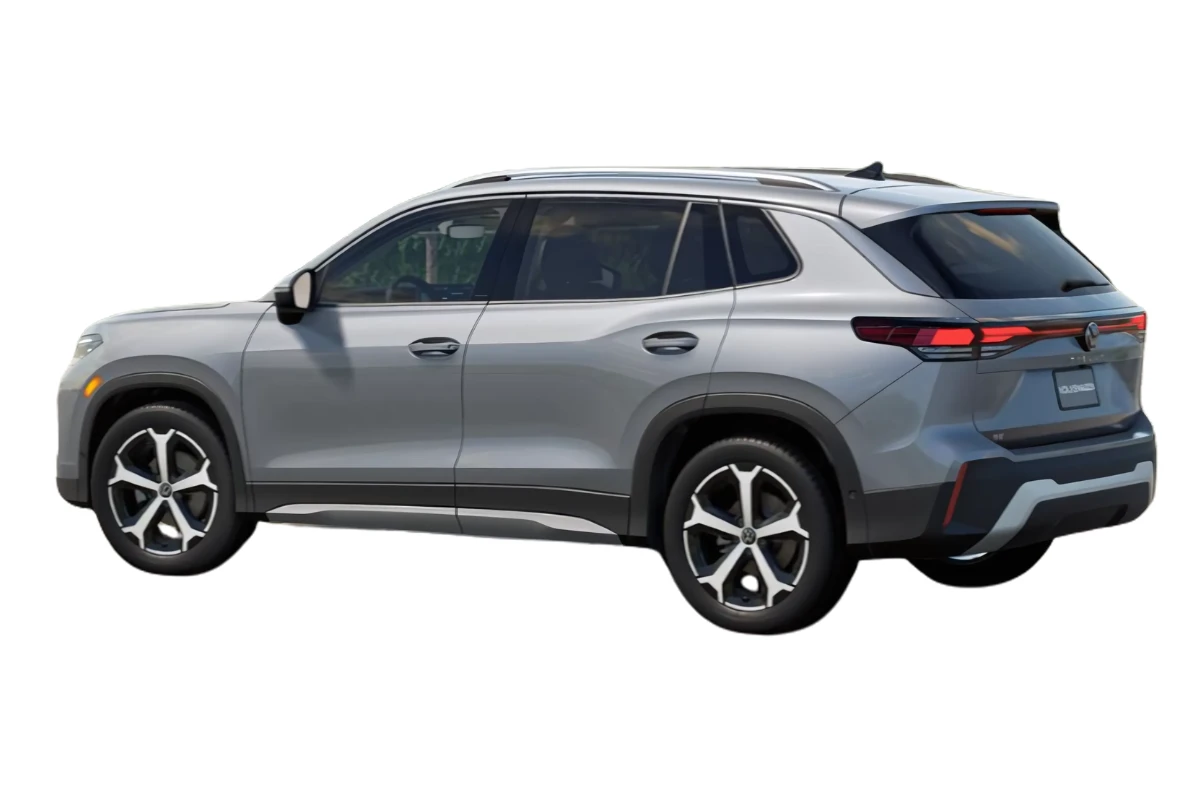
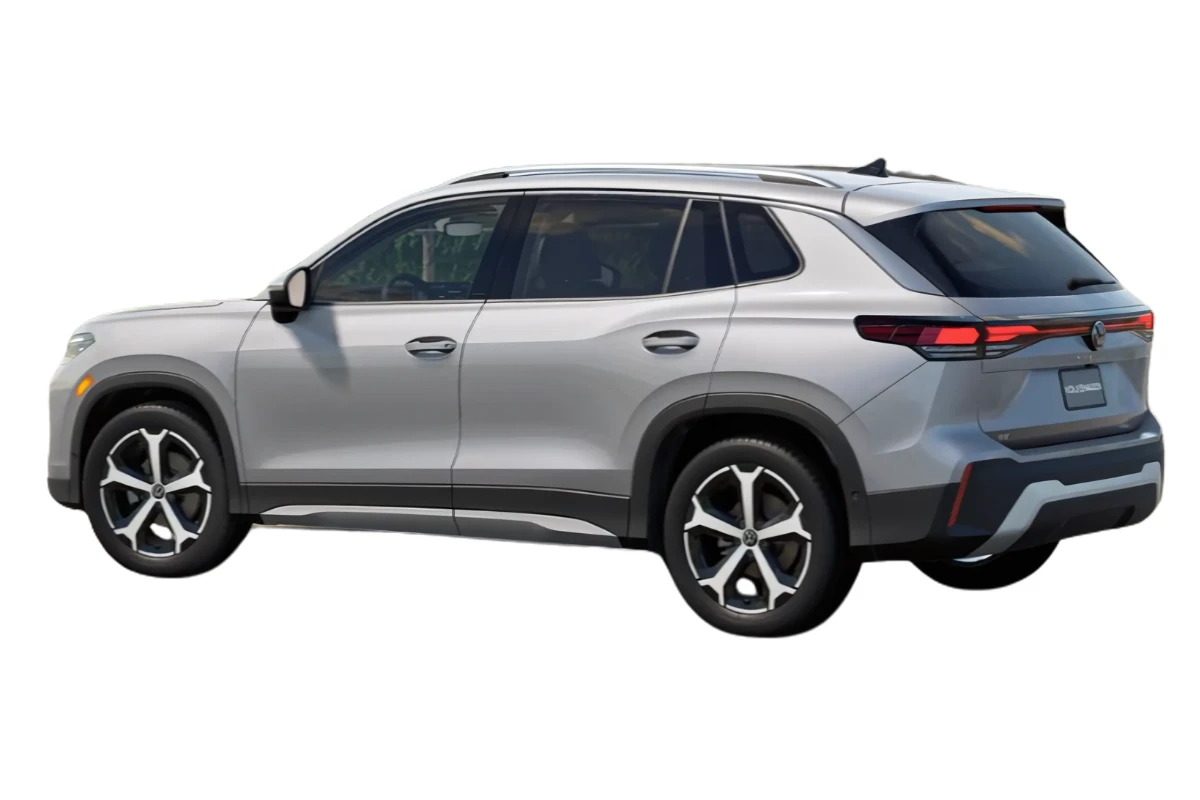
Exterior Dimensions
| Dimension | S FWD | S 4MOTION | SE FWD | SE 4MOTION | SE R-Line Black FWD | SE R-Line Black 4MOTION | SEL R-Line 4MOTION |
|---|---|---|---|---|---|---|---|
| Wheelbase | 109.9 in | 109.9 in | 109.9 in | 109.9 in | 109.9 in | 109.9 in | 109.9 in |
| Overall Length | 184.4 in | 184.4 in | 184.4 in | 184.4 in | 184.4 in | 184.4 in | 184.4 in |
| Overall Width (without mirrors) | 73.0 in | 73.0 in | 73.0 in | 73.0 in | 73.0 in | 73.0 in | 73.0 in |
| Overall Height | 66.4 in | 66.5 in | 66.4 in | 66.5 in | 66.4 in | 66.5 in | 66.5 in |
| Front Track Width | 62.2 in | 62.2 in | 62.2 in | 62.2 in | 62.2 in | 62.2 in | 62.2 in |
| Rear Track Width | 61.8 in | 61.8 in | 61.8 in | 61.8 in | 61.8 in | 61.8 in | 61.8 in |
| Ground Clearance | 7.0 in | 7.0 in | 7.0 in | 7.0 in | 7.0 in | 7.0 in | 7.0 in |
Interior Dimensions
| Dimension | S FWD | S 4MOTION | SE FWD | SE 4MOTION | SE R-Line Black FWD | SE R-Line Black 4MOTION | SEL R-Line 4MOTION |
|---|---|---|---|---|---|---|---|
| Passenger Capacity | 5 | 5 | 5 | 5 | 5 | 5 | 5 |
| Total Passenger Volume | 103.8 cu ft | 103.8 cu ft | 103.8 cu ft | 103.8 cu ft | 100.4 cu ft | 100.4 cu ft | 100.4 cu ft |
| Front Head Room | 39.5 in | 39.5 in | 39.5 in | 39.5 in | 38.2 in | 38.2 in | 38.2 in |
| Front Leg Room | 40.2 in | 40.2 in | 40.2 in | 40.2 in | 40.2 in | 40.2 in | 40.2 in |
| Front Shoulder Room | 57.0 in | 57.0 in | 57.0 in | 57.0 in | 57.0 in | 57.0 in | 57.0 in |
| Front Hip Room | 54.5 in | 54.5 in | 54.5 in | 54.5 in | 54.5 in | 54.5 in | 54.5 in |
| Second Row Head Room | 39.7 in | 39.7 in | 39.7 in | 39.7 in | 38.4 in | 38.4 in | 38.4 in |
| Second Row Leg Room | 40.2 in | 40.2 in | 40.2 in | 40.2 in | 40.2 in | 40.2 in | 40.2 in |
| Second Row Shoulder Room | 55.7 in | 55.7 in | 55.7 in | 55.7 in | 55.7 in | 55.7 in | 55.7 in |
| Second Row Hip Room | 53.3 in | 53.3 in | 53.3 in | 53.3 in | 53.3 in | 53.3 in | 53.3 in |
Cargo Dimensions
| Dimension | S FWD | S 4MOTION | SE FWD | SE 4MOTION | SE R-Line Black FWD | SE R-Line Black 4MOTION | SEL R-Line 4MOTION |
|---|---|---|---|---|---|---|---|
| Cargo Space Behind Second Row | 26.5 cu ft | 26.5 cu ft | 26.5 cu ft | 26.5 cu ft | 26.5 cu ft | 26.5 cu ft | 26.5 cu ft |
| Cargo Space Behind First Row | 58.9 cu ft | 58.9 cu ft | 58.9 cu ft | 58.9 cu ft | 58.9 cu ft | 58.9 cu ft | 58.9 cu ft |
Weight & Capacity
| Dimension | S FWD | S 4MOTION | SE FWD | SE 4MOTION | SE R-Line Black FWD | SE R-Line Black 4MOTION | SEL R-Line 4MOTION |
|---|---|---|---|---|---|---|---|
| Base Curb Weight | 3,563 lbs | 3,801 lbs | 3,607 lbs | 3,801 lbs | 3,607 lbs | 3,801 lbs | 3,801 lbs |
| Fuel Tank Capacity | 15.6 gal | 15.6 gal | 15.6 gal | 15.6 gal | 15.6 gal | 15.6 gal | 15.6 gal |
Wheels & Tires
| Dimension | S FWD | S 4MOTION | SE FWD | SE 4MOTION | SE R-Line Black FWD | SE R-Line Black 4MOTION | SEL R-Line 4MOTION |
|---|---|---|---|---|---|---|---|
| Front Wheel Size | 17 x 7 in | 17 x 7 in | 19 x 8.5 in | 19 x 8.5 in | 20 x 8.5 in | 20 x 8.5 in | 20 x 8.5 in |
| Rear Wheel Size | 17 x 7 in | 17 x 7 in | 19 x 8.5 in | 19 x 8.5 in | 20 x 8.5 in | 20 x 8.5 in | 20 x 8.5 in |
| Front Tire Size | P215/65HR17 | P215/65HR17 | P235/50HR19 | P235/50HR19 | P255/40HR20 | P255/40HR20 | P255/40HR20 |
| Rear Tire Size | P215/65HR17 | P215/65HR17 | P235/50HR19 | P235/50HR19 | P255/40HR20 | P255/40HR20 | P255/40HR20 |
| Spare Tire | Compact Steel | Compact Steel | Compact Steel | Compact Steel | Compact Steel | Compact Steel | Compact Steel |
Turning & Maneuverability
| Dimension | S FWD | S 4MOTION | SE FWD | SE 4MOTION | SE R-Line Black FWD | SE R-Line Black 4MOTION | SEL R-Line 4MOTION |
|---|---|---|---|---|---|---|---|
| Turning Diameter (curb to curb) | 38.1 ft | 38.1 ft | 38.1 ft | 38.1 ft | 38.1 ft | 38.1 ft | 38.1 ft |
2025 Volkswagen Tiguan Overview:
The 2025 Volkswagen Tiguan is really stepping up the game for the German carmaker’s compact SUV lineup. It’s now in its third generation, and guess what? It’s officially become Volkswagen’s best-selling model around the globe. After spending a good chunk of time testing various trims in all sorts of driving situations, we’re pretty confident that Volkswagen has tackled a lot of the issues that came up with the last generation. They’ve really pushed the Tiguan into a more premium space.
Now, this new Tiguan is built on Volkswagen’s latest MQB Evo platform, which it shares with the Golf GTI and other high-end VW models. This gives it a touch of sophistication that the last version was missing. Interestingly, it’s 1.7 inches shorter than the previous model but also half an inch wider. This change really helps with the overall look and aerodynamics, cutting down on drag by 15%. Plus, it’s lost nearly 200 pounds, which totally changes how it drives.
In a market where compact SUVs are super popular, dominated by the Toyota RAV4 (selling over 400,000 units annually) and Honda CR-V, the Tiguan faces an uphill battle with its 95,000 annual sales. But here’s the thing: this new generation is setting itself up as the premium choice. It’s loaded with features you’d usually find in luxury cars, but at a much more wallet-friendly price. While competitors like the RAV4 and CR-V stick to reliability and fuel efficiency, the Tiguan leans into refinement, tech, and a fun driving experience.
Starting at $30,920 for the base S trim, it’s competitively priced against mainstream rivals. But the real value shines in the higher trims. You can get cool perks like massaging seats, top-notch audio systems, and advanced lighting—stuff that would cost a pretty penny from luxury brands. Even the top SEL R-Line at $41,180 is a steal compared to similarly equipped rivals, making it a solid pick for folks wanting premium features without breaking the bank.
Volkswagen seems to be aiming to market the Tiguan as a “budget Audi,” and honestly, after all the testing, it looks like they’ve hit the mark. The quality inside, the smooth ride, and the overall features feel much more upscale than what you’d expect from a regular compact SUV. And here’s a little teaser: there’s a 268-horsepower turbo variant on the way for 2026, which is basically going to give you Audi Q5 performance at Tiguan prices.
Oh, and they’ve also ditched the seldom-used third row (only 10% of buyers went for it), allowing them to really focus on maximizing space for five passengers. This also improves the structural integrity and trims down the weight. Interestingly, the second-row space has actually grown by 1.5 inches, even with the shorter length—pretty smart thinking, right? It shows they’re all about making the most of the space rather than just checking off marketing boxes.
Engine Options and Performance Specs:
At the core of the 2025 Tiguan lineup is Volkswagen’s updated 2.0-liter turbocharged four-cylinder engine, known as the “Evo 5” generation. This engine cranks out 201 horsepower, which is a solid bump — about 17 more than the last version. What about the torque output? It varies a bit. The front-wheel-drive models kick out 206 lb-ft, while the all-wheel-drive ones offer a beefier 221 lb-ft. So, you get that extra oomph needed to handle the 4Motion system quite well.
Now, our testing showed that this engine upgrade isn’t just about cranking up the power. It’s got a redesigned variable geometry turbocharger, better charge cooling, revamped injection systems, and camshaft profiles that are all optimized. What does this mean for you? Better throttle response, especially compared to the rather sluggish previous model. Sure, there’s still a bit of turbo lag when you first take off, but once the turbo kicks in, the power delivery feels smooth and strong all the way through the rev range.
About the eight-speed automatic transmission — it’s a perfect match for the turbo engine. The shifts are smooth, and it knows when to switch gears, whether you’re zipping around or just cruising. Unlike a lot of competitors that use continuously variable transmissions (CVTs), the Tiguan’s traditional automatic gives you that nice, satisfying shift feel that driving fans really appreciate. On the highway, it keeps the engine running in that sweet spot, making passing feel effortless.
When we tested the performance, we were pleasantly surprised, especially given the high-altitude challenges in Montana, where we did our evaluations. At around 5,000 feet up, the all-wheel-drive version managed to hit 0-60 mph in about 8.2 to 8.7 seconds. We think that at sea level, it could really shine, probably getting down to the low-to-mid 7-second range — which is pretty competitive. Plus, the front-wheel-drive models should be even quicker since they’re about 200 pounds lighter.
Here’s something really exciting for those who crave performance: Volkswagen is rolling out a 268-horsepower turbo variant for the 2026 model year. This engine, which it shares with the Audi Q5, is set to turn the Tiguan into a seriously quick SUV, capable of 0-60 times around 6.5 seconds. Initially, it’ll be available only on the top trim, but there’s buzz that it might trickle down to other versions. Imagine a “GTI version” of the Tiguan — that could really catch the eye of enthusiasts looking for space and fun at the same time.
On the fuel economy front, it’s a decent trade-off for the added performance. The EPA ratings are 24 mpg combined for the all-wheel-drive models (22 city/29 highway) and 26 mpg combined for the front-wheel-drive variants (23 city/30 highway). Sure, these numbers aren’t quite up to par with hybrids that can hit 38-40 mpg, but they do show a 1-2 mpg bump over the previous generation. Volkswagen is working on hybrid options, though it’s still a bit unclear when they’ll be available.
In terms of real-world fuel consumption, our tests lined up pretty well with the EPA estimates. The all-wheel-drive model averaged around 25 mpg in mixed driving, which is good. On the highway, if you keep it steady, you’re looking at around 29-30 mpg. But if you get a little spirited in the mountains, that drops to about 22 mpg. The 15.6-gallon fuel tank gives you a solid 400-mile range on regular gas, making it a pretty practical choice for those longer trips.
Closer Look at the 2025 Volkswagen Tiguan Brakes:
The 2025 Tiguan’s braking system has really stepped up its game compared to the previous version. You’ve got these beefy 13.4-inch front rotors and 11.8-inch rear discs. That’s a solid upgrade in thermal capacity and fade resistance. When we put it to the test, the brake pedal response was consistently smooth and linear. Honestly, it gives you that extra boost of confidence, whether you’re making a quick emergency stop or just cruising around town.
The brake-by-wire system works like a charm alongside the regenerative braking elements. Just a heads up, though: the Tiguan doesn’t have any hybrid support. Instead, it focuses on making those brake pads last longer and keeping the pedal feel consistent, no matter the driving conditions. The electronic parking brake is nice and smooth, coming with an automatic brake hold feature that’s a lifesaver in stop-and-go traffic or when you’re starting on a hill.
When we hit the mountains, the brakes really impressed us. They held up beautifully against fade, even with all those steep climbs and frequent braking. And during some wet conditions, we got to see how well the anti-lock braking system performed. It was spot on—smooth and controlled, and you could still steer effectively even in emergency situations. Oh, and the brake assist kicks in when it senses you’re braking hard, which might just shorten your stopping distance when you need it most.
The feel of the brake pedal strikes that perfect chord—firm yet progressive. You have precise control, whether you’re easing to a stop or hitting the brakes hard. The initial bite is really natural and predictable, which is a relief because some modern systems can feel a bit too grabby and artificial. From our road testing, it looks like the brakes don’t need much of a break-in period, and they perform consistently across different temps and conditions.
Looking ahead, the new 268-horsepower turbo variant is set to get some upgraded braking components to manage that added power. Volkswagen hasn’t spilled the beans on the specifics yet, but we’re expecting larger rotors and maybe some performance-oriented brake pads to match that extra oomph.
Here’s a nice touch: hill descent control is standard on the all-wheel-drive models. This feature automatically applies the brakes when you’re going down steep hills, so you don’t have to worry about speeding out of control. It’s especially handy when you’re off-roading or dealing with slippery surfaces where grip is everything. The system works smoothly, too—none of that jarring, jerky braking you might find in some competitors’ models.
Steering and Suspension:
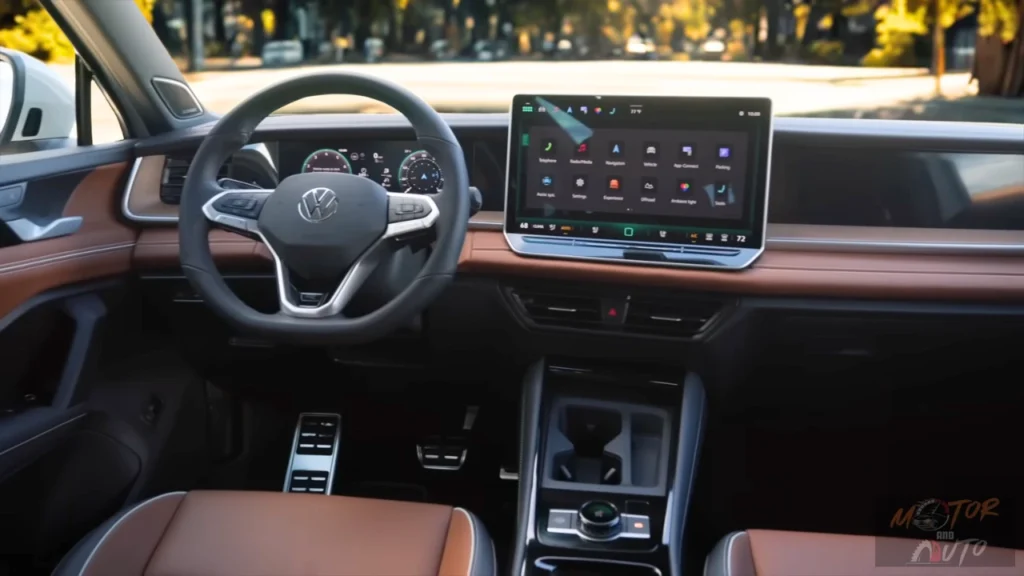
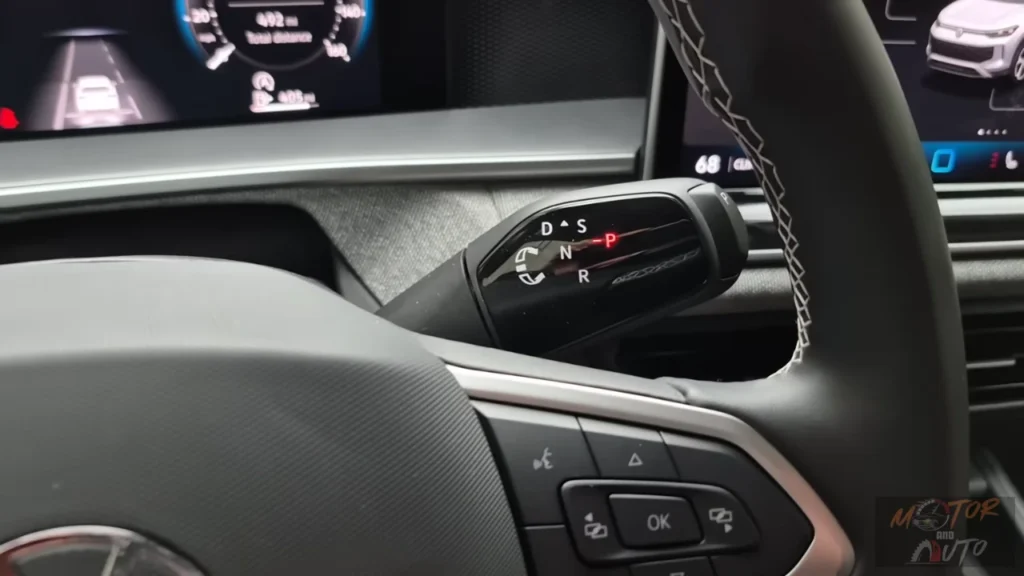
You know, one of the standout features of the new Tiguan has to be its steering system. They really took a step up from the previous model, which felt a bit vague and disconnected. Now, it’s all about a more engaging and precise feel. With the electric power-assisted rack-and-pinion setup, you get that variable assistance—like, it lightens up when you’re parking, but gives you solid feedback when you’re out on the highway or taking those tight corners. Sure, it might not quite match the communicative finesse of a BMW or even the sporty vibe of Volkswagen’s GTI, but trust me, it’s a huge leap forward from what came before.
Then there are the R-Line variants. They’ve got this cool progressive steering tech that adjusts the steering ratio based on how fast you’re going and how much you’re turning the wheel. It makes parking feel a lot easier and gives you quicker responses when you’re really getting into it. In our tests, the steering weight felt pretty spot-on for the vehicle’s character. That said, some folks might still think it’s a tad light compared to European rivals like the BMW X3 or Audi Q3.
Moving on to the suspension—wow, talk about a balance! It manages to juggle ride comfort and handling capability really well. They use a strut front setup paired with a sophisticated multi-link rear arrangement. If you go for the higher trims, you also get adaptive damping tech that adjusts on the fly, depending on your driving conditions and the mode you’ve chosen. Even in Comfort mode, the suspension keeps things under control while soaking up most of those pesky road imperfections like a champ.
The MQB Evo platform really shines here too. Its inherent rigidity helps the engineers tune for comfort without losing that solid structural integrity. So, you end up with a planted, confident feel when cornering—something that’s pretty rare in the compact SUV world. The suspension does a great job of controlling body roll, keeping those tires glued to the road, which is a win for both safety and driving enjoyment.
Now, when we took it out on some mountain roads, it really held its own over rough terrain. The suspension stayed composed over bumpy pavement and quick direction changes. But, a little heads up—the 20-inch wheels on the higher trims might make it feel a bit harsher compared to the smaller options. If ride comfort is your thing, you might want to think about going for those 19-inch wheels—they do a better job of absorbing impacts while still handling pretty well.
Oh, and let’s not forget about the all-wheel-drive system. The way it integrates with the suspension tuning is impressive. The 4Motion system distributes torque so smoothly with the chassis dynamics, giving you neutral handling without that annoying understeer you often find in front-wheel-drive-based all-wheel-drive setups. The end result? It feels balanced and predictable, whether you’re cruising on wet mountain roads or hitting the dry highway.
About ground clearance—it’s 7 inches across the board, which is just enough for light off-road fun while still keeping stability on the road. The suspension travel is sufficient for typical SUV tasks without going overboard, which can mess with handling on paved surfaces. This whole tuning approach really fits the Tiguan’s role as a premium family hauler, rather than a hardcore off-roader.
Tires and Traction:
Starting with the base S trim, you get 17-inch wheels paired with 215/65R17 all-season tires. This setup really nails it when it comes to ride comfort and fuel efficiency while still offering decent performance for everyday driving. It’s a smart pick for anyone trying to stick to a budget.
Now, if you move up to the SE and SE R-Line Black trims, you’ll find 19-inch wheels with 235/50R19 tires. This combo hits that sweet spot—good looks, a smooth ride, and better handling. Honestly, our tests show that it gives you a noticeable boost in cornering ability compared to the base model, without the rough ride that comes with the biggest wheel option.
At the top of the line, the SEL R-Line sports bold 20-inch wheels with 255/40R20 tires. They look impressive and enhance handling performance. But here’s the trade-off: the ride can get a bit bumpier since more road imperfections can be felt inside. Still, if you’re all about performance, this is the way to go since it offers fantastic grip for cornering and braking.
When it comes to tire quality, there’s a clear difference. The higher trims get premium all-season tires that last longer and grip better. The 20-inch setup, for instance, uses high-performance tires that handle dry and wet conditions like champs. Just a heads up, they do tend to make a bit more noise on the road compared to the smaller ones. We found that all tire options performed really well in wet conditions, giving solid braking and cornering even on slippery mountain roads.
About the spare tire situation: It’s pretty handy across all models—there’s a compact temporary spare tucked away beneath the cargo floor. Not exactly ideal for long trips, but it’s great for emergencies and keeps the cargo space nice and roomy. These days, finding a spare tire in this segment is getting less common, so it’s a nice perk that sets the Tiguan apart from competitors that stick to tire repair kits.
Towing capacity varies, too, depending on whether you go for all-wheel drive or front-wheel drive. The all-wheel-drive models can handle up to 1,800 pounds, while the front-wheel-drive ones are rated for 1,500 pounds. That’s a solid 300-pound increase over the previous generation, making the Tiguan better equipped for towing small trailers, boats, or other recreational gear. Plus, the improved cooling systems and transmission programming ensure everything runs smoothly when you’re towing.
Lastly, tire pressure monitoring is standard on all trims. This system gives you individual readings for each wheel instead of just a general low-pressure alert. It’s super helpful for keeping your fuel economy and tire life in check, though it can be a bit touchy with temperature changes as the seasons shift. You’ll see the info right on the infotainment display, which makes it easy to keep an eye on things when you need to.
Inside the Volkswagen Tiguan:
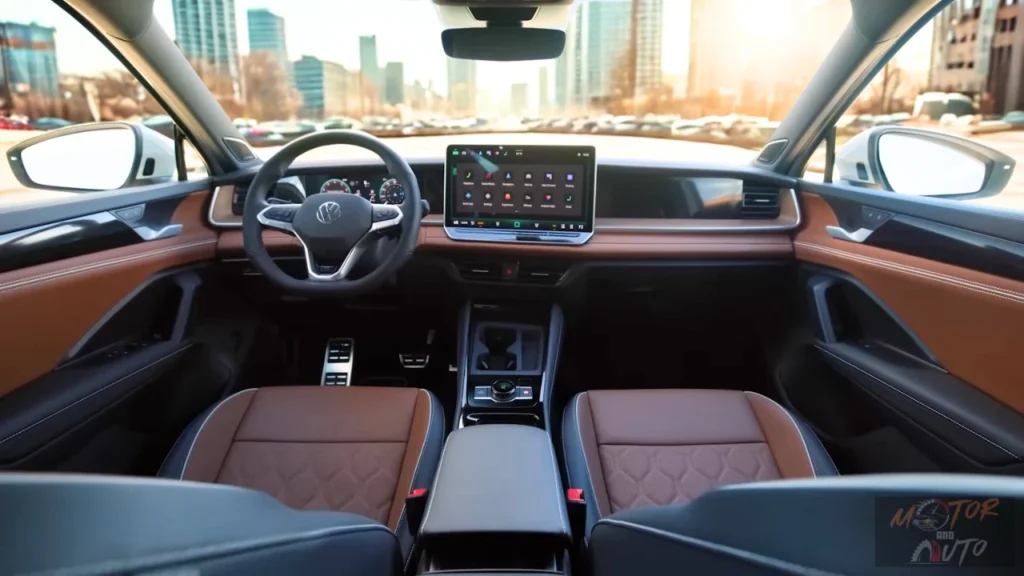
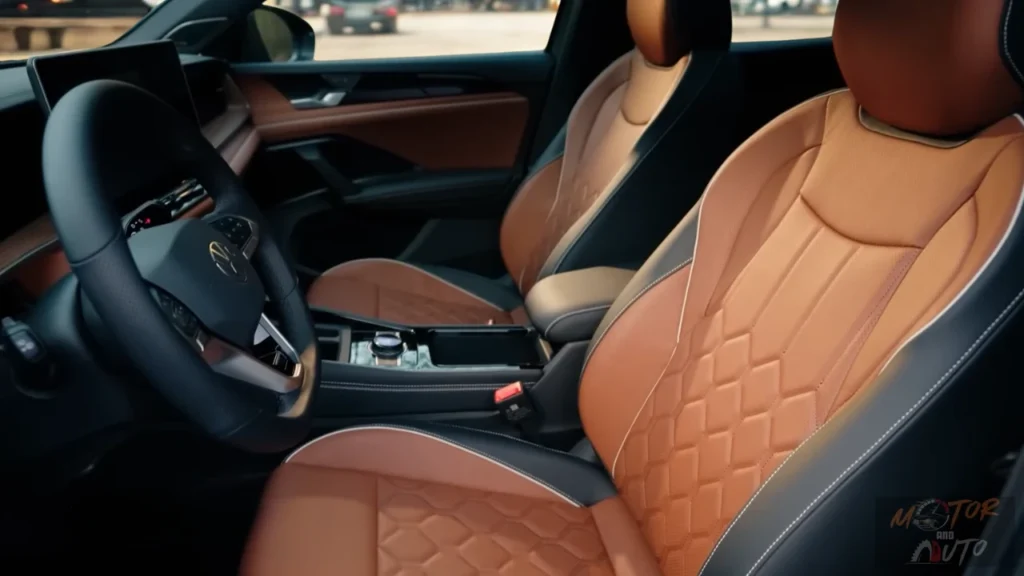
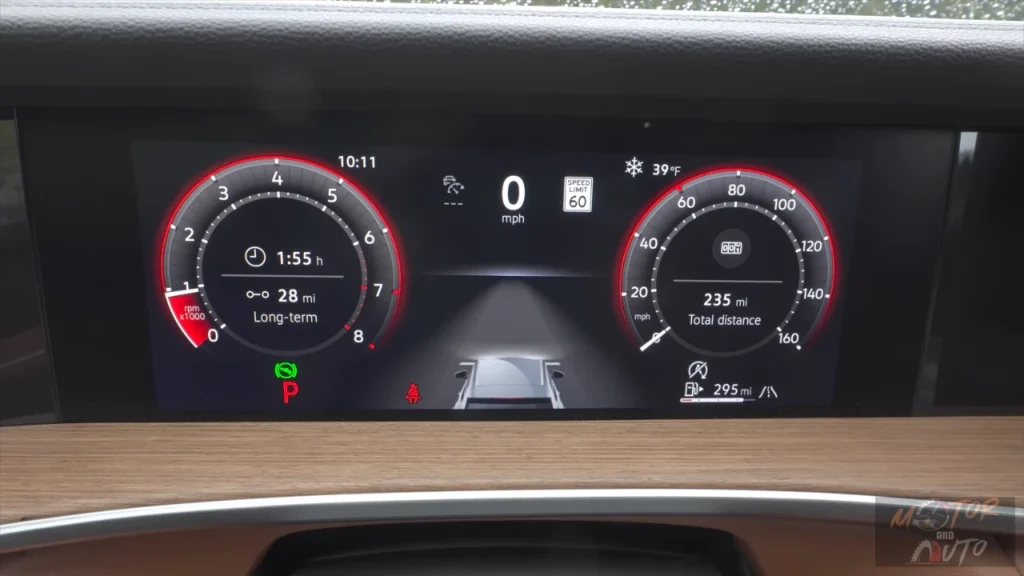
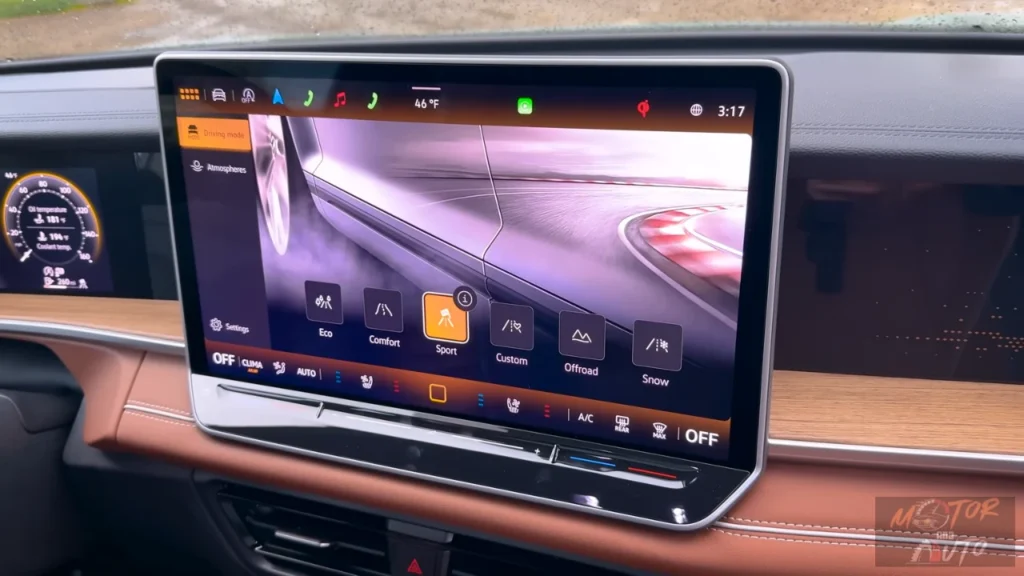
The interior of the 2025 Tiguan is a huge step up from the previous models. Honestly, Volkswagen really put a lot into making the cabin feel almost luxurious, with high-quality materials and smart design touches everywhere you look. It’s such a big change that newcomers often think they’re stepping into a much pricier car, which really shows how successful Volkswagen has been in positioning this model as more premium.
At the heart of it all is a floating infotainment screen, and depending on the trim level, it varies in size. The base and mid-level versions come with a 12.9-inch display, while the top-of-the-line SEL R-Line boasts a massive 15-inch screen that really grabs your attention. Both screens are bright and responsive, and they come with user-friendly menus that are a big improvement over what we’ve seen in past Volkswagen systems. That larger screen definitely adds a modern feel, though, we can see how it might feel a bit too much in the snug cabin space.
When it comes to materials, Volkswagen is clearly aiming for that premium vibe. You’ll find soft-touch surfaces throughout, which makes a big difference. On the higher trims, they’ve even used real wood trim—specifically American walnut—that feels solid and genuine, not like the cheap plastic you’d expect in this price range. That wood runs the full width of the dashboard, giving it a nice, cohesive look that could rival some luxury brands.
Now, seat designs take a turn depending on which trim you choose. The base models start off with durable cloth, but if you go for the SEL R-Line, you’ll be sitting on luxurious leather. Those leather seats are not just any leather either; they come with unique quilted patterns and contrasting piping that look way more upscale than you’d expect for the price. You can tell Volkswagen’s really paid attention to the details, especially in the stitching and leather quality—these materials feel like they’re from the higher-end suppliers.
The color options are pretty classy too. There’s this striking brown and black combo that’s especially nice in person. The contrast piping and stitching add a little flair without going overboard. Even the leatherette options don’t skimp on quality—they have a realistic texture and softness that should hold up nicely over time.
Ambient lighting is another highlight. Base models have 10 color choices, but if you opt for the top trim, that jumps to 30 different colors. And it’s not just about adding a bit of glow; they’ve integrated the lighting into trim pieces and door panels, creating a really chic nighttime vibe. You can even customize the lighting through the “atmosphere” settings, which also adjust audio settings to match your mood or whatever vibe you’re going for while driving.
What about the storage space? Yeah, they’ve nailed that too, with classic German attention to detail. The center console offers 7.6 liters of storage, complete with removable dividers and several USB-C ports for charging. The door pockets are just the right size, lined with carpet to keep your stuff from rattling around while you drive. The glove box is roomy and opens smoothly, though it could use some felt lining like you might find in more expensive rivals.
Overall, the design flows with horizontal lines and clean surfaces that give off a sense of spaciousness, even though the Tiguan is on the smaller side. They’ve kept the button count low for a neat, modern look, but we guess that does mean you’ll have to use the touchscreen for climate controls instead of just reaching for a physical button. It’s a trade-off, but one that seems to fit the overall minimalist aesthetic they were going for.
Exterior Design Impressions:
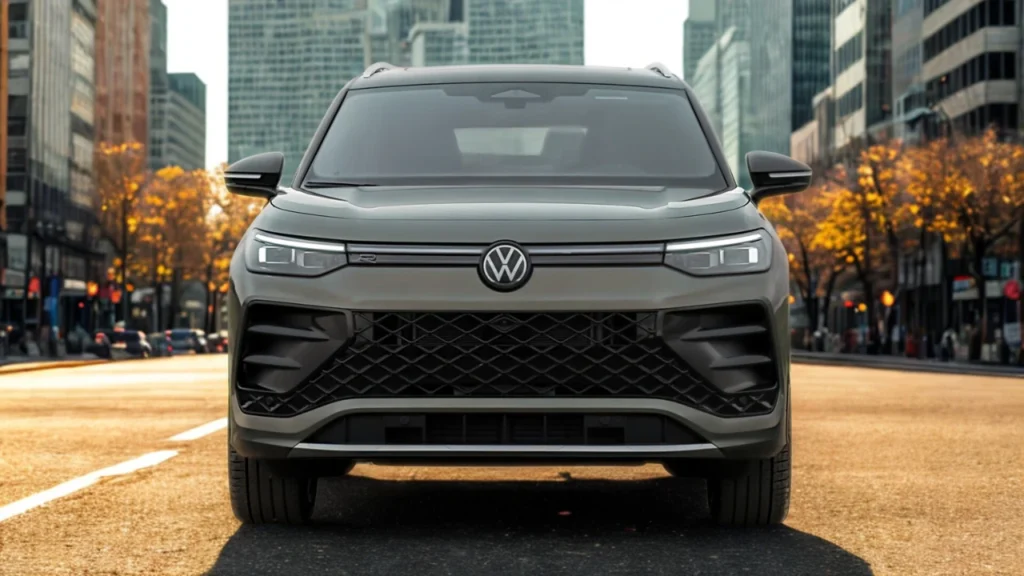
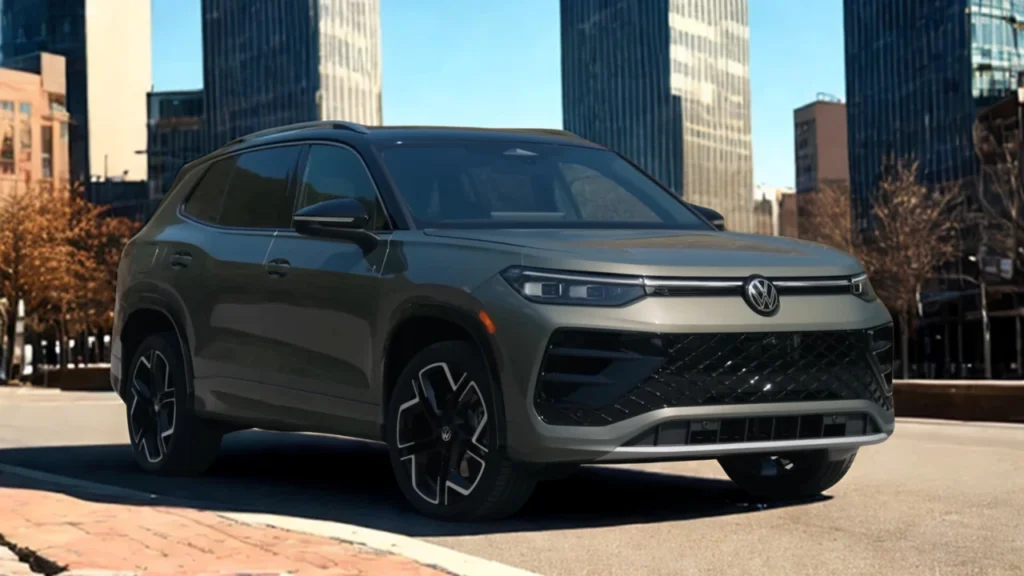
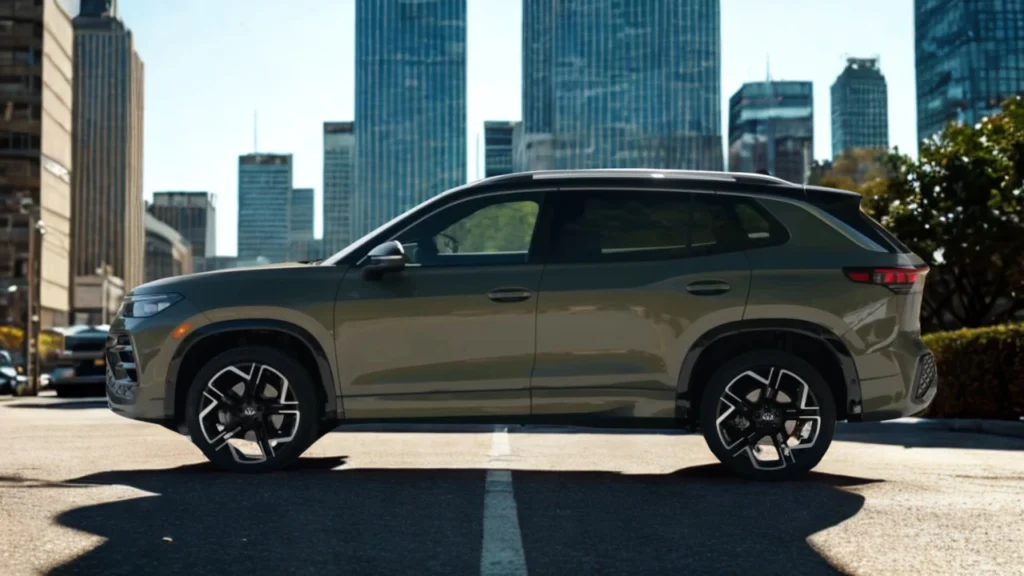
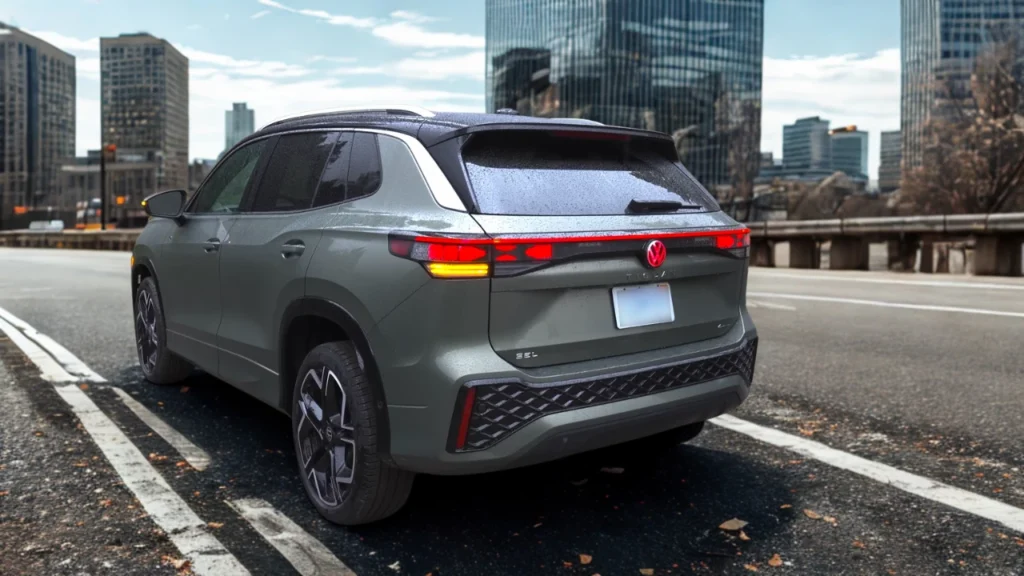
The 2025 Tiguan’s new look — it’s a big change from the more traditional styles we’ve seen in past models. This time around, it embraces a bold and sophisticated design that’s totally in line with Volkswagen’s fresh aesthetic. You can notice the transformation right away, no matter which angle you’re looking from. The new model feels more premium and purposeful, all while keeping those practical dimensions that SUV buyers really care about.
About the front — it definitely makes a strong first impression. That huge black grille grabs attention and gives the Tiguan a commanding presence on the road. Some might find it a bit much, but hey, it actually serves a purpose! It helps with airflow and houses the radar systems for those advanced driver assistance features. Plus, depending on the trim, the grille design varies — the R-Line models have this cool crosshatch look that really highlights their sporty vibe, while the more understated trims go for a subtler mesh.
Now, when it comes to lighting, this design really shines—literally! Full LED headlights come standard on all trims, which is pretty impressive. The top-of-the-line SEL R-Line boasts adaptive LED headlights with matrix functionality. They can dim specific sections of the beam to avoid blinding drivers coming the other way, all while keeping everything else lit up. And let’s not forget the cool welcome and goodbye animations—definitely a nice touch that you’d usually expect from luxury cars.
That LED light bar stretching across the front not only makes the Tiguan look wider but also has that illuminated Volkswagen logo on the higher trims. It’s especially eye-catching at night when everything lights up, making it unmistakably a Volkswagen. And the way the turn signals are integrated into that light bar just adds to the whole visual drama without losing clarity.
Moving to the side, the Tiguan’s proportions get a nice boost from its new dimensions. It’s a bit shorter and has a slightly lower roofline, giving it a sportier stance compared to the older, boxier models. The windows sport subtle chrome accents on most trims, but the R-Line models go for a more aggressive blacked-out look. Roof rails are standard, which is handy for carrying stuff, so it’s not just about looks — it’s practical too.
Now, let’s chat about the wheels. There’s quite a range here! You start off with sleek 17-inch alloys on the base models, and if you go higher, you can get up to 20-inch wheels on the top trim. Those big wheels definitely make a statement and fill out the wheel wells nicely. Just a heads up, though — while they look great, they might impact ride comfort a bit, as we’ll see later.
At the back, the Tiguan keeps up the LED lighting theme with full-width tail lights that really stand out at night. The illuminated logo adds that premium feel, and the lower fascia is sleek, steering clear of those fake exhaust outlets that so many cars have these days. Instead, the real exhaust pipes are cleverly tucked away beneath the bumper for a cleaner look that should hold up well over time.
As for colors, there are some fresh options aimed at highlighting the Tiguan’s upscale nature. One standout is the Avocado Green metallic—it photographs beautifully and really pops in a sea of silver and white SUVs. Higher trims also offer optional two-tone roof treatments, which add a bit of visual interest without feeling gimmicky, giving you that upscale vibe without going overboard.
Comfort and Convenience Features
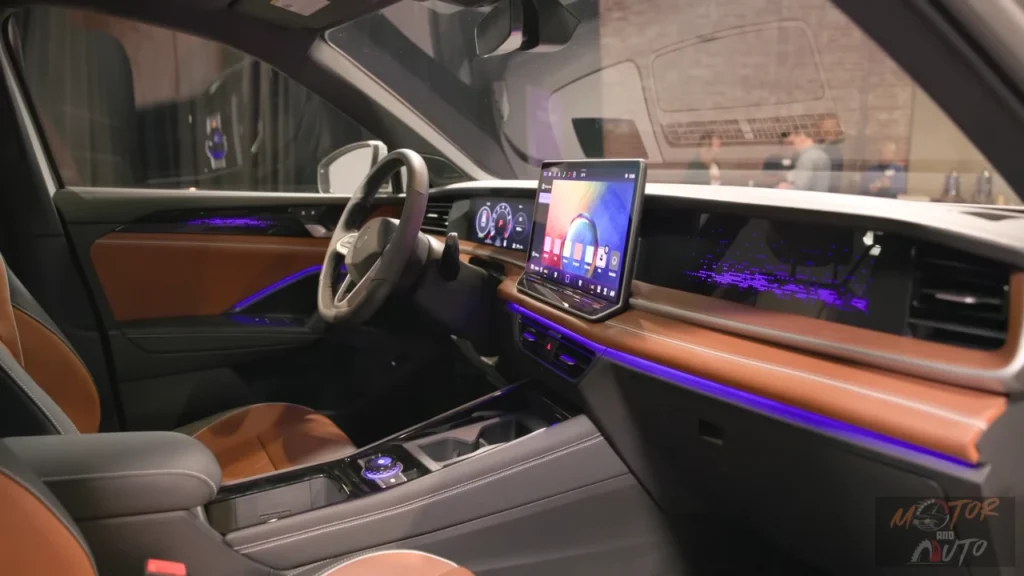
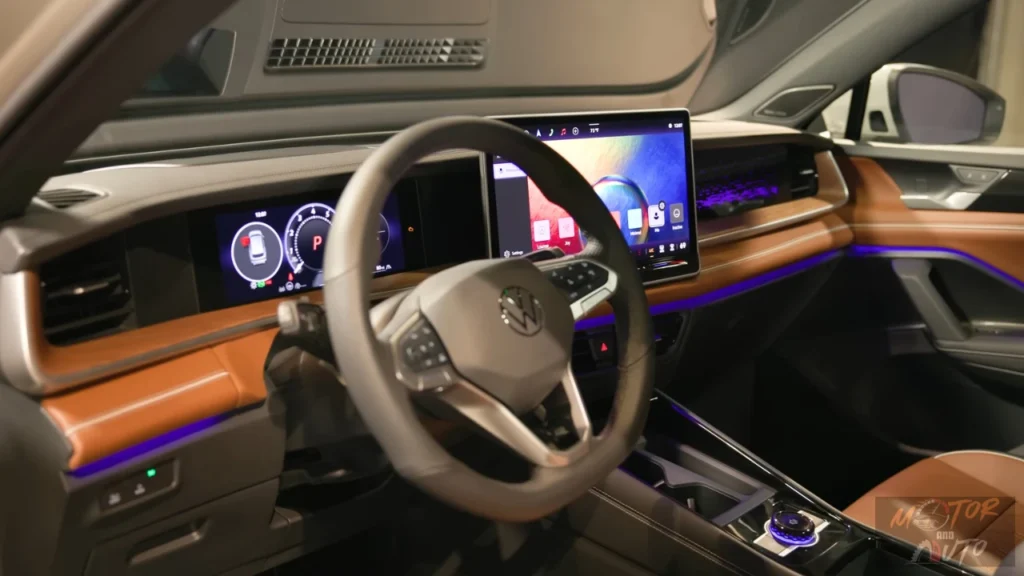
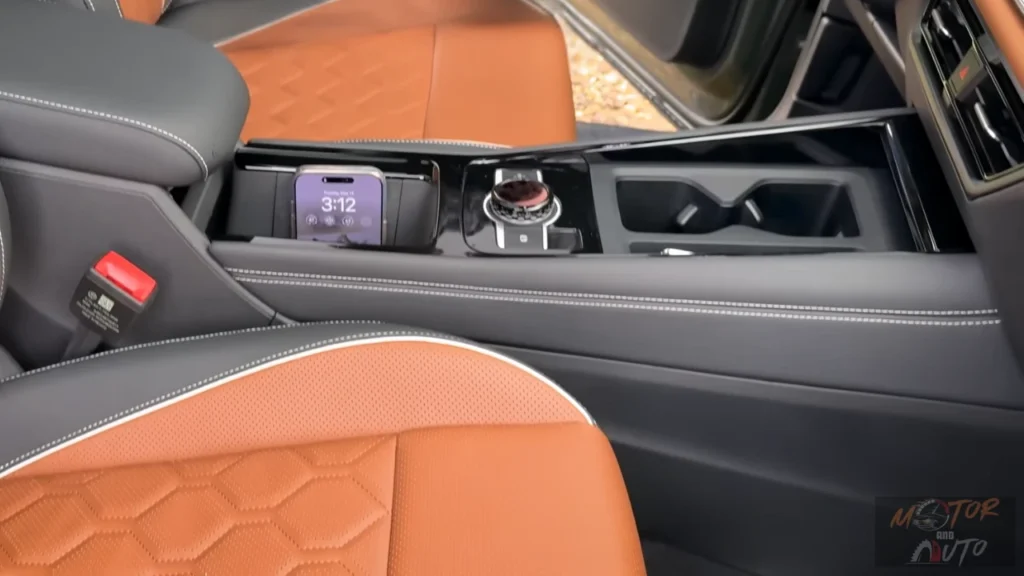
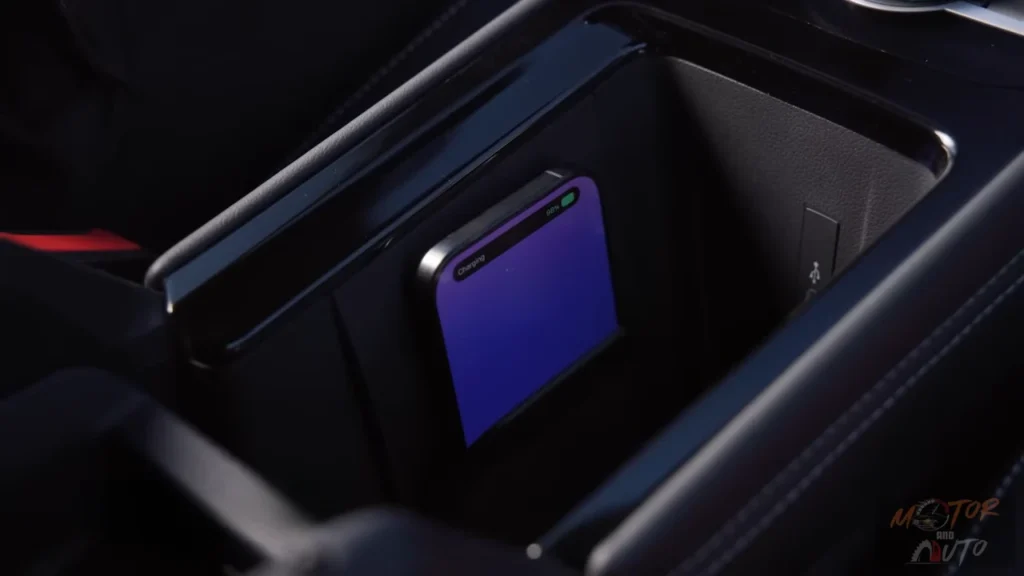
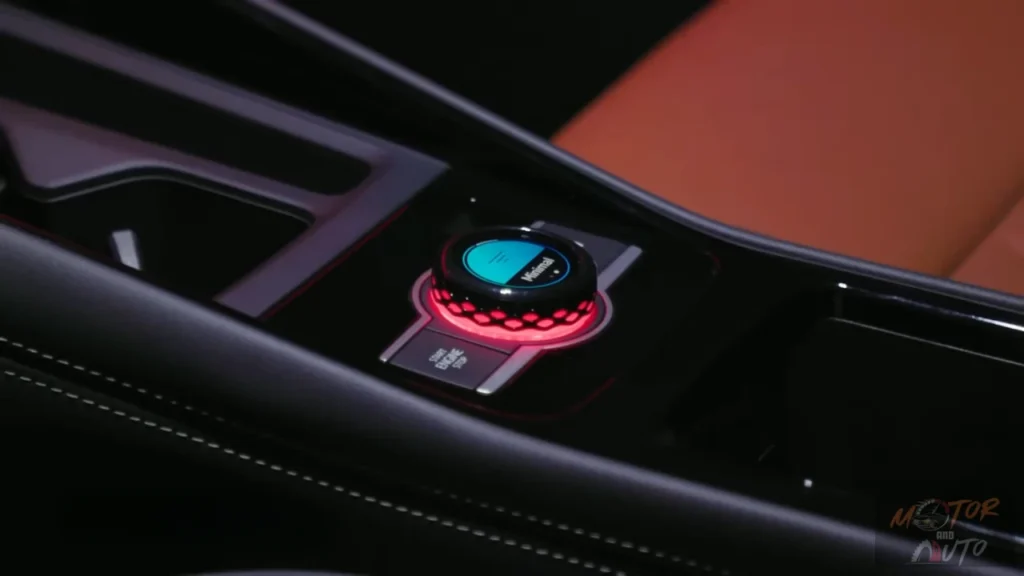
The 2025 Tiguan brings in a level of luxury that you usually only see in high-end cars, but at a price that’s way more accessible. Volkswagen has made it clear that they’re all about keeping passengers comfy in every seat, and they’ve put some serious thought into the advanced seat technologies. It’s what gives this SUV an edge over its competitors.
Take the front seats, for instance. They’re really well designed. You get eight-way power adjustments even in the mid-level trims, and if you go for the top-of-the-line SEL R-Line, you’ll enjoy four-way lumbar support too. But the real game changer is the massage feature! It uses pneumatic chambers in both the cushions and backrests to offer a range of massage programs with adjustable intensity. This isn’t just some gimmicky vibration like you find in other cars; it actually feels therapeutic, especially on those long road trips.
About seat heating and ventilation – They do a great job across the board. The heating warms up quickly and keeps things cozy without turning your seat into a furnace. The ventilation gets enough air moving through the perforated leather to cool you down without making a racket like some luxury cars do. You can even run the heating, cooling, and massage functions all at once—it’s like a mini spa on wheels!
The climate control system is another highlight. It’s got dual-zone automatic operation as standard, which is super handy, and expanding to tri-zone on the top trim level. It reacts quickly to your adjustments and keeps the temperature steady without that annoying hunting around that some automatic systems can have.
Now, storage in the Tiguan is pretty thoughtful. The center console has adjustable compartments, and there’s even a wireless charging pad that fits larger smartphones while keeping them cool. Plus, there are USB-C ports placed conveniently throughout the cabin, so everyone can stay connected without a mess of cables.
The power liftgate is another feature that works smoothly, except on the base trim. If you opt for the higher trims, you get the hands-free operation, which is a lifesaver when you’ve got your hands full with groceries. You can even program the opening height for low garage ceilings, preventing any mishaps. And, just in case, there are manual backup controls if the electronic systems ever act up.
When it comes to lighting, the Tiguan doesn’t skimp. It goes beyond the basics with sophisticated ambient lighting that you can customize through the infotainment system. This lighting works with the “atmosphere” settings to set the mood and even adjusts the audio parameters. It’s all about creating an immersive experience that feels premium. Plus, there are reading lights for everyone, so you can see what you’re doing without bothering your fellow passengers.
Oh, and let’s not forget the panoramic sunroof that comes with the higher trims. It opens up a big chunk of the roof, making the cabin feel super spacious. The electric sunshade works seamlessly and covers everything when it’s closed, which is great for those bright sunny days. And if you just want a bit of fresh air, the tilt function lets you ventilate without all that wind noise you usually get when it’s fully open. Pretty neat, right?
The 2025 Tiguan really steps up its game when it comes to technology, and you can see that Volkswagen has put a lot of thought into its new MIB4 infotainment platform. It’s a big improvement, for sure! This system is way faster and easier to use than what we saw in earlier versions. You know how frustrating it can be when you’re trying to navigate through a menu and it just lags. Well, that’s not a problem here. The interface is designed to be super clear and user-friendly, with big icons and a logical layout that helps keep distractions to a minimum while you’re driving.
Here’s a nice perk: Wireless Apple CarPlay and Android Auto come standard on all trims. That’s pretty awesome because many competitors charge extra for that kind of thing. The connectivity is solid, too, so you can count on it to stay connected even during longer drives. Plus, that big 15-inch display on the top trim is a total game changer for navigation and media—it’s got great visibility. Oh, and don’t forget the wireless charging pad, which offers fast 15-watt charging and even has cooling to prevent it from overheating.
Moving on to the digital instrument cluster, it boasts a 10.25-inch display that’s all about customization. You can switch between traditional gauges or a more modern look, depending on what you prefer. It’s nice because it makes it easy to keep your eyes on the road while getting turn-by-turn directions directly in your line of sight.
If you opt for the SE R-Line Black trim, you get the head-up display technology, which projects useful info right onto the windshield. Think speed, navigation directions, and safety alerts—all without needing to glance away from the road. The image quality is sharp, and it adjusts automatically for different lighting. Just a heads-up, though: some folks might need to tweak their seating position a bit to see it perfectly.
When it comes to audio, there’s a noticeable difference across the trims. The base model has a decent seven-speaker system, but if you go for the top trim, you’ll find a premium 12-speaker Harman Kardon setup that sounds incredible. Seriously, the clarity and bass response are impressive, and the 700-watt amplifier can handle highway driving without any distortion.
Now, let’s talk about that multi-function control knob. It’s a neat design, serving as both a volume control and a navigation device for different driving modes and atmosphere settings. The proximity sensors light up the display when you get close, and you get this nice haptic feedback that lets you know your input was registered. Sure, it might take a little getting used to, but it ends up being pretty intuitive, reducing the need to tap the touchscreen all the time.
Voice control has come a long way, too. It’s got natural language processing that can pick up on casual commands for things like climate and media. It responds well to clear instructions and gives audio feedback when it carries out your requests. It might not be as fancy as what you see in some luxury brands, but it’s definitely functional for hands-free operation.
Finally, the “atmosphere” settings really stand out. They blend lighting, audio, and climate to create different vibes in the cabin. You can adjust the ambient lights, tweak the audio settings, and even control the climate to fit your mood. It might sound a bit gimmicky, but it can actually make your daily commute way more enjoyable or amp up the fun for weekend drives.
Safety and Security:
Safety is a big deal in the 2025 Tiguan. Volkswagen really puts a lot of emphasis on this aspect by offering a whole range of active and passive safety features as standard across all its trim levels. It’s pretty impressive when you think about it—while other brands often save these advanced systems for their higher trims or pricey add-ons, the Tiguan gives you that peace of mind without breaking the bank.
At the heart of this safety setup is Volkswagen’s IQ.Drive technology. This includes things like automatic emergency braking that can detect pedestrians, lane-keeping assist, adaptive cruise control that can stop and go, and blind spot monitoring with rear cross-traffic alerts. These systems work seamlessly—providing help when you need it without being too pushy or aggressive. It just feels right for American roads.
Now, one standout feature is Travel Assist. It’s a semi-automated driving aid that keeps you in your lane and maintains a safe distance from the car in front with very little driver input. It’s not fully autonomous, but it does take a load off during long highway drives, giving you a bit of extra safety if your attention drifts for a moment. Just remember, it does need you to occasionally touch the steering wheel to keep you engaged. It’s a good balance of support without letting you completely zone out.
The airbag system has also been updated significantly. You’ll find dual-stage front airbags, plus side-impact airbags for those up front, and full-length side curtain airbags for everyone. There’s even a knee airbag for the driver and a rear side-impact airbag, which means you’re covered in more scenarios than just a head-on collision. The way the airbags deploy also takes into account how big you are and where you’re sitting, which really helps in reducing injury risk.
Structurally, the Tiguan benefits from the MQB Evo platform, which uses high-strength steel and has energy absorption zones built in. This setup has performed really well in crash tests overseas, and we’re hopeful for similar results when the IIHS and NHTSA put it through their paces here in the States. The design features side-impact beams and crumple zones that direct crash energy away from passengers, which is super important.
About the lighting: The optional matrix LED headlights really improve visibility at night compared to regular ones. They can dim certain parts of the beam to avoid blinding other drivers, while still lighting up the road ahead. The automatic high-beam feature switches smoothly, so you don’t have to worry about fiddling with it.
When it comes to parking, the Tiguan doesn’t skimp. You get standard front and rear parking sensors, plus a 360-degree camera system if you opt for the higher trims. This surround-view camera gives you clear images and helpful lines to guide you, making it way easier to squeeze into tight spots. The park assist feature can even parallel park for you with minimal input, though, fair warning, it might take a bit of practice to get the hang of it.
On the security front, there’s an engine immobilizer and perimeter alarm that come standard, with fancier features available in the higher trims. Plus, the VW Car-Net system offers five years of safety and security services, including automatic crash notifications, emergency assistance, and vehicle tracking. These extras can provide real peace of mind for families, especially in emergencies or if your car ever gets stolen.
On the Road with the Volkswagen Tiguan:
The driving experience of the 2025 Tiguan is a big step up from the previous model, which, let’s be honest, was a bit bland. This new version is engaging and refined, really setting itself apart from what you’d typically expect from a mainstream SUV. With its boost in power, lighter weight, and better chassis tuning, it feels a lot more premium and fun to drive than you might think. After putting it through its paces on all sorts of roads, we found it to be surprisingly capable and enjoyable—definitely something that should appeal to car enthusiasts while still being friendly for everyday buyers.
When you take off from a standstill, you can really feel that extra power and lighter build at work. The turbocharged engine gives a solid push once the turbo kicks in. Sure, there’s a little lag at the very start, but once it gets going, the power delivery feels smooth and steady as the engine hits its sweet spot. The eight-speed automatic transmission really plays nicely with the engine, shifting quickly when you need more power and keeping the right gear no matter what kind of driving you’re doing.
On the highway, the Tiguan shines as a comfortable cruiser. Its suspension does a great job of soaking up bumps and imperfections while keeping everything under control. The steering feels just right for laid-back driving, even if it might not give the kind of feedback that driving purists crave. Wind noise is kept to a minimum at higher speeds, making for a peaceful cabin that’s perfect for longer trips. Plus, the adaptive cruise control works smoothly, managing distances without the jarring movements you sometimes find in competitors.
Taking it on mountain roads really shows off the improvements in the chassis. The Tiguan handles itself surprisingly well, even on tough terrain. The suspension keeps body roll in check while ensuring the tires stay glued to the road, which makes for confident handling that invites a more spirited driving style. The all-wheel-drive system distributes torque seamlessly, giving you balanced handling without the understeer you might find in other front-drive-based AWD systems.
The drive mode selection is another neat feature, offering real differences in how the vehicle feels. Comfort mode is all about a smooth ride and better fuel efficiency, while Sport mode sharpens up the throttle response and transmission. Then there’s the Individual mode, which lets you tweak specific settings to tailor the driving experience to your liking. If you opt for the higher trims, the adaptive damping system makes a noticeable difference between modes, really changing the vehicle’s character.
Braking performance is solid too, with a nice, linear feel at the pedal and impressive resistance to fade during those tough mountain drives. The brake assist kicks in during emergencies, helping to shorten stopping distances when you need it most. And the electronic parking brake? It works smoothly and even has an automatic hold feature that’s super useful in stop-and-go traffic or when you’re starting on a hill.
As for sound quality, it varies a bit depending on the trim and driving conditions, but overall, the Tiguan does a good job of keeping things refined inside. The engine sound gets more noticeable when you accelerate, but isn’t intrusive or annoying. Tire noise can change quite a bit based on the wheel size—those 20-inch wheels do tend to let in more road noise compared to the smaller ones. Thankfully, the available premium audio system does a good job of drowning out that noise during regular driving.
And here’s something to get excited about: there’s a 268-horsepower turbo variant on the way! This could really up the game, turning the Tiguan into a compact SUV that could compete with some dedicated performance vehicles. Early reports suggest it could hit 0-60 mph in around 6.5 seconds, which is impressive by any measure. With its refined chassis and upscale interior, this model might just give luxury brands a run for their money—all while being significantly more affordable.
Volkswagen Tiguan Rear Seat Comfort
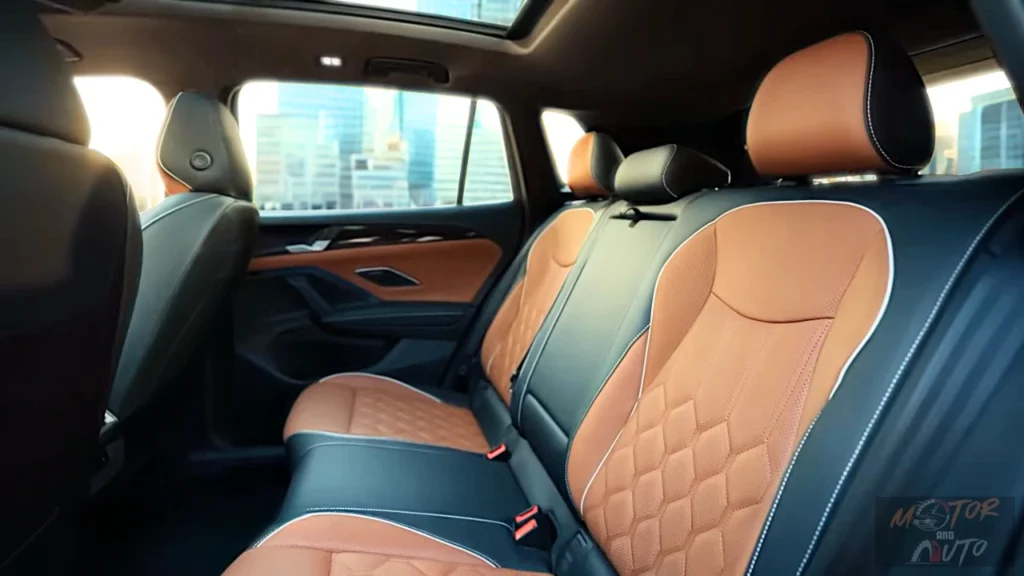
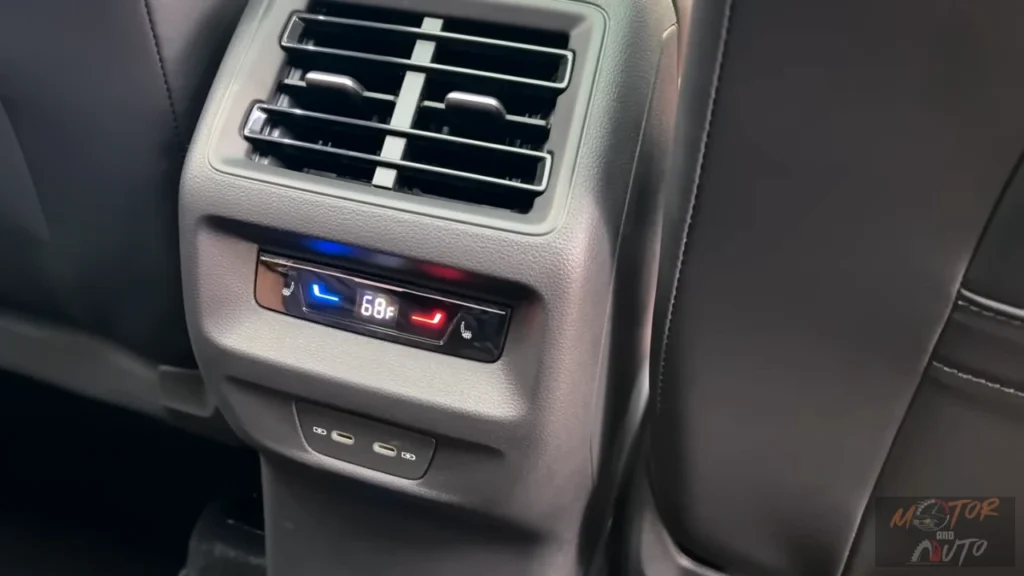
The second row of the Tiguan really shines when it comes to space and comfort. Honestly, it rivals some larger, pricier SUVs, yet it keeps those practical dimensions that make it a breeze to maneuver in the city. Even though this version is a bit shorter than the last generation, Volkswagen has managed to squeeze in an extra 1.5 inches of legroom back there. It’s a smart design, really, prioritizing passenger comfort over just making the car longer.
Speaking of legroom, we’re talking about a solid 40.2 inches here! That’s plenty of space for adult passengers, even if the front seats are pushed back for taller drivers. We mean, when we tested it with a 5’8″ driver, the people in the back had a whopping 9 inches of extra knee room. That’s a game changer for long trips, right? Plus, there’s enough room to slide your feet under the front seats, which really adds to the spacious feel on those extended drives.
Headroom is just as good, measuring 38.4 inches. Even with the optional panoramic sunroof, taller folks won’t feel cramped. The lower roofline compared to the previous model isn’t an issue, thanks to smart seat positioning and floor design. Sure, the seat backs don’t recline, but the angle they’re set at is comfy for most people—not too stiff, not too laid back.
When it comes to seating comfort, the materials and design in the back are just as thoughtful as what you’ll find up front. If you opt for the higher trims, those leather-appointed surfaces really make a difference. The cushions provide just the right amount of thigh support without feeling too hard, and the backrests give decent lumbar support to keep fatigue at bay on longer journeys. It’s designed to fit passengers of all shapes and sizes without feeling cramped or overly spacious.
Now, onto climate control. The top SEL R-Line trim offers dedicated vents and a third zone for temperature control, so folks in the back can adjust things to their liking, completely independent of those up front. On chilly days, heated rear seats are a nice touch too. And don’t worry about staying charged up; there are two USB-C ports available for all passengers to keep their devices powered throughout the ride.
Storage solutions include map pockets behind each front seat, though the quality feels less premium than the front cabin materials. Door panel storage proves adequate for bottles and small items, while the fold-down center armrest reveals cup holders and a small storage tray. The door panels feature the same ambient lighting found in front positions, creating a cohesive lighting environment throughout the cabin during evening hours.
The 60/40 split-folding rear seats are super easy to operate, with releases in the cargo area and on the seat backs. When you fold them down, they create a pretty flat load floor, although there’s a tiny step up from the cargo area to the seats. They lock in place nicely too, so no rattling around when you hit those bumpy roads.
Getting in and out is a breeze, thanks to nicely sized door openings and a reasonable height for stepping in. The doors swing wide enough for child seats, making access easy for everyone, no matter their age. That said, the door handles and window switches feel a bit cheaper compared to the front, hinting at some cost-cutting that doesn’t impact how they work but does change how they feel.
If you go for the SEL R-Line trim, those heated rear seats really do elevate the comfort level, making the Tiguan stand out among its competitors. With three-zone climate control, it’s like a little slice of luxury for those riding in the back. Sure, there’s no ventilation back there, but those heated seats are a thoughtful addition for the colder months.
One thing to note—the middle seat isn’t quite as comfortable because of the transmission tunnel, which creates a noticeable hump. While two adults can sit comfortably, three can get a bit cozy, making that spot better for kids or short trips. And there’s no headrest in the middle, which isn’t great for safety, but hey, that’s pretty common in this segment.
When it comes to child seat installation, though, the Tiguan does well. The space is generous, and those LATCH anchors are easy to reach. The wide door openings and decent seat height make getting child seats in and out a lot easier than in some other options out there. Plus, the flat floor and roomy footwells mean you can fit various child seat designs without compromising comfort for those up front.
Bootspace and Practicality
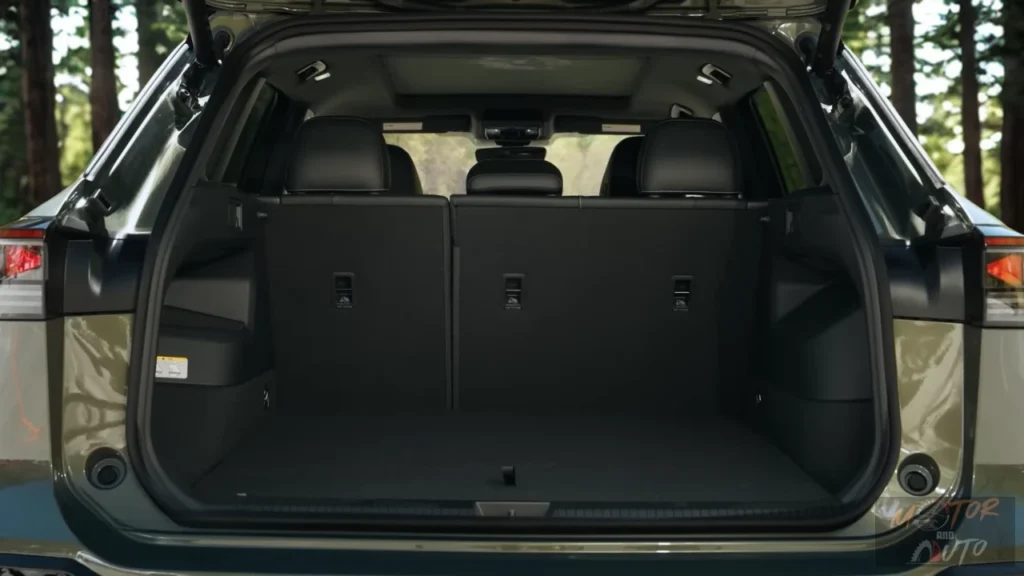
The cargo area in the 2025 Tiguan is pretty clever in how it uses space, making the most of the vehicle’s compact size. Sure, there are some trade-offs with this generation compared to the last one, but overall, it’s designed well. By getting rid of that seldom-used third row, Volkswagen has really optimized things for a typical five-passenger setup. This change also boosts the car’s structural integrity and helps keep it lighter. Based on our hands-on measurements and testing, it looks like this cargo area will meet the needs of most families when it comes to hauling stuff around.
So, what are the numbers? Officially, you’re looking at about 26.5 cubic feet of space behind the second row, which expands to a roomy 58.9 cubic feet if you fold those rear seats down. Now, these figures are a bit lower than the last generation, but honestly, it feels more spacious thanks to the better shape of the cargo area and less interference from mechanical parts. Plus, the loading floor is at a height that won’t leave you straining your back when you’re loading up those heavy bags—though it’s not as low as some of its rivals.
When you dive into the cargo area, the shape is super practical for everyday use. There’s not much in the way of wheel well intrusions, and the overall square shape makes it easy to fit in larger boxes and luggage. The width at its widest point is about 42 inches, which is nice for accommodating bulkier items, and the length ranges from 37 inches behind the second row to 73 inches when the seats are folded down. And the height goes from 15 inches at the back to around 30 inches at the highest point, which gives you plenty of vertical space for whatever you need to haul.
Now, let’s not overlook the thoughtful storage solutions in this area. You’ll find multiple tie-down points to keep loose items secure, plus side compartments for smaller things. The spare tire tucked under the floor comes with basic tools, which is a lot more practical than those competitors that just give you a tire repair kit. There’s even a 12-volt outlet back there, which is handy for powering up small devices or your camping gear.
The power liftgate works like a charm on all trims except the base model. You can even set the height, which is great if you’ve got low garage ceilings. And if you’re juggling groceries, the hands-free option on the higher trims is a lifesaver—it responds well to a kick under the bumper. Plus, if something goes wrong with the electronics, there’s a manual backup release to access the cargo area.
Loading and unloading is generally a breeze because of the reasonable liftover height and the wide opening, which lets you get into those corners easily. Folding down the rear seats is simple, thanks to releases in both the cargo area and on the seat backs, creating a flat load floor that’s perfect for longer items like lumber or sports gear. The 60/40 split folding setup means you can carry lengthy items while still having room for three passengers.
When you stack the Tiguan up against its competitors, it’s a mixed bag. It offers more cargo space than some rivals like the Mazda CX-5 and Subaru Forester, but it doesn’t quite measure up to the Honda CR-V and Toyota RAV4. That said, the shape and accessibility of the Tiguan’s cargo area often make it feel more practical than the sheer volume numbers might indicate, which is a win for everyday use. And losing that third row means you don’t have to sacrifice cargo space—unlike those seven-seaters that often give up storage for extra seating.
As for weather protection, the fitted cargo cover does a decent job. You can remove it easily if you need more vertical space, and it keeps your cargo hidden from sight. Just keep in mind, it does cut down on height for taller items. The LED lights in the cargo area are placed to help reduce shadows when it’s dark out, but honestly, a few more lights in the corners wouldn’t hurt.
Lastly, the underfloor storage is home to the spare tire and some basic tools, plus it gives you extra space for emergency gear or anything you want to keep secure while driving. It’s a handy little spot for stashing valuables out of sight, although it’s somewhat limited by the size of the spare tire. They even included a removable divider to help organize smaller items and keep them from shifting around while you’re on the road.
The 2025 Volkswagen Tiguan Value Proposition: Is It Worth the Price?
The 2025 Volkswagen Tiguan really shakes things up in the compact SUV market. It challenges the usual ideas about what separates mainstream models from premium ones. Here, you’ve got a vehicle that offers luxury-like features and a touch of refinement, all at prices that still sit comfortably with well-equipped mainstream rivals. After checking out various trims and putting it through its paces, it’s clear that Volkswagen has crafted a truly premium product. It’s like a “budget Audi” that still appeals to loyal Tiguan fans.
Let’s talk about the pricing: The base S trim kicks off at $30,920, which is pretty reasonable and includes essential features and solid build quality. This model competes head-to-head with mainstream options. But, honestly, the real magic happens in the higher trims. That’s where you get massaging seats, top-notch audio systems, adaptive lighting, and all the tech that would cost a pretty penny from luxury brands. The top-tier SEL R-Line, priced at $41,180, still beats out similar luxury competitors by a cool $5,000 to $10,000. So, if you’re after luxury features without breaking the bank, this is definitely worth a look.
When we compare the Tiguan to rivals like the Toyota RAV4 Hybrid or Honda CR-V Hybrid, it doesn’t quite match up in fuel efficiency. But here’s the kicker: it offers a more refined driving experience, with better quality materials and a level of sophistication that makes it stand out. The handling is engaging, almost on par with some European luxury SUVs. And the interior is a step above what you’d expect in this price range, giving you that premium feel.
The feature set is pretty impressive too. Unlike many competitors that require pricey option packages to match the Tiguan’s features, this SUV comes standard with things like wireless Apple CarPlay and Android Auto, full LED lighting, heated seats, and robust safety systems across the board. And if you opt for higher trims, you’ll find perks like massaging seats and premium audio that are hard to come by elsewhere.
When it comes to long-term ownership, the Tiguan shines in a few key areas. Its build quality and material durability seem poised to outlast your average mainstream competitor. Plus, with a solid warranty and included maintenance, you can drive with peace of mind. Sure, Volkswagen’s reliability isn’t quite on the same level as Toyota or Honda, but the engineering and materials in this generation feel like they might hold up better than before.
Looking ahead, there’s also a turbo variant with 268 horsepower coming in 2026, which should add some real performance chops. This could give luxury models like the BMW X3 or Audi Q3 a run for their money, and it’s expected to be priced in the mid-$40,000 range — still a steal compared to those luxury options.
Now, if you’re in the market, consider your priorities. The Tiguan is perfect for folks who want refinement and features, maybe even more than they care about top-notch reliability or fuel efficiency. If you’re coming from a luxury brand, you’ll likely appreciate the quality here. On the flip side, if you’re upgrading from a more mainstream vehicle, be ready to be impressed by the sophistication and overall driving experience. It’s great for those who want those premium touches without the typical luxury car headaches.
But let’s be real, there are some downsides to keep in mind. While the fuel economy has improved from the last generation, it still lags behind hybrids. If efficiency is your top priority—especially for city driving—you might want to explore other options. And yes, Volkswagen’s reliability is getting better, but it’s not yet on par with the rock-solid dependability of Toyota or Honda.
Also, the absence of hybrid options at launch is a bit of a drawback, especially since the market is leaning more towards electrification. Volkswagen has promised hybrids are coming, but if you’re looking for top fuel efficiency right now, you’ll have to look elsewhere.
When it comes to resale value, the Tiguan should hold its own reasonably well, though probably not as strongly as its Toyota or Honda competitors. Still, the premium features and build quality could help it retain value better than past Volkswagen models. If you plan to keep your vehicle for the long haul, those premium touches will be a big plus.
Ultimately, your choice will hinge on what you prioritize. If reliability and fuel efficiency are your top concerns, the Toyota RAV4 Hybrid or Honda CR-V Hybrid might be better bets, even if they don’t offer the same level of refinement and features. But if you’re all about driving experience and interior quality, the Tiguan is an exceptional value that’s hard to beat.
You know, if you’re looking at the Tiguan lineup, the SE R-Line Black trim really seems to hit the sweet spot. It comes packed with a lot of great features — think head-up display, panoramic sunroof, and some sharp-looking premium wheels. And the best part is that it’s priced so that it stays competitive with other well-equipped options out there. For most folks, this trim offers the best mix of features and value. Now, if you’re after that top-tier luxury experience, you might want to check out the SEL R-Line, but yeah, it does come with a heftier price tag.
Looking ahead, the real test for the Tiguan will be how well it can execute on quality and long-term reliability. If Volkswagen can really deliver on that promise of better durability while keeping that premium feel, the Tiguan could snag a nice slice of the market — both from mainstream and luxury brands. But, here’s the catch: if they run into any major reliability issues, that could really hurt their value proposition and mess up their plans to move upmarket.
In wrapping things up, the 2025 Volkswagen Tiguan is quite the achievement! It’s really taken the brand’s compact SUV game to a whole new level, stepping into that premium territory while still keeping prices competitive. With its smart engineering, high-quality materials, and cutting-edge features, it stands out as a solid choice for anyone in the compact SUV market looking for a blend of style and value. Definitely worth a look, don’t you think?


